

THE CHANGE ISSUE
INTRODUCING DR. NONI THOMAS LÓPEZ, OUR 12TH HEAD OF SCHOOL JOHN RANKIN REFLECTS ON FOUR DECADES IN INDEPENDENT SCHOOL EDUCATION MAKING IT HAPPEN: STUDENTS REVIVE THE HEALTH INTERNS PROGRAM
CULTIVATING MIND, BODY & CRAFT: A TRIFECTA OF POLY EXCELLENCE
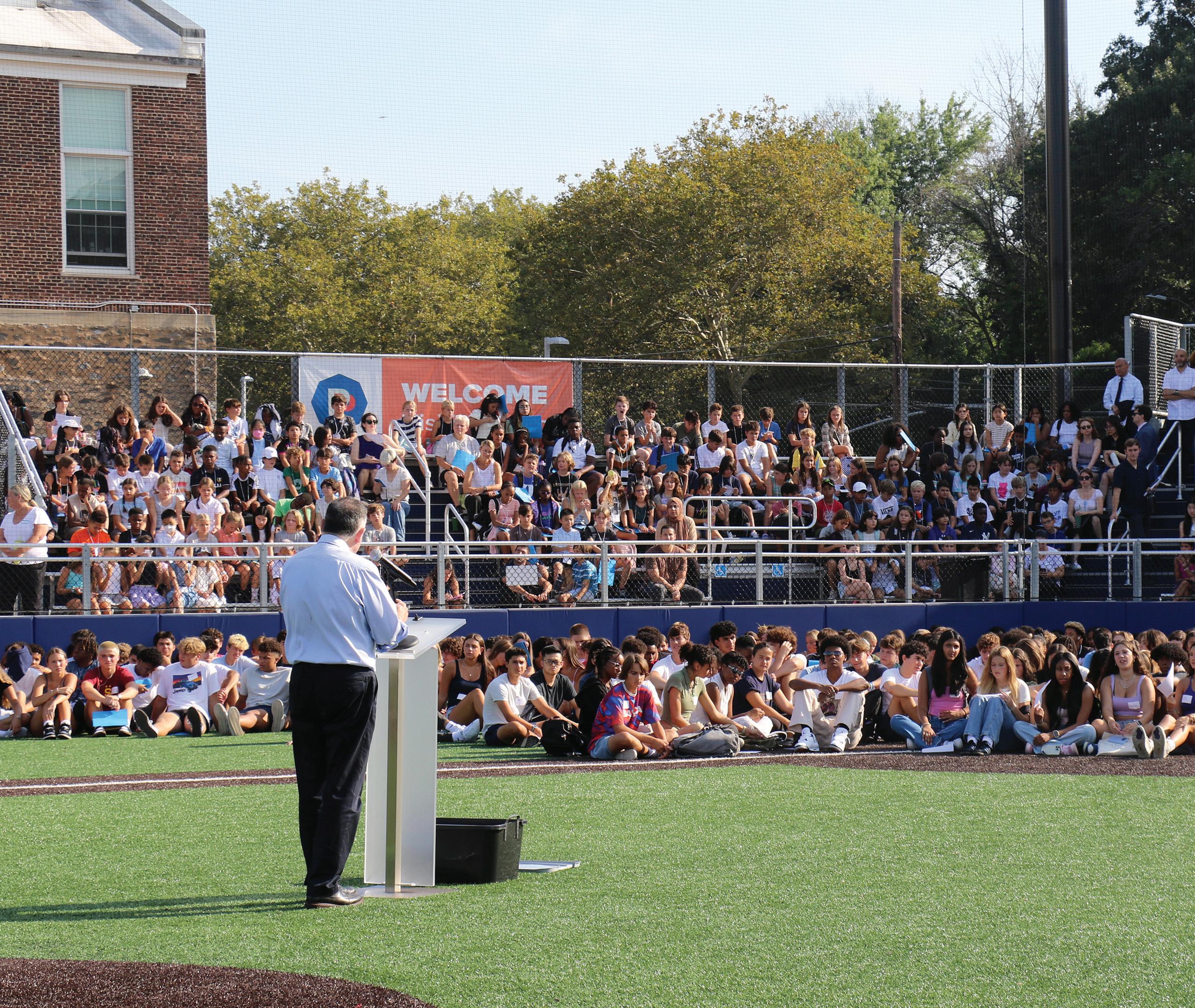

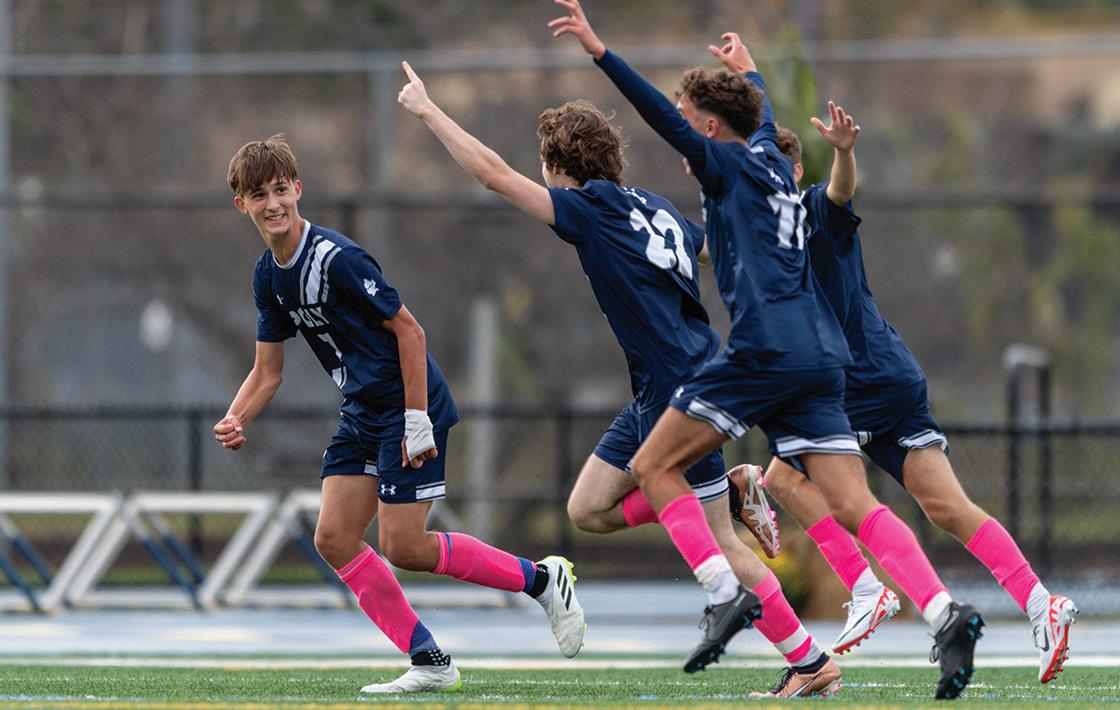
LOWER SCHOOL
50 Prospect Park West
Brooklyn, NY 11215
MIDDLE AND UPPER SCHOOLS
1 Poly Prep Drive
Brooklyn, NY 11228
IMAGES BOTTOM LEFT TO RIGHT:
The Class of 2018 health interns raise awareness for breast cancer research; John Rankin welcomes students to the Dyker Heights campus on the first day of school in September 2024; Athlete and actor Diego Garcia Phillips ’25 celebrates with soccer teammates following their win over Dalton during Homecoming 2024; Julia Menziuso ’18 and Ellen Gaffney ’18 prep during a debate competition.
ON THE COVER:
Photo by Alex Basham ’26
BOARD OF TRUSTEES 2024–2025
OFFICERS
Andrew Foote P’27, ’29
Chair
Laurie T. Rosenblatt P’23, ’26
Vice Chair
Kareem Raymond P’31, ’33
Treasurer
Jennifer Powers P’26, ’28
Secretary
TRUSTEES
Indhira Arrington P’29, ’31
Michael A. Correra ’87
Jennifer Fell P’30
John Foley P’26, ’30
Hans Humes P’12, ’15, ’21, ’35
Jonathan Krasner ’95, P’30, ’32
Michael Liburd P’21
Yolonda Marshall P’24, ’26
John D. McPheters P’33
Sarah Peasall P’28, ’30
Elizabeth Schlessinger P’28, ’30, ’32
Stephanie Taendler P’25, ’28
Daniela Vitale-Howell P’20, ’23, ’25
Maxwell T. Wiley P’18, ’21
BOARD MEMBER, NON-TRUSTEE
Ayisha McHugh Nelson ’12 (Pres. Alumni Board of Governors)
TRUSTEES EMERITI
Dr. Karen Burke Goulandris P’15
Harry J. Petchesky, Esq. ’55


THE BLUE & THE GRAY is published by Poly’s Engagement & Communications Office. It features news from the Poly community of alumni, faculty, and students. Inquiries and submissions are welcome. Contact communications@polyprep.org.
For more information about Poly Prep, visit polyprep.org.
4 Cultivating Mind, Body, and Craft: Poly Prep’s Path to Excellence
Poly Prep’s evolution from classical academia to athletic powerhouse has fully entered its latest chapter, embracing artistic growth.
12 Change Worth Making: How We Revived Health Interns
Reese Roaman ’25 chronicles the successful campaign to bring back Health Interns after a five-year hiatus, honoring a beloved teacher’s legacy.
14 The View From Here: Four Decades in Independent School Education
From English teacher to head of school, John Rankin reflects on teaching approaches, expanded student support systems, and Poly’s unique community spirit.
20 Getting to Know Dr. Noni Thomas López, Poly’s 12th Head of School
Meet Dr. Noni Thomas López, whose leadership approach and passion for student-centered learning will guide Poly into its next chapter.
24 Speaking Through Reinvention: Poly’s Debate Team Across Generations
Poly’s debate team reinvents itself yet again, embracing Policy Debate and celebrating tournament victories while building on 150 years of forensic tradition.
27 The Junior Persuaders: How Third Graders Learn the Art of Debate
In Lower School, students learn how to change minds through environmental debates, mentored by Upper School students in a powerful cross-campus connection.
40 Legacy in Focus: The Marrus Family’s Gift to a Poly Arts Education
Andrew Marrus reflects on honoring his father’s artistic passion through advanced photography facilities for Poly students.
48 The Last Word: An Agent of Change
Lucia Zaremba ’25 proves age is no barrier as she successfully championed life-saving EpiPen access for all New Yorkers.
EDITOR-IN-CHIEF
Jennifer Slomack
FEATURE WRITERS
Sasha Londoner ’27
Andrew Marrus
Reese Roaman ’25
Jennifer Slomack
Amanda Volel
Brandon Willabus ’27
COPYEDITOR
Michael Harrington
PHOTOGRAPHY
Poly Prep Archives
Linda Busetti
William Rosario P’31, ’35
Rob Tringali
Nancy Zaremba
MAGAZINE DESIGN
Joseph Inglis

DEAR POLY COMMUNITY,
As you turn these pages, you will notice a unifying thread: the delicate and deliberate balance between honoring tradition and embracing thoughtful change.
This issue opens with a feature by Sasha Londoner ’27 and Brandon Willabus ’27, who chart Poly’s remarkable evolution—from its distinguished academic beginnings, to its emergence as a powerhouse in athletics, and now into a new era of creative growth. Their story celebrates a school that has become a true “triple threat,” where the arts now thrive with the same intensity as scholarship and sport, redefining what excellence looks like at Poly.
Reese Roaman ’25 next shares a revival of the Poly Health Interns program, a peer leadership initiative founded in 1997 by our late Health Teacher Patti Tycenski Mastro (Ms. Ty). Ended in 2020 mostly due to COVID-19, the program allowed select Grade 12 student interns to engage with Grades 5 and 6 about Middle School experiences, growing up, mental health, and more. The relaunch has, again, renewed bonds between Middle and Upper School divisions—with recent sessions on general health, aerobic exercise benefits, and responsible social media usage—and Ms. Ty’s vision of impactful student mentorship.
Our commitment to both tradition and progress is perhaps nowhere clearer than in the work of our debate program. As Sasha Londoner details, Poly has long been a home for public speaking, a legacy many alumni cite as foundational to their careers. Today, the program continues to evolve, preparing students for a fast-changing world while still honoring over 150 years of forensic excellence.
This year’s edition also reminds us that meaningful change can come from every corner of the school. Lucia Zaremba ’25 , through her advocacy work, helped expand access to EpiPens in large public venues—a profound example of leadership and service beyond the classroom.
Two years ago, I was asked to step into this role while the Board of Trustees conducted a national search for new leadership. As I prepare to hand the reins to Dr. Noni Thomas López , our 12th Head of School, I do so with great confidence and optimism. Already, her approach is energizing our community and providing a glimpse of the next chapter in Poly’s story.
In reflecting on my time at Poly and four decades in independent school education, I have often returned to the insight of philosopher William James, who described America not as a fixed identity but as something always in the process of becoming—expansive, complex, and full of possibility. That vision resonates deeply here, where we continually navigate and celebrate dichotomies: tradition and innovation, analytical rigor and experiential learning, ambition and humility.
As these stories show, Poly Prep, like the country it serves, is still emerging. And that, I believe, is its unwavering strength. I am deeply grateful to have played a part in that unfolding journey.
With appreciation,

John Rankin Head of School
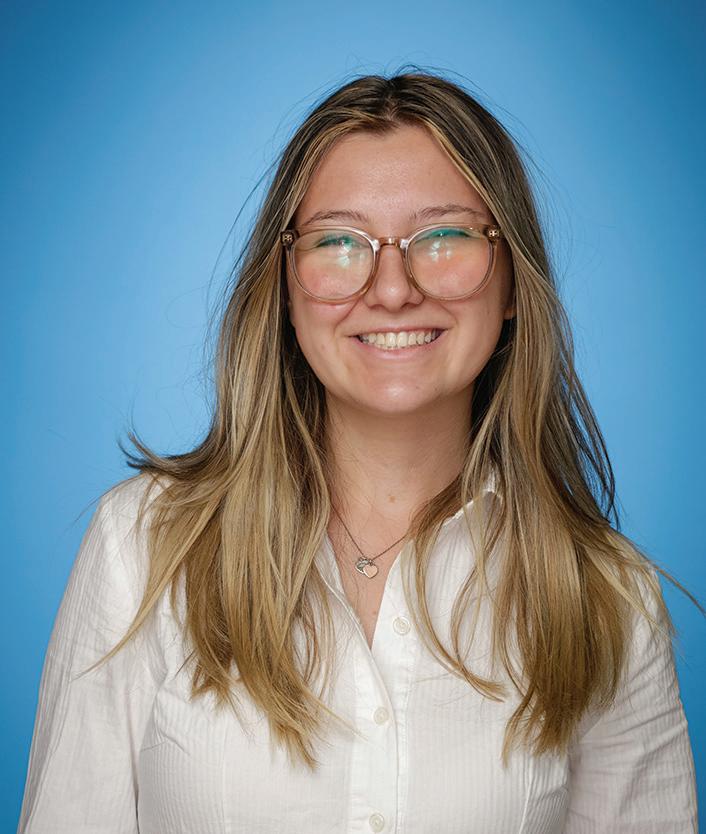
SASHA LONDONER ’27
P. 4 & 24
Sasha Londoner ’27 is the news editor for The Polygon and began working as an editorial assistant for the spring 2024 issue of The Blue & The Gray. This is her second stint, following the fall 2024 edition, as a feature writer. Sasha has debated competitively for two years, both in Public Forum and Policy. She performs as a member of Poly’s acapella group, Harmonics, and enjoys playing guitar. In the future, she looks forward to continuing her passion for journalism and serving as student managing editor for the fall 2025 issue of The Blue & The Gray.

BRANDON WILLABUS ’27
P. 4
Brandon Willabus ’27 is a staff writer for The Polygon. His favorite pieces explore Poly’s identity and its people. Beyond writing, Brandon is active in various areas of student life. He is a peer tutor, Blue Key tour guide, and vice president of Model UN, and a member of Advanced String Ensemble, Umoja Males, and the Student Service Board. He is also a proud member of Boys’ Varsity Soccer and JV Basketball. Outside of school, he enjoys supporting Manchester United and the Brooklyn Nets, playing The New York Times games, and learning new languages.

REESE ROAMAN ’25
P. 12 & 46
Reese Roaman ’25 has been at Poly Prep since second grade. She joined The Polygon in her freshman year as a writer, transitioned to sports editor, and now serves as the news editor. In her junior year, she took Advanced Journalism, which deepened her passion for profiles and research pieces. In addition to her work on the newspaper, Reese is the student government president, vice president of Model UN, co-president of the Women’s Affinity group, and co-captain of the Girls’ Varsity Tennis team. Outside of school, she enjoys spending time with her dachshund, Sherman. Reese heads to UCLA this fall.
CULTIVATING MIND, BODY, AND CRAFT:
POLY PREP’S PATH TO EXCELLE CE
By Sasha Londoner & Brandon Willabus
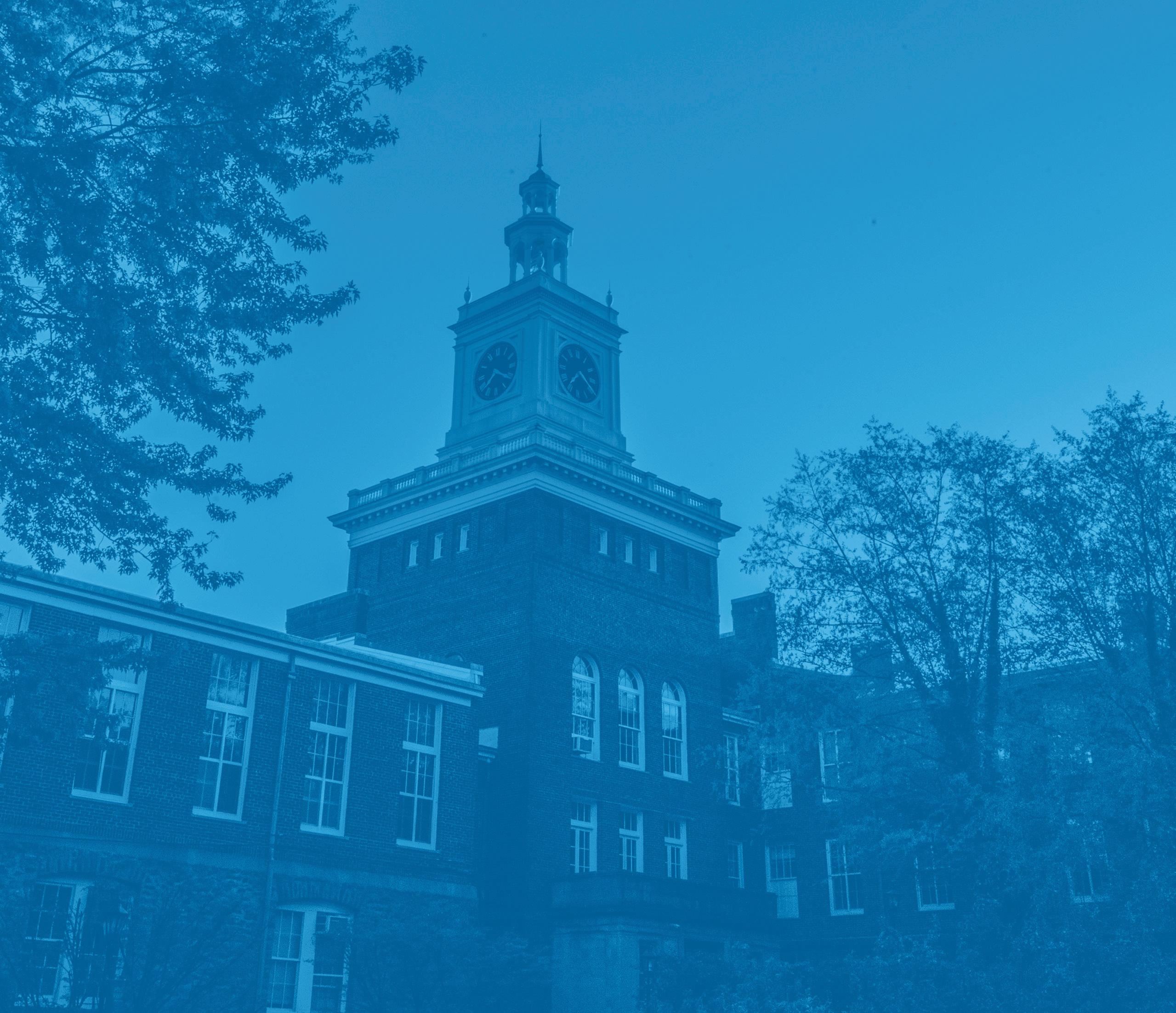
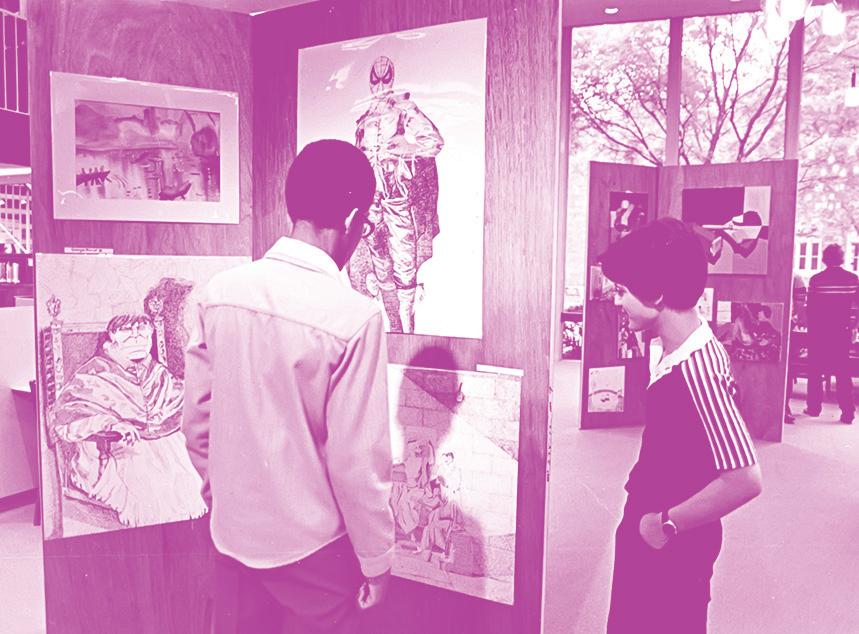
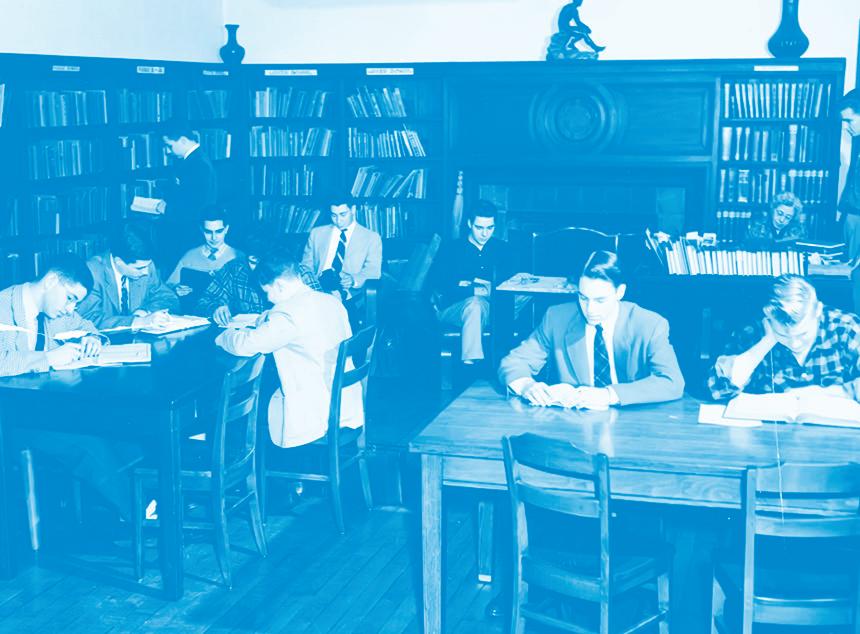



Today’s Student Center served as the first indoor gym at Dyker Heights until the 1930s.
Poly’s longstanding appreciation for the arts is evident as students view an exhibition in the Joseph Dana Allen Library, 1970s or 1980s.
Students in the 1950s demonstrate the scholarly commitment and academic focus that continues to define Poly culture.

The year was 1917, and a quiet transformation was unfolding in the heart of Dyker Heights. As Poly Prep’s newly relocated campus stretched across 25 acres of rolling green, its stately brick buildings and soaring tower stood as a testament to the school’s growing ambition. It was a far cry from the school’s more urban origin. In 1854, the Brooklyn Collegiate and Polytechnic Institute first opened its doors, to boys only, in a single building on the corner of Livingston Street in downtown Brooklyn. From its earliest days, Poly earned a reputation as a center of academic excellence rooted in a classical tradition, its identity cultivated through the scholarship of those who passed through its classrooms—generations of alumni turned accomplished thinkers, scientists, and writers. As its popularity grew, so too did the demand to accommodate a growing student body. The physical limits of the building became more and more apparent.
As the school expanded, so did its vision of becoming a country day school. With the move in 1917 to the then more rural setting in Dyker Heights came the intentional construction of sprawling athletic fields so that students could easily venture straight from their academic classrooms to engage in physical activities outdoors. In the 1930s, construction of Poly’s large gymnasium began and, as its facilities evolved, so did its reputation for competitive athletics.
Over the years, Poly Prep became synonymous with sports dominance. Its football program flourished, its baseball diamond became proving grounds for future stars, and its gym echoed with the sounds of champions in the making. Poly’s transition to coeducation in the 1970s fostered a more inclusive environment where female students excelled academically alongside their male counterparts.
On the athletic side, with only a small number of girls, many female students participated in more than one sport to help classmates field complete teams.
Why then does Poly have the reputation for being the “sports school?”
The idea that a sound body benefits the development of an intellectual mind is a philosophy Poly embraced when it moved to Dyker Heights and continues to foster today. Behind the banners and trophies that accumulated, however, the school’s academic foundation has never wavered. While the excitement of athletic competitions and rivalries captured the headlines—and imaginations of aspiring athletes—Poly’s classrooms continued to foster rigorous academics, innovative teaching, and a thriving arts program that saw its students matriculate to the country’s top universities.
Why then does Poly have the reputation for being the “sports school?” Has the idea of Poly being a “sports school” eclipsed all else? The numbers certainly support excellence in athletics with over 60 NYSAIS championships, more than 275 Ivy Prep League titles, and an impressive average: 16% of our students are recruited to play at the collegiate level compared to only about 7% of high school athletes recruited nationwide. Poly’s prowess across 15 sports is undeniable, with generations of athletes leaving their legacy, yet those within the Poly community know there is much more to the school’s identity. The arts program continues to flourish with opportunities for student performers, visual artists, and musicians. Each year, numerous students earn Scholastic Art Awards for their endeavors, and the caliber of dance, drama, and music performances on stage dazzles audiences alike. Academically, Poly has long upheld a rigorous curriculum that challenges students to think critically and creatively. So why, despite this well-rounded excellence, does the “sports school” label persist?

Jordin Walker ’25 competes at the Ocean Breeze Athletic Complex during the winter 2023–24 season.
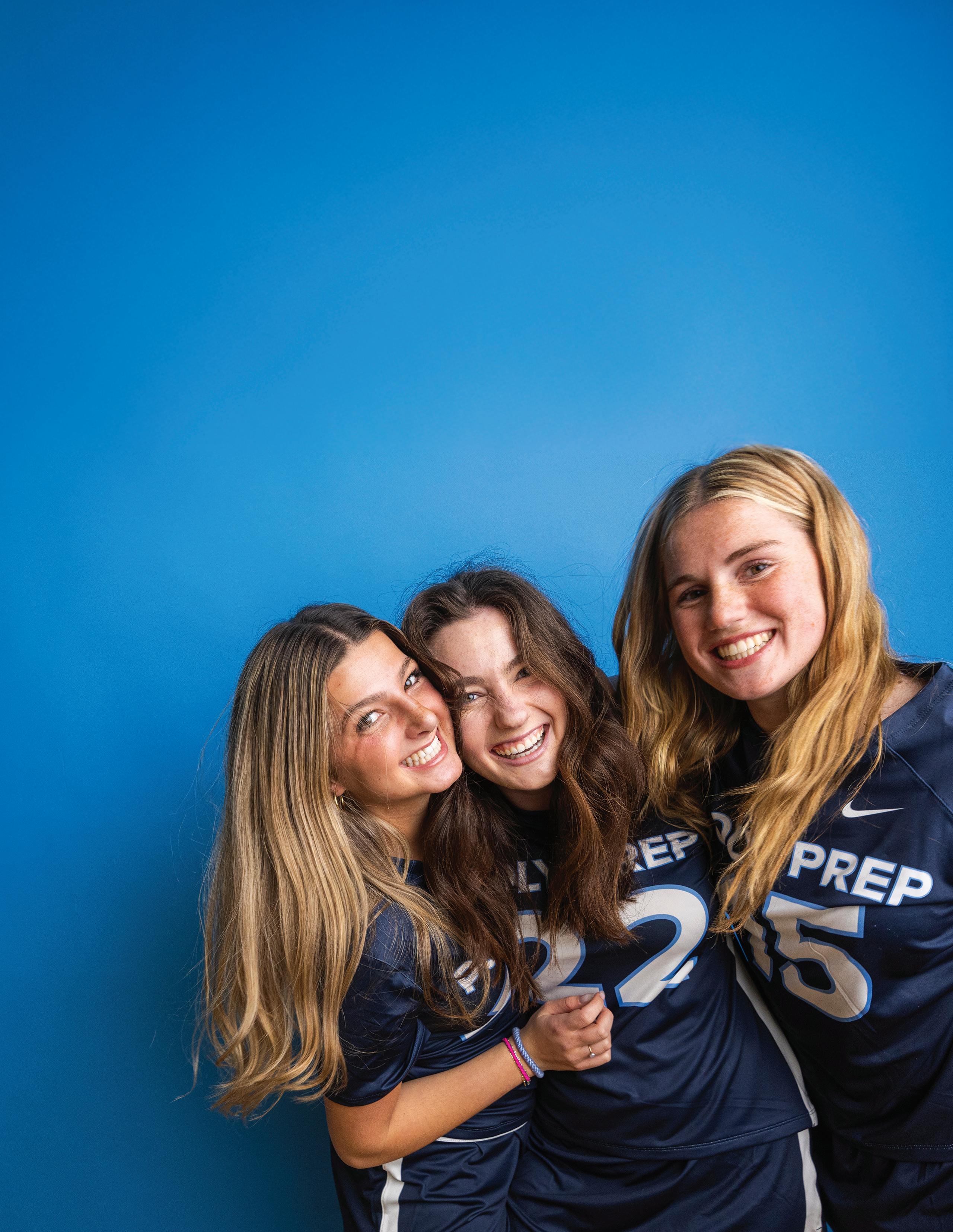
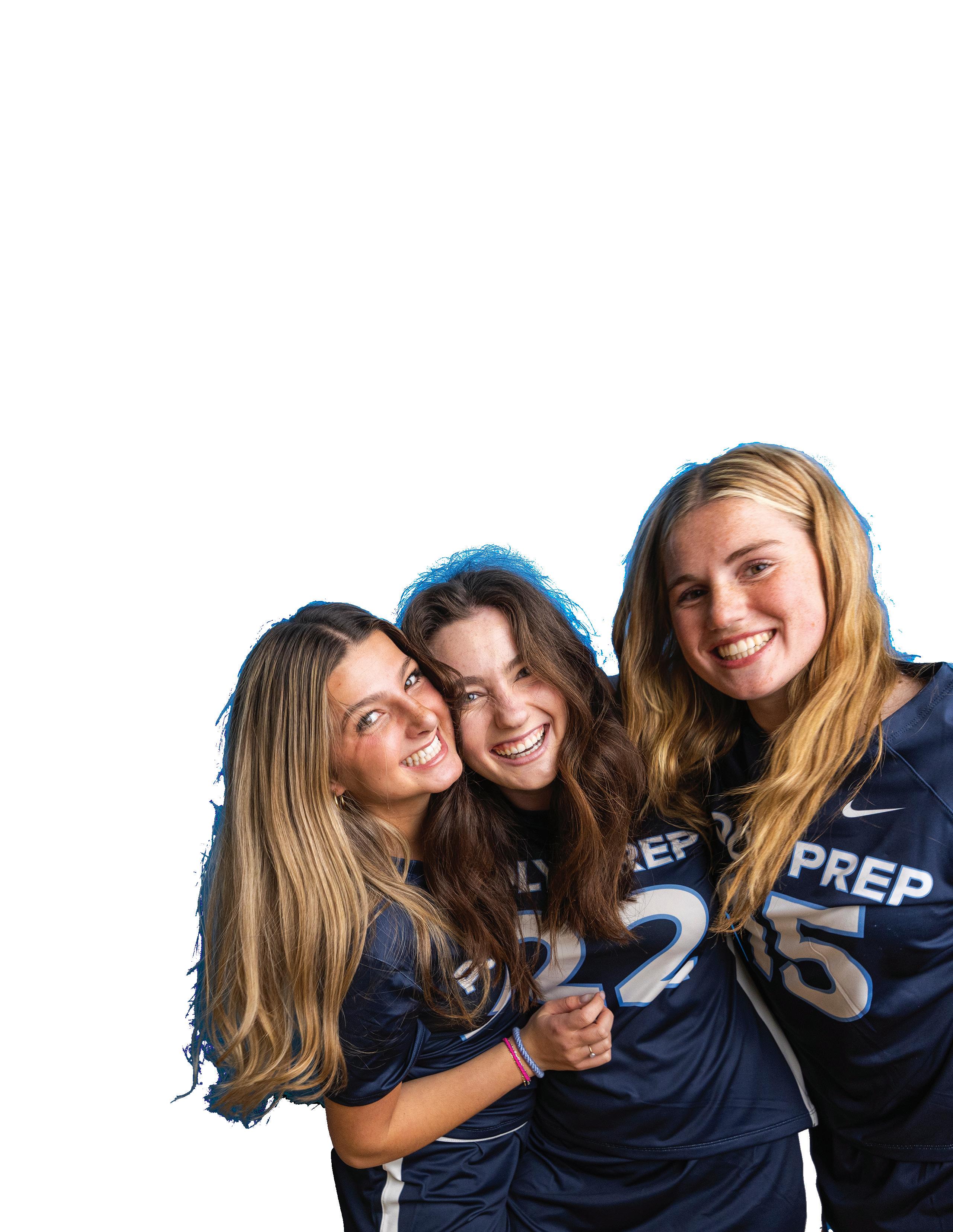
Waldman ’25, flanked by lacrosse teammates Ava Rose Vitali ’25 and Reese Roaman ’25, will each graduate with an Excellence in the Arts designation on their transcripts.
THE ACADEMICS
“Our academic program is exceptional in its breadth, depth, innovation, agility, and every other measure of learning,” said Assistant Head of School for Academics Michal Hershkovitz P’16, ’18. “Whether in our classrooms, service learning teams, curricular travel experiences, affinity groups, speaker series, science research, or the countless other ways in which our students pursue, acquire, and create knowledge, ours is one of the finest academic programs I’ve ever seen.”
Similar to arts and athletics, Poly’s academic prowess manifests itself in curricular engagement, both in and beyond school so students gain valuable skills and uncover what truly excites them. Across the board, when students leave to attend college, they are prepared because they’ve built the foundational skills they’ll need. “I adjusted pretty quickly thanks, in part, to Poly’s educational philosophy being so similar to that of liberal arts colleges,” admitted Chloe Sun ’19 in a 2021 polyprep.org interview about life at Pomona College. “Both prioritize small, discussion-based classes, which help foster student-teacher connections. In college, your teachers become research partners, advisors, and lifelong mentors. My Poly experience helped me be more comfortable in these collaborative learning environments.”
Throughout the Upper School years, the core academic program is comprised of English, mathematics, history, science, world languages, computer and information science—all with advanced level options. With the development of critical-thinking skills woven into the core curricular offerings, the program also includes courses designed to broaden health and well-being, perspective on global issues and experiences, artistic outlets, as well as nurturing empathy through service initiatives. Beyond the rigorous core studies, students have the opportunity to enroll in fascinating electives and challenging advanced classes. Poly’s required Senior Capstone project and course options such as Science Research, Astrophysics, and Cybersecurity, as well as seminar courses like Author Study of Toni Morrison, Linguistics, and Critical Theory, not only allow students to take a deeper dive into topics of interest, but also offer a window into college-level work.
Sonja Lindberg ’16 majored in computer science at MIT. “Poly prepared me well in terms of managing a busy schedule and, more importantly,” she said, “making me feel very comfortable with reaching out to professors and asking questions to actively engage in the learning process. I also found that the intense intellectual curiosity that Poly nurtured came into play when I saw parallels between the fun I had turning a problem
into an algorithm and my love of decoding the puzzles of metaphors and allegory of Chronicles of a Death Foretold in Emily Gardiner’s sophomore English class and King Lear with John Rearick.”
“After exploring software- and data-focused internships and classes,” Lindberg continued, in an interview for polyprep.org, “I found myself most interested in computer science as a language and universally applicable tool. I now use my background in tech at MIT alongside the strong logical thinking and communication skills, which Poly helped me develop, in my role at McKinsey & Company.”
Within Poly’s core curriculum, there are myriad facets and pathways students can explore in each subject, with English classes ranging from Law and Literature to studies of comics and graphic novels, and science curricula ranging from Urban Ecology to Forensic Science. Even beyond these central subjects, eight interdisciplinary studies are offered to highschoolers featuring courses like Advanced Journalism, Philosophy, and more.
Poly’s Global Studies program—the first of its kind according to World Languages Department Chair Liz Mansfield—encourages the exploration of the world and consideration of one’s place in it from an interdisciplinary, cross-cultural perspective while gaining fluency in a second (or third) language. Students engage in projects and activities derived from the United Nations Sustainable Development Goals. Upon their completion of the program, students earn the Global Studies Certificate and a notation on their transcript. In their senior year, Global Studies Language Scholars complete a research project while immersed in language study abroad and present their Senior Capstone in their target language.

Ella Lille Yerington ’24, one of Poly’s first Global Language Scholars, presents her Grade 12 Capstone in French on Emmanuel Macron’s immigration bill and its impact on immigrants, following her three-week Poly-sponsored research trip to Paris that same year.
THE ACADEMICS

If students look to expand their knowledge beyond the 190+ classes offered, they may collaborate with a teacher to create their own curriculum as a part of an independent study, where a student and teacher would work either one-on-one or in a small group to explore a unique and specific topic.
In 2023, William Ling-Regan ’24 collaborated on an independent study with History teacher Timothy Shea P’35 to study Asian-American history. When Shea approached Ling-Regan with the opportunity to develop an Asian-American history class, Ling-Regan declared, “I knew I wanted to be involved with this course however I could be. So, [in spring 2022] I met with Mr. Shea to talk about his ideas for the course and how I could get involved, and we came up with the idea of doing this independent study together.”
While most independent studies remain as small courses between teacher and student, Ling-Regan’s soon blossomed into a course available to all students, making it the first class developed by both a teacher and a student in Poly history. “One thing I’ve taken away from this independent study is how multidimensional Asian-American history is,” said Ling-Regan. “I’ve also appreciated how much Mr. Shea has allowed me to be involved in developing this course … [and] I hope that students will come away with the same sense of agency in their own learning.”
Poly’s academic strength is also reflected in robust extracurricular activities that showcase intellectual depth. With six student publications, over 90 clubs, and nationally recognized robotics, speech, and debate teams, the school has encouraged students to expand their pursuit of knowledge beyond the classroom.
As the wall of trophies in the debate room attests, “we’re one of the most successful activities at Poly,” noted Ava Barbiere ’26, who co-captains Poly’s debate team alongside her twin brother, Eric Barbiere ’26. In November 2024, the two led the team to winning the National Junior Varsity Policy Debate Tournament at the University of Michigan, and recently led three of Poly’s novice debate teams into the octafinals at the Harvard University National Tournament.
But beyond providing the twins with victories and leadership skills, Ava Barbiere testifies that debate has been a pillar of her education at Poly. “You gain so many research skills,” she said. “There are so many essays where I’ve had to do research … and doing debate has made that so much easier. You [also] just know what’s happening in the world and that’s really good for not only your classes, but just being able to talk to people too.”

History teacher Tim Shea P’35 works with William Ling-Regan ’24 on an independent study that resulted in a new Asian-American history elective.
The 2022–23 Speech and Debate team pose with a selection of their trophies at the end of the year.
THE ARTS
“It shouldn’t surprise us that [Poly students] are doing a wider menu of things,” beamed Robinson. “It could be that you’re a top wrestler and you love ceramics … and in the past, that idea was more compartmentalized. Part of that reason why we know that now is because the arts component of [Poly] has greater visibility and recognition.”
According to Waldman, there has been an increasing number of students who participate in both athletics and arts. “I’ve been at the school for a very long time and there has been a shift to push for more arts,” she said. “I’ve [also] been advocating for more athletes to join theater and vice versa … because being involved in as many different areas as you can is what allows you to figure out what you like and what you really enjoy.” Waldman found the two disciplines complemented each other. “I wouldn’t have found that [theater] was my interest unless I had played
Beyond theater, arts participation has been blossoming inside the classroom as well. In the past four years, 11 new arts courses have been introduced to Poly; the number of annual performing arts events has increased from 20 to 26; the number of students in advanced music classes have nearly doubled, growing from 55 to 100; and, “the visual arts program growth is the largest increase [at Poly] in the last seven years,” according to Robinson. This, he said, is “based on student interest and participation.”
A considerable testament to the performing arts’ appeal and recent success can be found in Koen Chen ’28, a Second Place Winner (Junior Category) in the annual Carnegie Hall auditions of the American Protégé International Piano & Strings Competition 2025. Koen receives piano instruction from Simone Ferraresi through the Poly Conservatory after-school program and he performed at Carnegie’s Weill Hall
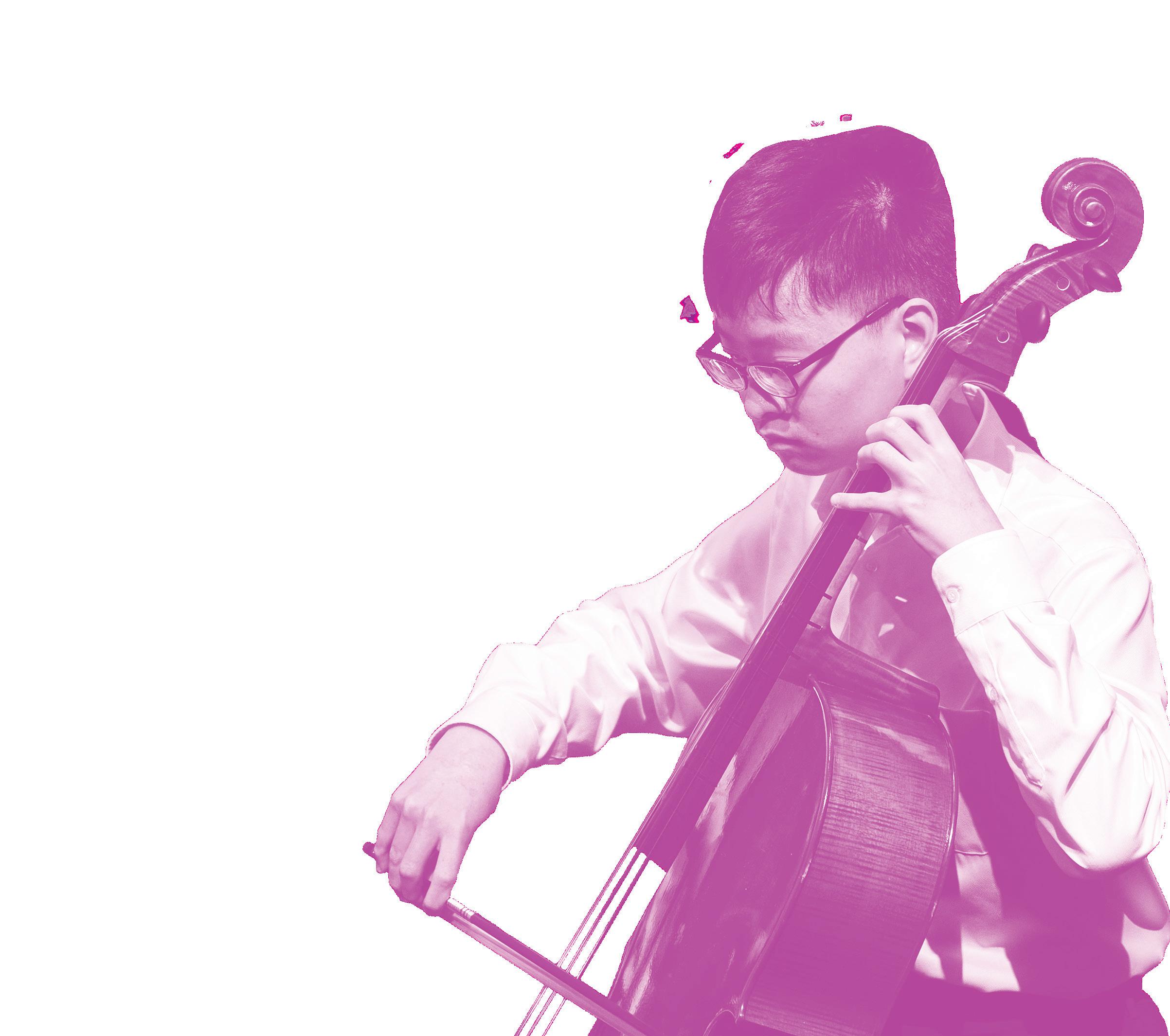
Diego Garcia Phillips ’25, Drew Waldman ’25, and Amara Johansson ’26 in She Kills Monsters, in December 2024.
Koen Chen ’28 at the Spring Instrumental Concert in April 2025.
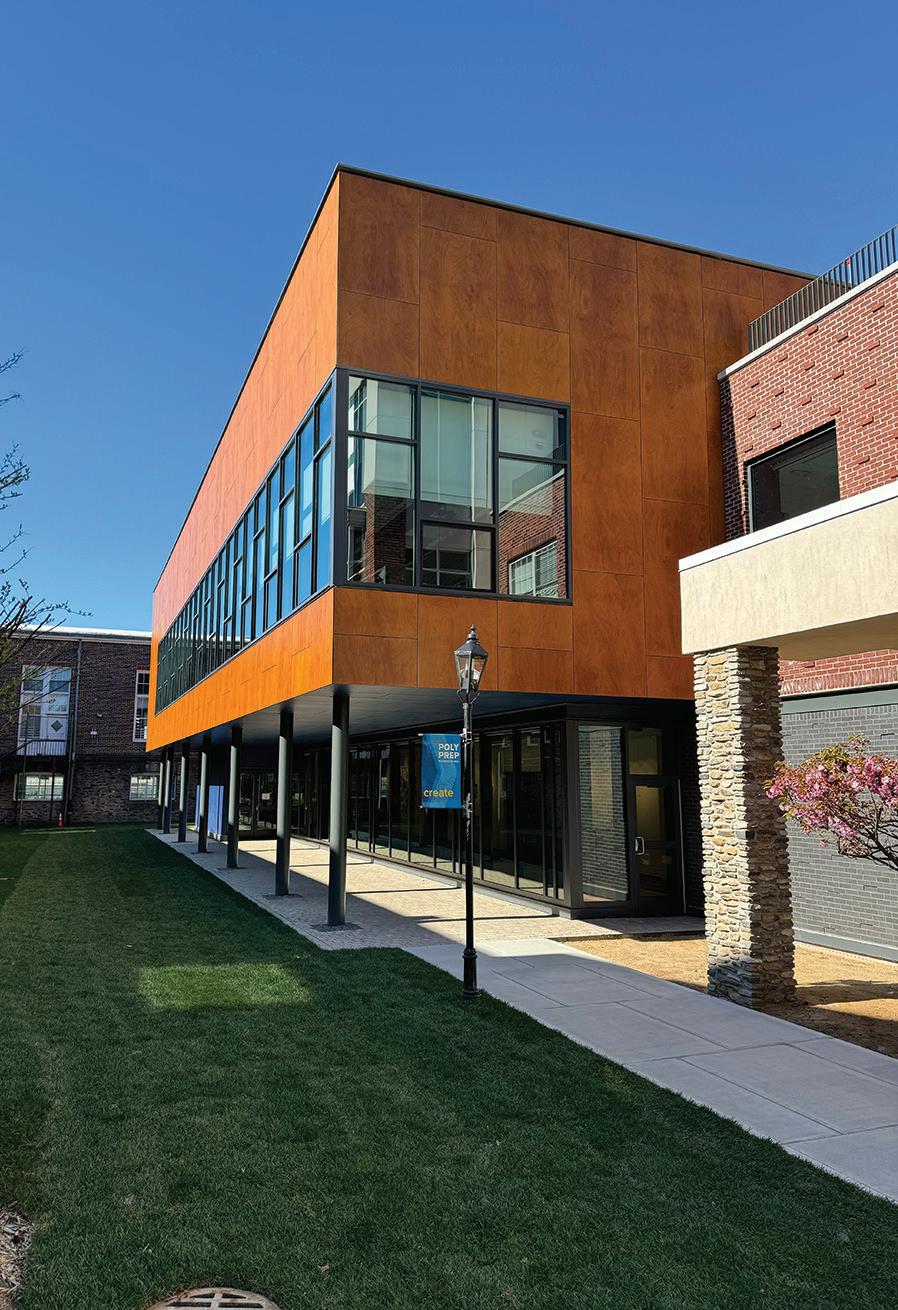
This growth is paralleled in Excellence in the Arts, a unique application-only certificate program open to students in Grades 11 and 12 who’ve shown continued strength and commitment in a facet of the arts at Poly. Introduced in 2021, the program has increased its student participation from 28 members to 81, representing more than 30% of eligible students.
From ceramics to dance, “the Excellence in the Arts program recognizes and acknowledges that many students are taking years [of art] beyond the graduation requirement,” asserted Robinson, “and allows them to work privately with arts faculty and department heads to hone their skills, prepare their portfolios, and continue pursuing their interest at Poly and into college. This is not only a way of celebrating students for the work they’re already doing, but also modeling what excellence looks like.”
In addition to increasing traction and education, Robinson shared that integrating Poly’s arts programs into curriculum rather than solely having them be extracurricular activities “enables us to have arts programming that is more directly connected to our academics,” and “meets as regularly as any other academic subject does,” a trait which distinguishes Poly from other independent schools in New York.
THE ARTS
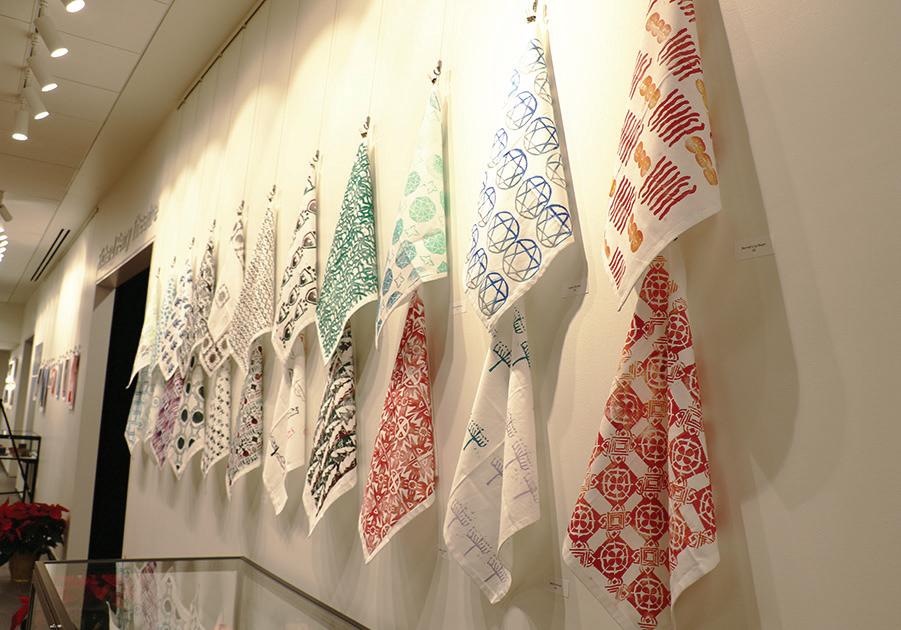
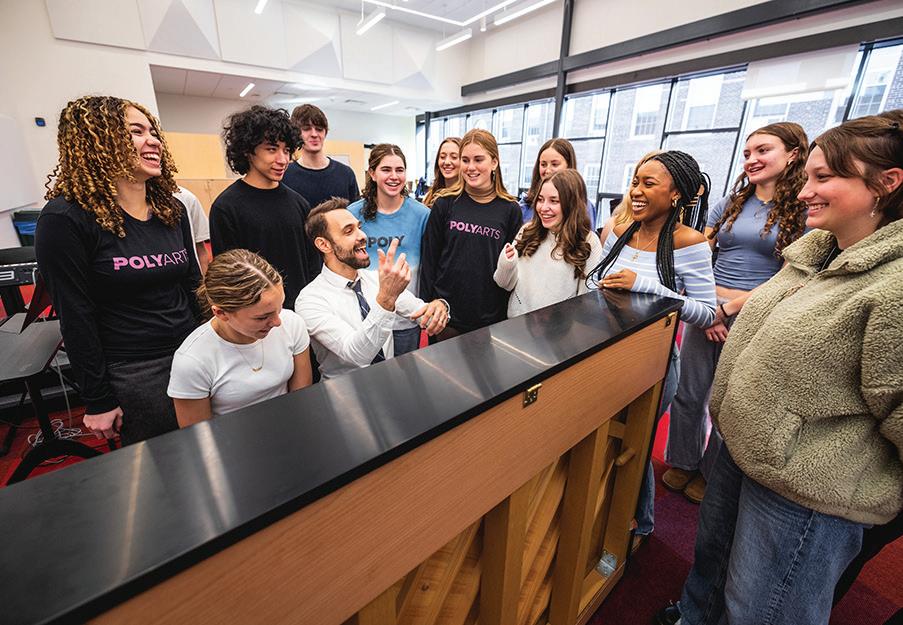
Moreover, the perception that Poly is solely a sports school due to its facilities is far from accurate, as Robinson shared that “Poly’s done a great job, certainly in the last 10 years, investing in arts-specific classroom spaces.”
For decades, Poly has had several visual arts rooms, a ceramics studio, a 380-seat professional theater, dance studio, and two band rooms, and—in the past two years—these spaces have only expanded. Recently, a digital media lab and the Poly Arts Center, which contains a band room, dance studio, and curated visual arts gallery space, have opened, with a dark room slated to come later in 2025. According to Waldman, these new resources are not only beneficial for the education of students, but for bringing increased representation and attention to the arts community by providing an on-campus space to host performances and display the program’s creative achievements.
“Poly has made efforts to make arts more known … [and] it’s really beneficial to the community,” she said.
IMAGE 1 :
The Poly Arts Center, completed in January 2024, added 10,000 square feet to the program in the form of state-of-art music and dance studies, a new theater lobby, and visual arts gallery space.
IMAGE 2:
Textiles on display in
IMAGE 3:
Choral Director and Music Programs Coordinator Vincent Iannelli practices with Advanced Concert Choir
the Harold Aibel Lobby Gallery in new Poly Arts Center.
members in the new music studio.
A CULTURE THAT EMBRACES ALL FIELDS
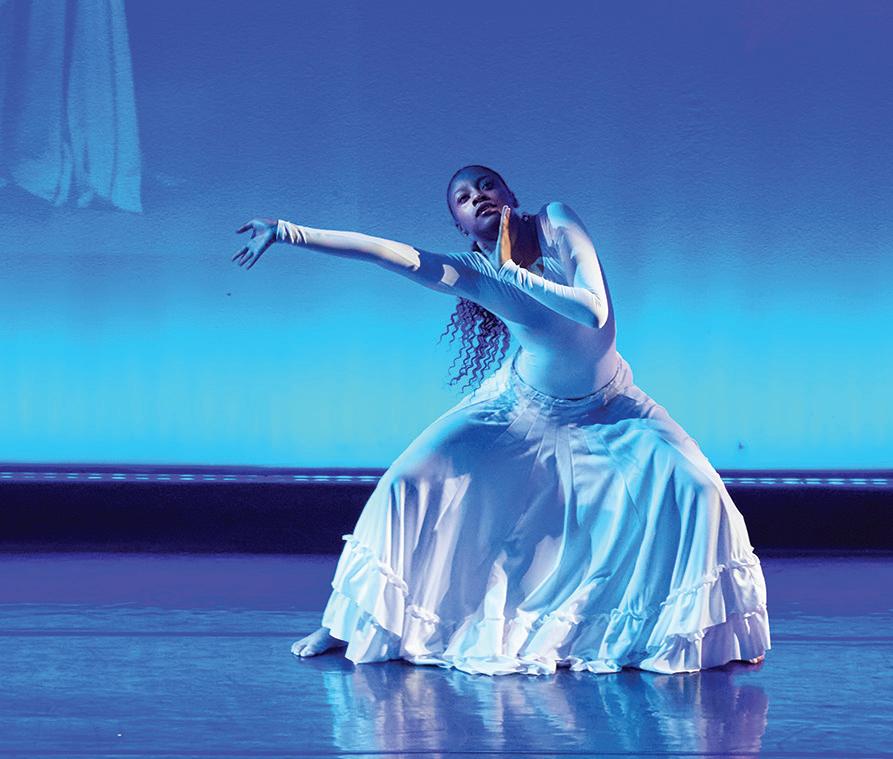
Athletic success offers the clarity of measurable outcomes—wins, losses, championships—and statistical records provide an easy, immediate narrative of achievement. While Poly academic and artistic accomplishments are equally remarkable, they lack this same universal scoreboard, making their excellence less immediately quantifiable to outside observers despite their profound impact. And while Poly may have the reputation of being a sports school, an overwhelming 79.4% of faculty share that this stereotype is unreflective of the actual Poly experience.

As Hershkovitz phrased it, regardless of whether a student is an athlete, academic, artist, or all three, at Poly, “the qualities of excellence in each of those realms are the same: discipline, humility, collaboration, critical and strategic thinking, creativity, and joy.”
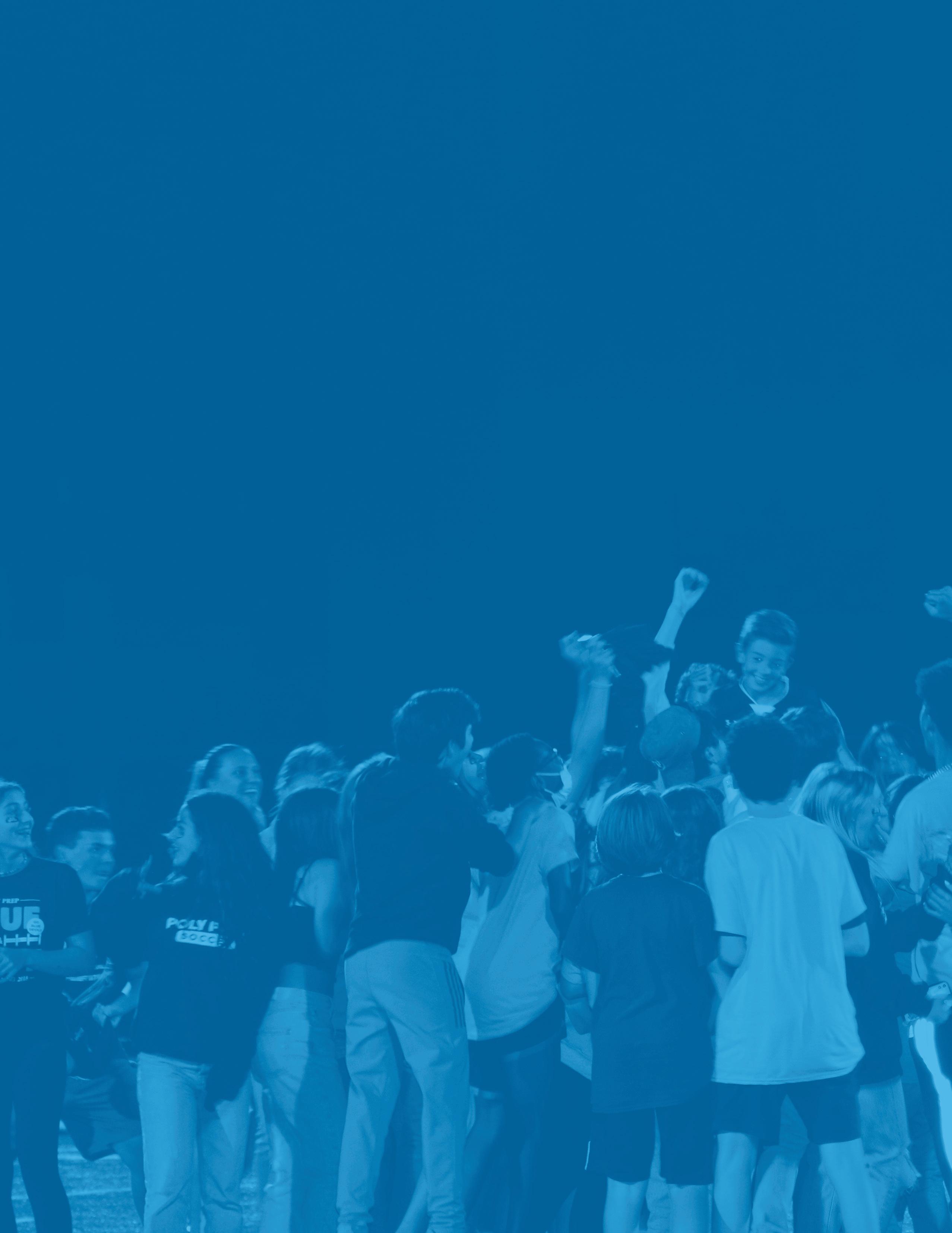
BACKGROUND: Miles Tartaglia ’30 is hoisted on the shoulders of teammates and Upper School varsity soccer players at the Grade 4 exhibition soccer match held during halftime on Blue Devil Night 2021.
INSET 1 : Sarai Dudley
INSET 2:
’26 performs in the Spring Dance Concert, April 2025.
Blue Bots team members Tesvara Jiang ’23 and Justin Woods-Owens ’27 working on Poly’s robot for the 2022–23 season competition.
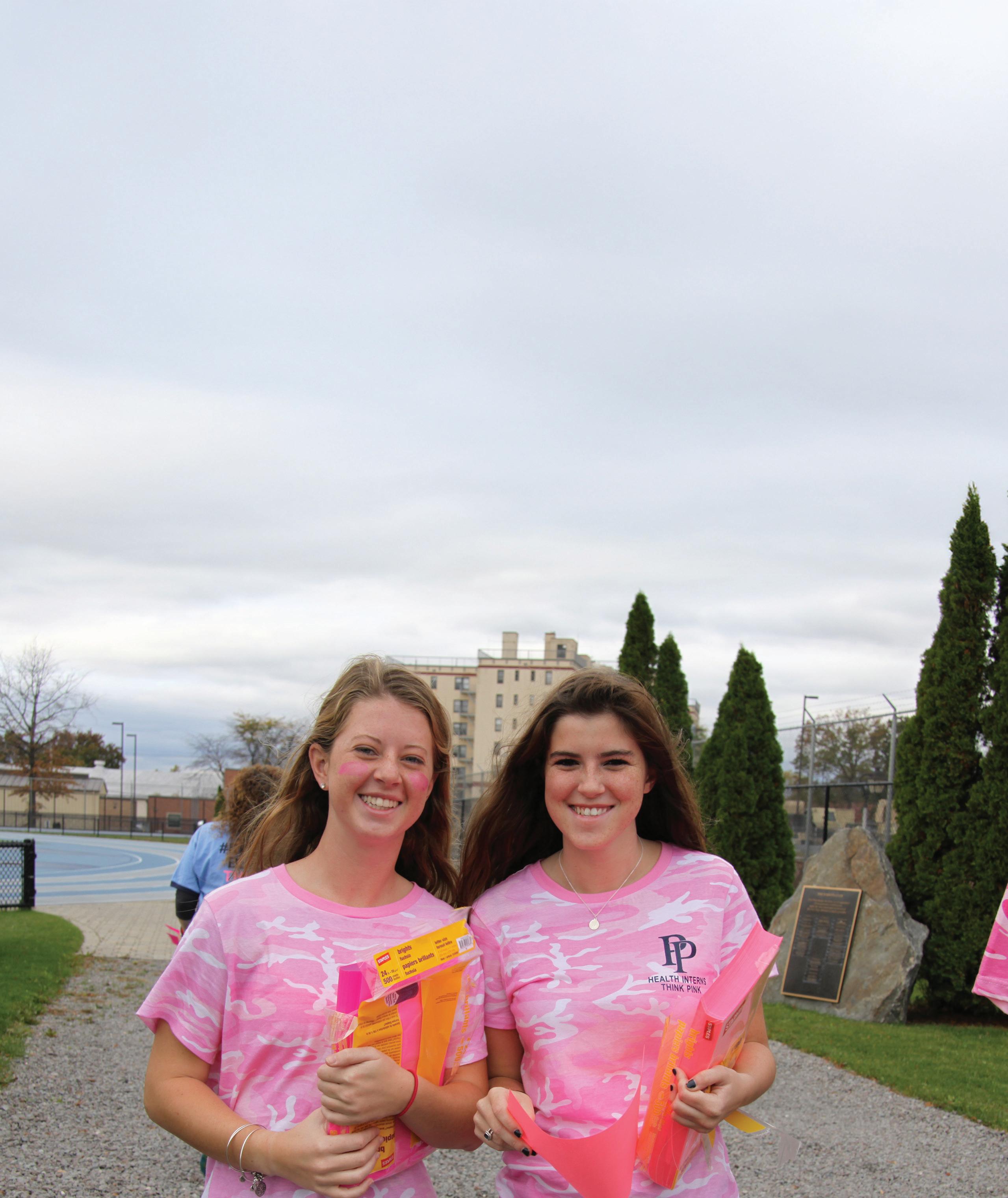
By Reese Roaman
HOW WE REVIVED HEALTH INTERNS
When I announced the return of Poly’s Health Interns program at our February 11 assembly, I felt a mix of excitement and responsibility. After five years away, this beloved program that shaped so many of our Middle School experiences was finally coming back.
The program, originally founded in 1997 by the late health teacher Patti Tycenski Mastro, or Ms. Ty, served as a peer leadership initiative that paired select Grade 12 students with Grades 5 and 6. These health interns would meet weekly during dedicated class blocks to plan engaging sessions covering everything from mental health discussions to sharing their Middle School experiences with younger students.
“The Health Interns program was truly one of my favorite parts of Middle School,” recalls Nico James ’25, who participated as a fifth grader when the program was still active. “We all thought the health interns were so cool, and it was a safe space where we could ask them any questions about growing up.”
The program came to an end in 2020 due to COVID-19 and logistical challenges, but for those of us who experienced it, the memories never faded. Since Health Interns ended, my entire grade has wanted to bring it back—it was truly one of the most impactful aspects of our Middle School years.
The timing of this revival carries special significance. After Ms. Ty passed away in the fall, Sadie Schoenberger ’25 and I knew that working to revive the program would not only strengthen our community, but also carry on her legacy. I never felt more connected to Upper School students than I did as a Middle Schooler in this program, and I know Ms. Ty always wanted to bring it back.
When we pitched the idea to Director of Student Life Jared Winston, Head of Middle School Daniel Doughty, Head of Upper School Sarah Bates, and Health Teacher Phoebe Aberlin-Ruiz P’30, they all agreed the time was right for reinstatement.
THIS FEATURE WAS ADAPTED FROM ARTICLES PUBLISHED IN THE MARCH 2024 ISSUE OF THE POLYGON AND MAY 2025 ON POLYPREP.ORG.
Health Interns Emma Schram ’15 and Mairead Gormley ’15 helping plan the breast cancer ribbon in 2014.
“The Health Interns program was truly one of my favorite parts of Middle School”
—NICO JAMES ’25

Winston expressed enthusiasm for the program’s return, explaining that “health interns will meet with Ms. Aberlin-Ruiz either during clubs or after school to plan activities with Grade 5 and 6 students. The hope is to build on inter-division programming like Club Captains and Peer Mentors to create meaningful bonds between the Middle and Upper School divisions.”
Now that we’ve launched, I can say the program has already exceeded our expectations. We health interns have been meeting every clubs block with Ms. Aberlin-Ruiz to prepare sessions, and our first meeting with Grade 5 students proved the program’s enduring appeal.
During our inaugural session, we worked in small groups with about 10 fifth-graders each, teaching them to take their pulse and record results. The highlight came when we all ran through a giant, tape-outlined heart in the gym, with fifth graders holding red and blue papers representing oxygen flow. After observing how exercise increased

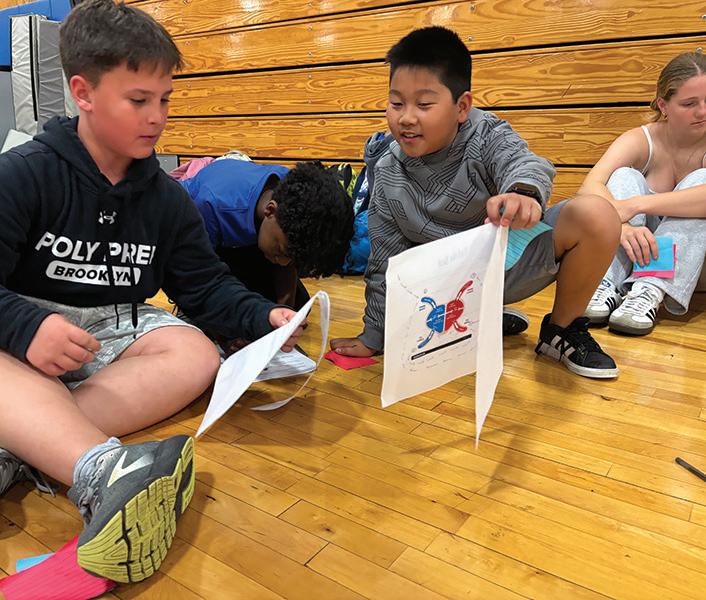
their heart rates by retaking their pulses, we wrapped up with conversations about general health and the importance of aerobic exercise.
My fellow health intern Ava Vitali ’25 captured what many of us feel: “I am so excited. I always wanted to be a Health Intern when I was in Middle School, and I can’t wait for our first meeting.” We’re continuing the program with Grade 6 students scheduled to discuss social media usage in our upcoming session on Tuesday, May 27.
Bringing back Health Interns represents more than just reviving a beloved program—it’s been a deeply personal journey of honoring what shaped us and ensuring future students have the same meaningful connections we experienced. As we step into the role we once admired from afar, we’re not just continuing Ms. Tycenski’s vision of connecting students across divisions—we’re creating a bridge between what was and what can be again.
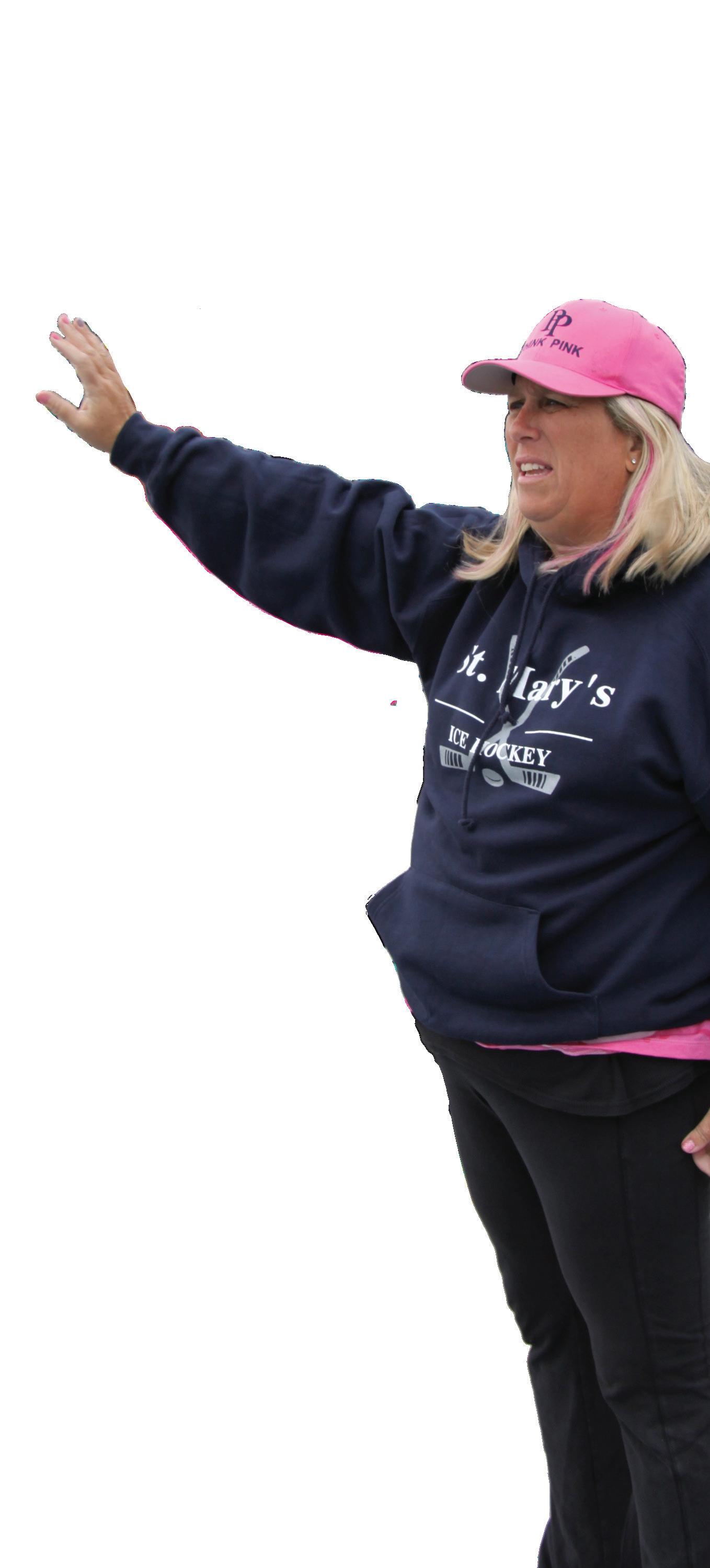
RIGHT: The late Patti Ty supervising a Think Pink event.
INSET 1 : Gianna Denis ’25, Ava Rose Vitali ’25, and Roaman ’25 demonstrate how to find their resting heart rate with Grade 5 students.
INSET 2: Nathaniel Song ’32 and Winston Tilove ’32 compare their elevated heart rates.
BACKGROUND:
Health Intern Breanna Basso ’25 works with a cohort of fifth graders.

Four Decades in Independent School Education
By Jennifer Slomack
On a bright winter afternoon, John Rankin settles into his office chair on the Brooklyn campus that has been his professional home for 40 years. With his tenure at Poly Prep spanning roles from English teacher to department chair to senior administrator, and now head of school, Rankin has observed—and helped shape—nearly half a century of independent school education.
“I never thought I’d be here so long,” Rankin admits with a smile. “Every few years I’d think, ‘This might be my last,’ but then Poly would present another opportunity that kept me engaged.” That engagement has given Rankin a front-row seat to the broad changes in education, from a tradition-bound school evolving to its more contemporary inclusive self. The changes in pedagogy, student mindsets, parent relationships, and institutional priorities tell a larger story about American education itself.

From Lecture to Learning
Perhaps the most visible transformation Rankin has witnessed is in teaching methodology. “When I arrived in the ’80s, about 80-90% of teaching too often followed a ‘sage on the stage’ approach,” he recalls, referring to a traditional format where teachers imparted broad knowledge with less emphasis on student understanding.
That approach has largely given way to more collaborative, process-oriented learning. “There’s been a significant shift toward addressing students where they are, helping them develop who they are and what they want,” Rankin explains. This reflects broader educational research showing the effectiveness of student-centered approaches.
This evolution often manifests in diminished emphasis on mastery of content and testing and greater focus on how students engage with material. Science classes, for example, now emphasize scientific thinking processes alongside content knowledge. “It’s a delicate balance,” Rankin says. “Not understanding why you need to learn the structure of a cell is problematic. But so is learning about scientific processes without mastering any actual science.”
This pedagogical shift has been accompanied by expanded student support systems. Where once there was minimal learning support, Poly now employs specialists across all three school divisions and has developed a writing center at the Dyker Heights campus that serves students of all abilities. “We’re recognizing that cognitive ability alone doesn’t determine educational success,” Rankin shares. “Students need different kinds of support to reach their potential.”
... And Skeptic to Believer
When Rankin first began teaching, his attention was on learning for learning’s sake, the seriousness of study. Our counseling staff was minimal, learning support barely existed, and student well-being was considered largely separate from educational outcomes. Over decades watching students navigate increasingly complex adolescent experiences, Rankin’s perspective underwent a shift.
“I was probably a social-emotional learning skeptic for many years,” Rankin admits. Witnessing the positive impact of Poly’s expanded counseling team and support systems changed his thinking. “Having been around our students for so much time, I think they need that emotional support as much as they need academic instruction. They need that [foundation] to develop, to grow, and to feel confident just to be a student.”
This evolution mirrors broader trends in education, where emotional intelligence and mental health are increasingly recognized as fundamental to academic success. Rankin now embraces a more holistic view of student development. “Back then, I had a fairly one-dimensional idea of what it meant to be a student. I don’t see it like that anymore. Students aren’t generic entities—they are individual people who develop differently.”

IMAGE 1 : Waiting for students to arrive to English class.
IMAGE 2: Grading papers in the English office.

IMAGE 3:
Rankin teaching during his Grade 12 Philosophy Seminar with Alex Xaio ’24 and Maia Kovaleski ’24 in October 2023.
IMAGE 4:
Rankin delivers the opening address to Middle School and Upper School students on the first day of school in September 2024.
Students Then and Now
When Rankin teaches today, he notices something markedly different from his early years. “Most students now know exactly what they will study in college and where they hope it will lead professionally,” he observes. “They are in this sense very transactional about learning.” This represents a shift from earlier decades when college, at least by the teaching faculty, was viewed more as an exploration than a destination. Rankin recalls his own educational journey: “I had absolutely no idea why I was going to college. … I found subjects I was interested in studying that have sustained me throughout my life.”
While Rankin acknowledges today’s students are “more sophisticated” and “more deliberate” in their planning, he wonders what might be lost when education becomes primarily transactional, i.e., a means to a professional end rather than a journey in itself. A 2022 survey from ECMC Group, in partnership with VICE Media, revealed that “teens believe postsecondary education is not a way to find a career, but rather to refine and pursue career options. Furthermore, 75% of high schoolers have a career in mind and 74% believe it is important to have their career plans determined when they graduate from high school.”


The New Family-School Dynamic
When Rankin first arrived at Poly, the relationship between parents and schools operated on clearly delineated lines. “Parents were much more deferential to the school’s expertise back then,” he observes. “The educational landscape had clearer boundaries between home and school responsibilities.”
Today’s parent community brings greater educational sophistication and engagement to the table, creating both opportunities and dynamics to navigate. “Many of our families [come from] homes with advanced degrees and professional expertise,” notes Rankin. “Parents’ insights about their children can be invaluable, particularly in understanding social-emotional needs.”
The task for schools like Poly is crafting what Rankin calls “a framework that honors both parental insights and educational expertise,” thereby maintaining professional boundaries while embracing meaningful parent partnership.
“The Parents’ Association structure has changed over the years to ensure long-term continuity. We’re here to help the community thrive by creating those supportive bridges between families and staff whether that’s our regular meetings with school administration, creating new PA roles, or coming up with ideas to improve a process,” said PA co-President Cat Arrieta P’28, ’29. Co-President Kristin Heavey P’27, ’30 added on, “it’s about [us] asking: ‘how can we help allowing parents to meaningfully contribute to the school experience?’ We are thankful that both the school and parents are willing to learn from each other, to advance the best of Poly.”
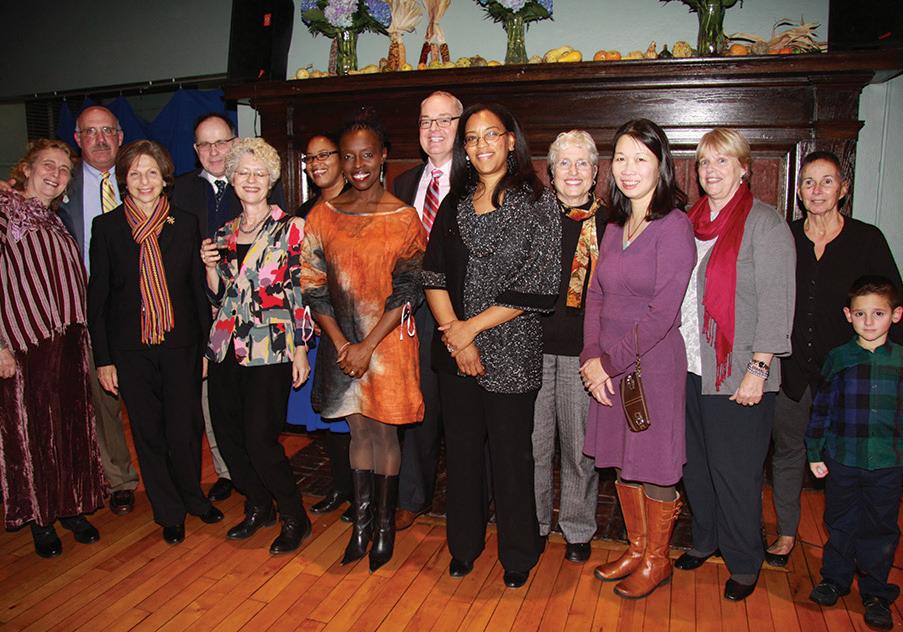
Balancing Tradition and Innovation
Like many established institutions, Poly has navigated the tension between honoring tradition and embracing necessary change—what alumni sometimes affectionately debate as “Old Poly” versus “New Poly.”
“We’ve evolved considerably,” Rankin acknowledges, citing changes in curriculum, teaching approaches, and administrative structure. Some changes were responses to educational research, others to shifting student demographics and needs.
Rankin has witnessed all of the top independent schools move away from focusing on the College Board’s Advanced Placement, or AP, courses and exams. When Poly did this a few years ago, the programming shifted to numerous faculty-built advanced courses and specialized electives. “There was a deliberate shift toward student choice and courses that more closely resemble college seminars,” he explains.
Community as Cornerstone
When asked what gives him hope about Poly’s future, Rankin doesn’t hesitate: “Our community values. People here respect and care about each other. It is a warm, open place that sustains itself even through challenges and transitions.”
This sense of community distinguishes Poly in Rankin’s experience. “I’ve visited many peer schools, and I do not see quite the same feeling elsewhere. It’s our greatest strength.” Rankin believes this community ethos enables Poly to serve diverse learners particularly well. “We accommodate a broader range of student experiences and learning styles than many of our peer competitive schools,” he observes. “Our graduates follow remarkably different paths, yet all find ways to succeed here.”
Wisdom for the Future
As Rankin contemplates the future of independent education, he identifies enduring principles that schools must preserve regardless of changing methodologies or demographics. “The serious work of learning cannot be compromised,” he insists. “And having a professional faculty with a strong ethical framework for helping each child learn to their capacity—that’s non-negotiable.”
For parents navigating school choice, Rankin offers straightforward advice: “Trust the educational process. Schools like ours have thoughtful professionals dedicated to your child’s development.”
And for future educational leaders? “Keep classroom teaching central to your mission,” Rankin advises. “Administrative structures and support services matter, but they exist to facilitate the essential relationship between teacher, student, and material.”
In conclusion, Rankin reflects on his unexpected fourdecade journey at Poly. “I planned to do other things, but I don’t regret staying. Despite challenges, this is a remarkable place. I’ve worked with extraordinary students and colleagues in a community that values both excellence and acceptance.”
In an educational landscape increasingly focused on metrics and outcomes, Rankin’s perspective reminds us of education’s deeper purpose: developing young people who think critically, engage ethically, and approach life with curiosity and compassion—qualities that transcend any particular era or educational trend.
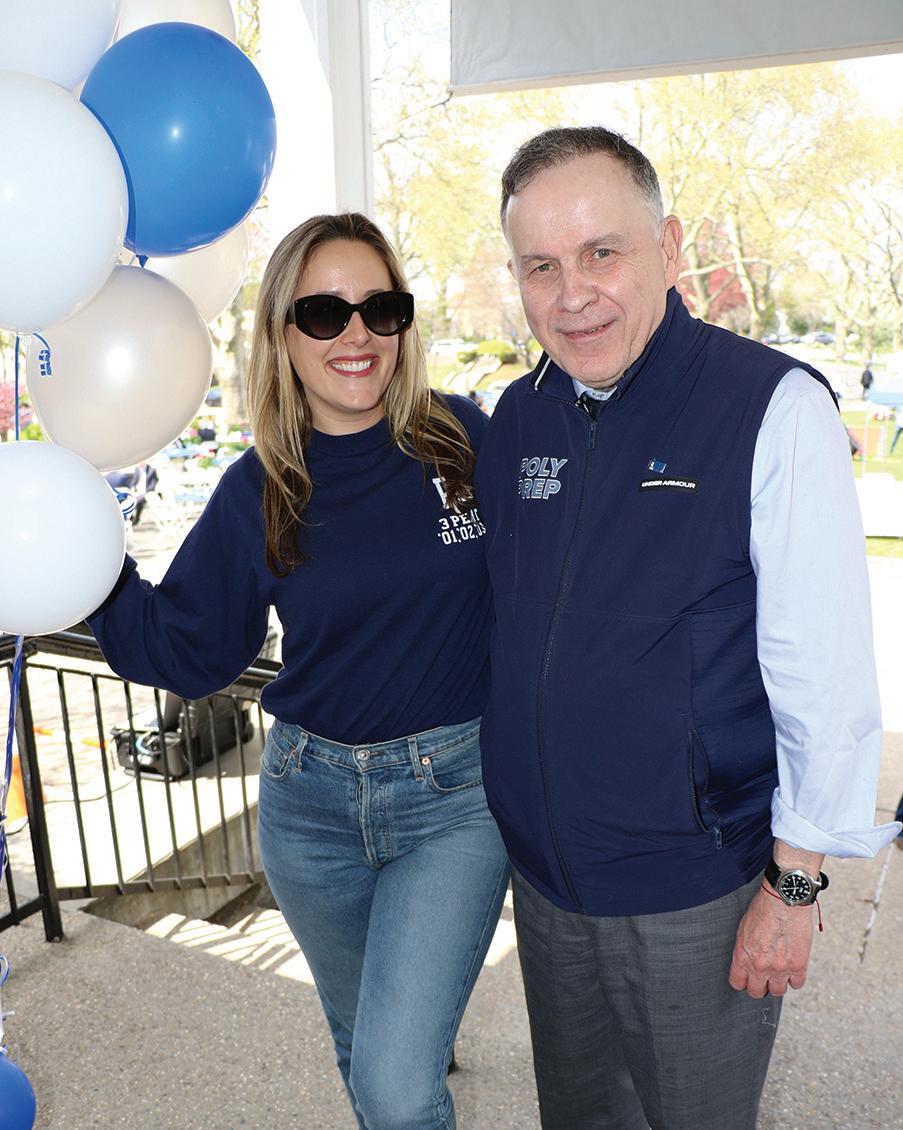
IMAGE 5: Rankin with fellow faculty and staff members at the 2014 Celebrate Teaching and Service event.
IMAGE 6: Rankin with Cristina Cote ’05 at the 2024 Reunion.

THANK YOU
GREAT YEAR!
We had an amazing year of giving–it had an impact on every student at Poly.
Poly is counting on your support as we enter the 20252026 academic year. We look forward to another senior sunrise, homecoming, ice skating, reunion, graduation, and many more community events. Because of your support Poly students thrive.
Aferdita Hakaj Director of Annual Giving 718-663-6033
ahakaj@polyprep.org
Nicole Patti Annual Giving Coordinator 347-394-1104
npatti@polyprep.org
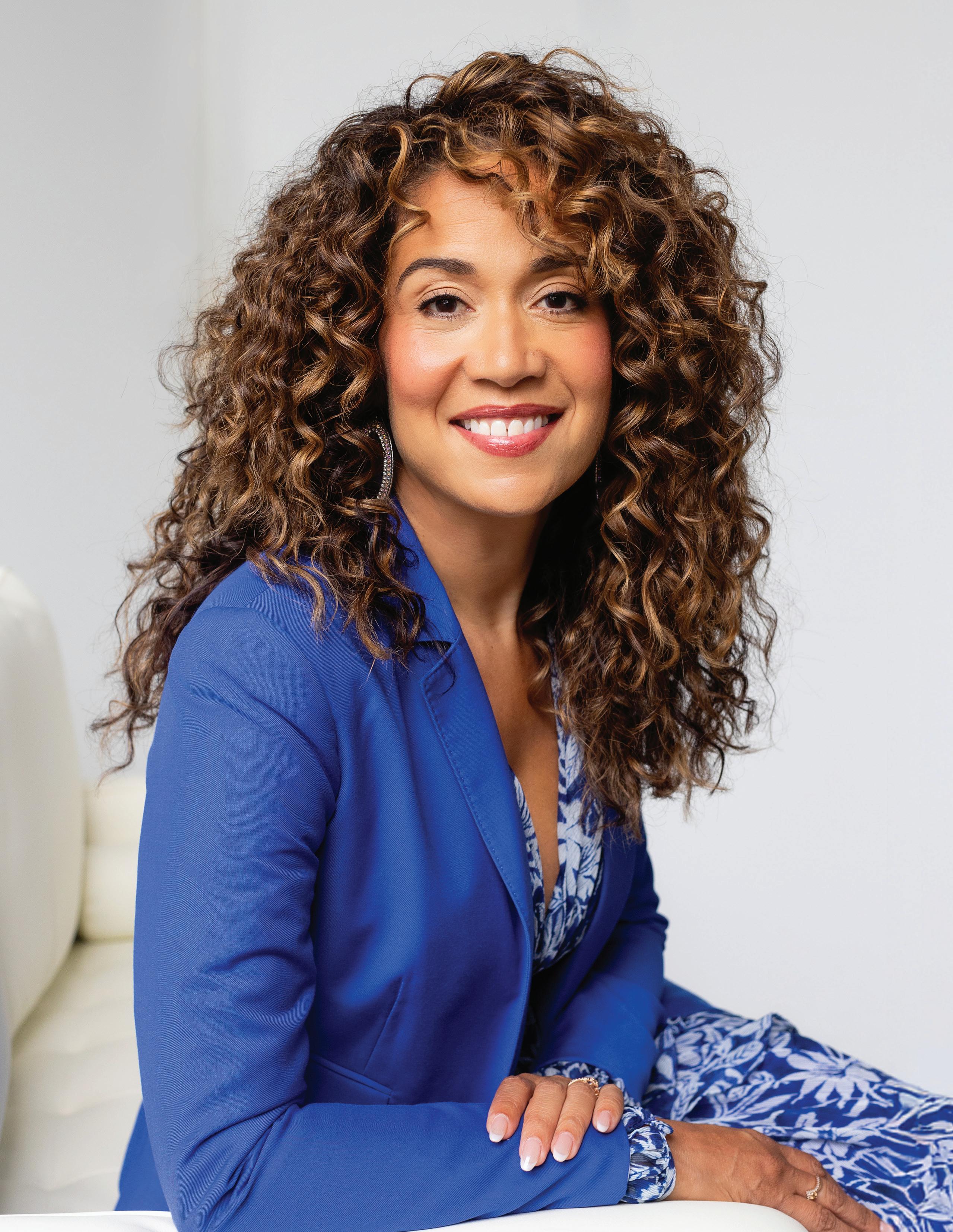
Getting to Know Dr. Noni Thomas López, Poly’s 12th Head of School
She found her calling in a North Carolina classroom and now returns to New York to lead Poly, carrying a vision of education where excellence isn’t just about achievement—it’s about discovering who you’re meant to become.
Interview by Jennifer Slomack
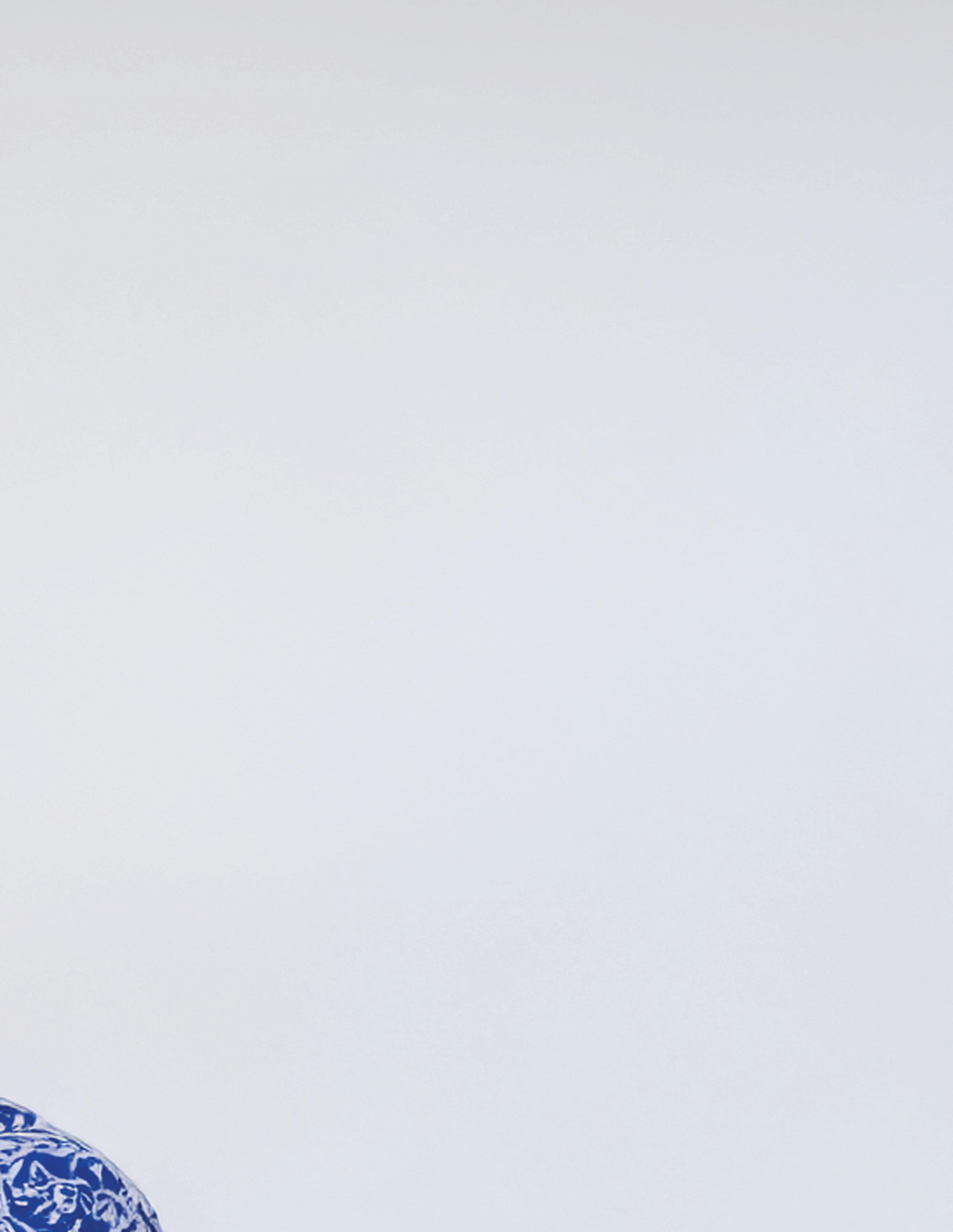
Why did you become an educator?
Do you have an origin story?
I was in college at UNC Chapel Hill, getting a degree in English, and didn’t know what I wanted to do. Law school seemed right, but I didn’t have it in me for three more years. I went back to my hometown in Greensboro, NC, and talked to my eighth grade English teacher about what I should do. He asked if I had thought about teaching, and I said no because I didn’t think I could make a good living. Having come from a working-class family, finances were a constant worry, but I didn’t have any other options, so I started as an assistant fifth grade teacher. Two weeks in, I worked with a student on his writing. He was a great kiddo, but he didn’t like language arts. Over the week, we worked closely together, and by the end, he had produced something he was proud of. Not only that, he saw himself differently: he saw himself as a writer. I felt if I could have that kind of impact on a child’s life, then this was the profession for me. Teaching is a calling, and that was the moment I found mine. Since then, I’ve never looked back.
You’ve worked at a lot of great schools. What drew you to Poly?
My parents grew up in New York, and though I grew up in North Carolina, I was raised as a New Yorker. I lived and worked in the city for 20 years, and my husband was born and raised in the Bronx, so the idea of coming back home was deeply appealing. But it had to be the right school. As I got to know Poly, I saw a real alignment between what I believe is transformative about schools and what Poly is and wants to be in the world. Poly’s culture resonates with me because students are at the center of every conversation—their experience, their learning, their relationships. Schools face tough challenges, but keeping children at the center helps to keep a school focused on what’s core. When people talk about what they love about Poly, it’s the community. It’s what students carry with them. The people I have met love the school and believe deeply in it. I think it comes from feeling like this place is a second home, a second family.
Do you have an educational philosophy?
My work in education for the past 30 years has been the primary way in which I choose to serve my community and the world. I believe my role is to help young people discover who they are and determine how they will use this understanding to contribute positively to the world. Great schools build on children’s unique gifts and provide the knowledge, skills, and dispositions necessary for them to be active participants in a diverse community: active intellectually, physically, politically, socially, [and] morally. As an educational leader, my role is to cultivate the community in which this important work can occur, striking a delicate balance between honoring and preserving the school’s culture and its most essential traditions while—at the same time—inviting the community into conversation that will push its thinking in bold and innovative ways.
When we talk about the Poly pillars, we talk about “Diversity, Excellence, Brooklyn.” Can you tell me what the pursuit of excellence means to you?
A student once asked me what makes a successful school. I replied that a school is successful when students understand what their learning is for. When they read The Outsiders , for example, I hope students will be moved by the depth of the bond between Ponyboy and Johnny, but I also hope it will help them understand something about friendship, found family, love, and loss. Algebra should help them understand how to solve problems, ask questions, and persevere in life. I want students to look back and not only say, “I got where I am because I went to Poly,” but also, “I am the person that I am because I went to Poly.” Pursuit of excellence is the pursuit of meaning and purpose. We are not just preparing students for the future; we’re preparing them to create the future.


What role does diversity play in schools?
Real learning doesn’t happen in an echo chamber. It’s important to learn alongside people who think differently and have a diversity of experiences, cultural backgrounds, and ways of seeing the world. I don’t know how real learning happens when your ideas are never challenged or you never have the opportunity to be exposed to different perspectives. At the same time, it’s important to be affirmed in your own identity, background, and values. Seeing yourself in the curriculum is key. Seeing people who look like you in the hallways, in leadership, and, on your team, is key. Great schools think intentionally about providing these windows and mirrors because they are essential to creating intellectual engagement and connected community.
What does Brooklyn mean to you?
Brooklyn, to me, is possibility. I lived here when I was becoming an adult, an educator, and a leader. And Brooklyn was growing and changing in exciting ways. To be at a school that embraces that identity is exciting because young people are in a process of becoming. Poly has grown alongside Brooklyn in important ways. Having that history to help chart our path to the future is exciting. Poly is not just a school in Brooklyn: Poly is a Brooklyn school.
You have a reputation as a leadership mentor and are known nationally through your founding of the Interschool Leadership Institute. How would you describe your leadership style?
In terms of my personal approach to leadership, I benefited from mentors who saw gifts in me that I couldn’t see in myself. What I learned is that there are no natural-born leaders. Leadership can be learned, and what makes a good leader is not a secret: trustworthiness, humility, self-awareness, and a sense of humor.
Leadership is a practice. You work at it, get it wrong, get back up and try again. Just like yoga—sometimes you get the pose, sometimes you don’t—but you keep

IMAGE
Thomas
to the occasion when called to the stage to play drums alongside Maddy Wyatt at the Spring Vocal Concert, April 2025.
IMAGE 1 : Poly Trustee Laurie Rosenblatt P’23, ’26; Thomas López; and alumnae Mary Lin ’24 at Homecoming 2025.
IMAGE 2: Thomas López and her husband, Rodney Lopez, enjoy the performing arts showcase at Homecoming 2025.
3:
López rose
coming back to it, learning as you go. Failure is a gift. For me, leadership is an opportunity to be my best self. I invite others into it because in institutions, leadership is everything. It doesn’t require a formal title. Leadership is a mindset, a practice, a behavior.
What do you hope students take away from their Poly experience?
When students leave Poly, I want them to leave with a sense of purpose. I want them to understand they are on this planet for a reason. During their time here, they should have the opportunity to explore their passions, understand what they’re good at, what they need to work on, and what their values are. The world needs more young people with a sense of purpose and possibility.
It sounds like you’ve met some Poly alumni.
Our alumni are our history, our biggest cheerleaders, and they want the best for the school. They want what they experienced for future generations. It will look different—it has to if you’re a school with 170 years of history. When we think about the people who will be partnering to bring Poly into its next iteration, alumni are a key part of that equation.
You’ve been talking to Poly community members for more than a year. Have you put together any plans or created a vision for Poly?
New heads of school are always asked about their vision and goals. I want to be honest and say that I’m going to learn those alongside the community. As I get to know the people, culture, and history, we will develop a shared vision for our future. That is the work of my first months at Poly—building relationships and an understanding of this special place to develop that vision with students, faculty, staff, families, and our alumni community.
Schools must hold onto the best of their history as they grow. I love tradition and ritual; they bind us together across generations. It’s important that we develop a shared purpose, which comes from understanding and using the best of our history as a roadmap to our future.
Any final thoughts to share?
Poly, I am so excited to join you in July 2025. There is hard and important work ahead, but my intention is that we’ll have a lot of fun along the way. I hope you like to dance! I hope you like to laugh. Poly is where I want to be, and I cannot wait to join this incredible community.
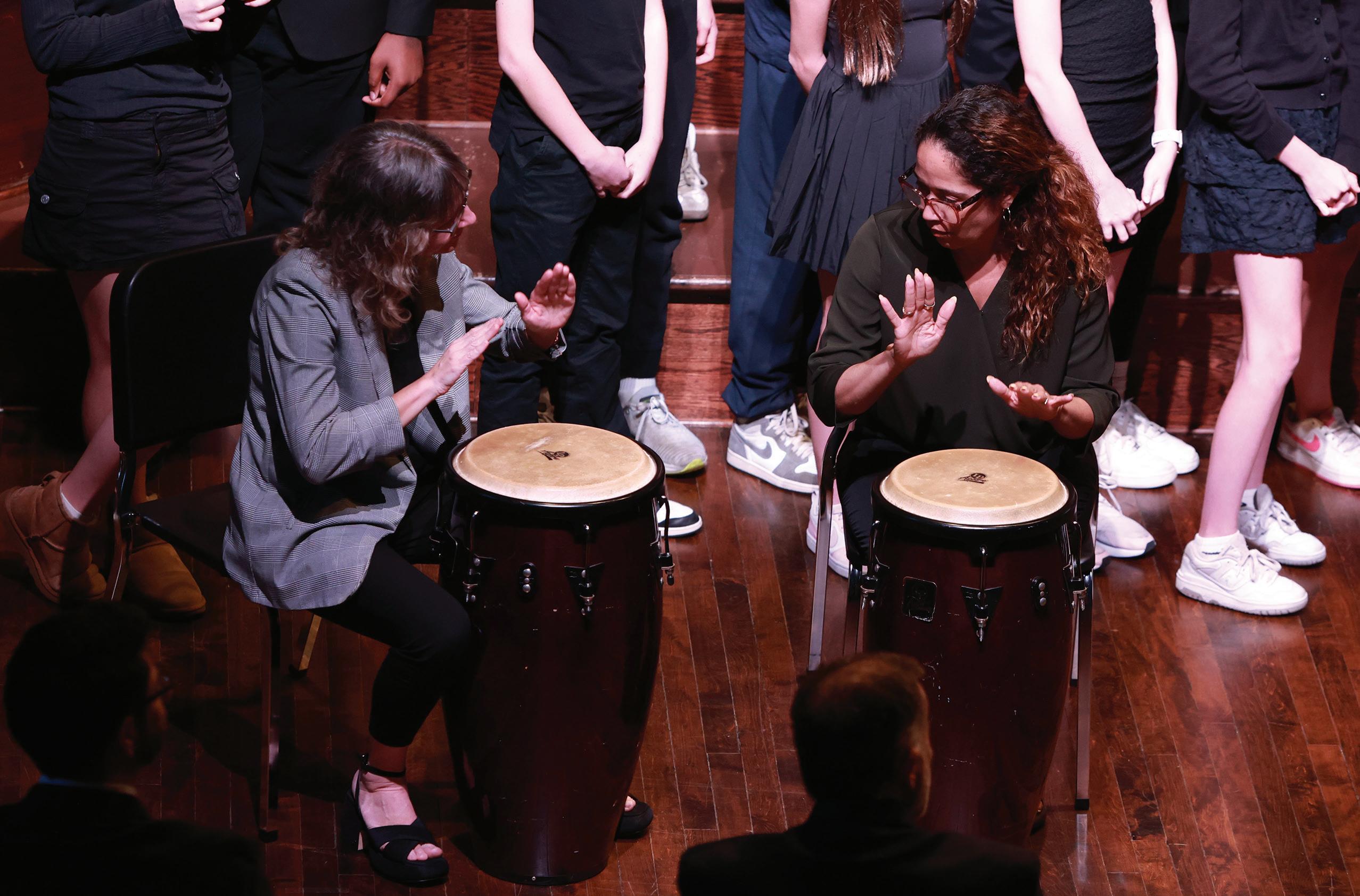

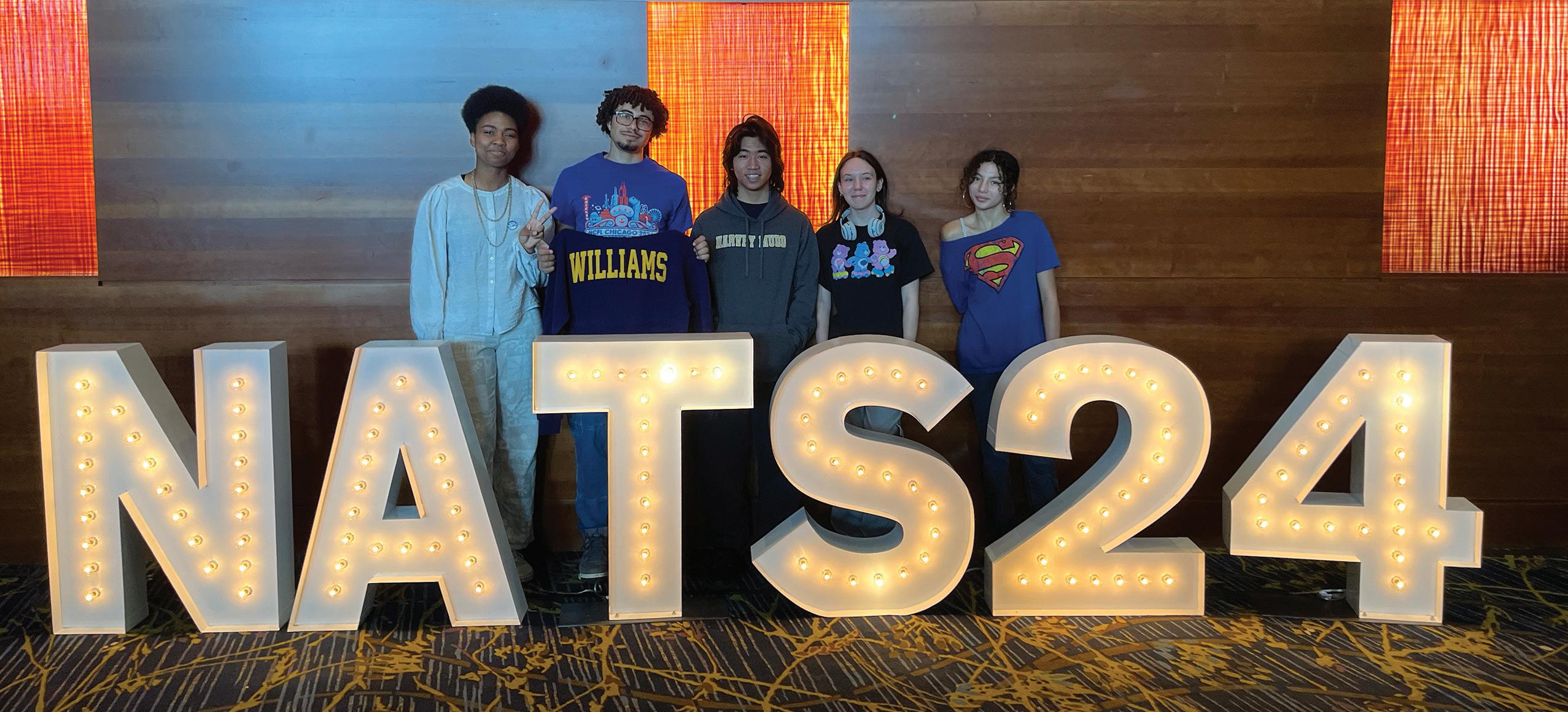
SPEAKING THROUGH CHANGE: Poly’s Debate Team Across Generations
By Sasha Londoner
In a small classroom, four students sit across from one another in teams of two. After a moment, the first student steps up to the podium and takes a deep breath. At the start of his timer, he begins speaking. At a dizzying pace, he defends a resolution, reading pages upon pages of evidence, analysis, and statistics in a passionate tone. His speech is oriented around the topic of intellectual property rights and, more specifically, trademarks. The speaker argues that strengthening intellectual property rights by expanding the scope of what can be trademarked is beneficial since trademarks provide legitimacy to brands and the legal protection of products, which leads to an increase in profits when attained.
For eight minutes, he zooms through his speech as the two-person opposing team scribbles down his statements, drafts refutations, and searches for literature to negate his argument. After his speech,
they spend three minutes taking turns questioning him about his argument in an attempt to reveal its flaws and shortcomings. In the next 90 minutes, this cycle will continue: teams will alternate speaking in increments of five or eight minutes, interrupted by three-minute periods of cross-examination and intervals of limited preparation time.
This is a Policy Debate round, an opportunity introduced this year for members of the Poly Prep debate team. According to Poly’s Director of Forensics and Debate Eddie Fitzgerald, “Debate at Poly has gone through several different iterations of [its] program … but the current iteration of this program began again in 2011.” Since then, the team has reinvented itself in several different ways. Despite offering multiple debate events in the early 2010s, Poly had discontinued all but two of them by 2022.
(Originally published in The Polygon , February 24, 2025 issue)
Now, the team plans to make another programmatic shift to develop their new offering: Policy Debate. While this change has yielded both struggles and accomplishments, it’s allowed Poly’s debate team to continue a successful legacy while also ensuring that students have opportunities to both academically enrich and enjoy themselves.
The Dawn of Debate: 1875 to 2010
The Poly Prep debate team, founded under the name of The Debating Society, has a rich history. According to the fall 2013 edition of The Blue & The Gray, the team began in 1875 and was officially recognized as a school activity in 1894. In 1901, the team, now referred to as The Poly Prep Literary and Debating Society, was recognized by the Polyglot as “the oldest school organization.” In its earliest days, Poly’s debate team offered two events: Mock Congress and Parliamentary Law.
MaKiyah Turner-Hicks ’24, Bryce Trent ’24, Nathan Nguyen ’24, Ava Barbiere ’26, and Amara Johansson ’26 at the 2024 National Speech & Debate Tournament in Des Moines, IA. Turner-Hicks finished 33rd in the U.S.
While Parliamentary Debates take different forms, they’re generally based on the British Parliamentary system and have two teams (of two) either affirm or negate a resolution introduced 20 minutes prior to the round.
By 1916, the Polyglot shared that “debate was gradually becoming an important feature of Poly life,” as Poly Prep’s debate team established itself as a successful program, winning several tournaments and introducing Public Speaking and other speech events in 1937. The team continued to excel in Mock Congress and Parliamentary Law until English Teacher, Associate Director of College Counseling, and Debate Coach Jackie Kornblum decided to discontinue these events in favor of the Lincoln Douglas debate, or LD. Distinct from other forms, LD is a unique event due to its one-on-one debating style and focus on morality. While The Blue & The Gray suggests that this shift happened in 1999, several Polygon articles indicate that it happened as early as 1997.
Although the debate team saw incredible success in LD, Director of Service Learning and History Teacher Elijah Sivin shared that the program was shut down around 2007 with Kournblum’s departure. Sivin, one of Poly’s Lincoln Douglas judges in the ’90s, stated in an email that “Because the program basically revolved around [Kornblum], when she left Poly for Dalton, there wasn’t anyone ready to take her place as head coach.” And so, Poly’s debate team came to an abrupt end, not to be revived until years later.
New Beginnings: 2009 to 2013
While the team wasn’t completely reestablished until 2011, it began to gain traction around 2009. According to The Blue & The Gray, a teacher restarted the team as an elective course, offering LD to those interested. However, it wasn’t until a donation by an alumnus that the team really began to blossom. “A few years before I came on, there was an anonymous donor who wanted Poly to create a debate program,” said David Baloche, the 2013–2016 director of speech and debate. “So they gave a lot of money to the school for the specific purpose of creating a debate program, [and] they did.”
This donation not only saw Poly’s team re-established, but also grew it to become larger and more rigorous than before. According to The Blue & The Gray, in 2012 the donation enabled Debate Coach Brent Adams to introduce Public Forum, or PF, which is a partnered debate event oriented around current events. With the traction that both this funding and the new event offered, the program thrived. In 2013 alone, Poly’s debate team won 110 awards, including the Metro-Hudson League award of “Debate Program of The Year.”
Full Steam Ahead: 2013 to 2016
As the program began to develop, it offered more events. While Baloche shared in an email that “technically, I offered all events,” he “only had [the] capacity and resources to support students in certain events,” which were those with the most student and community engagement. From 2013–2016, these were PF, LD, and Congressional Debate, which is a variation of Mock Congress. However, Baloche added that while there were around 18 Public Forum debaters, there were only two Congressional debaters. According to Jonah Sah ’22, a Poly Public Forum debater from 2015–2022 and team captain in 2022, there was one LD debater. As a result of the small number of Congressional and LD debaters, Baloche claimed that they “[debated] without much support” but “understood that and worked hard to compete anyway.”
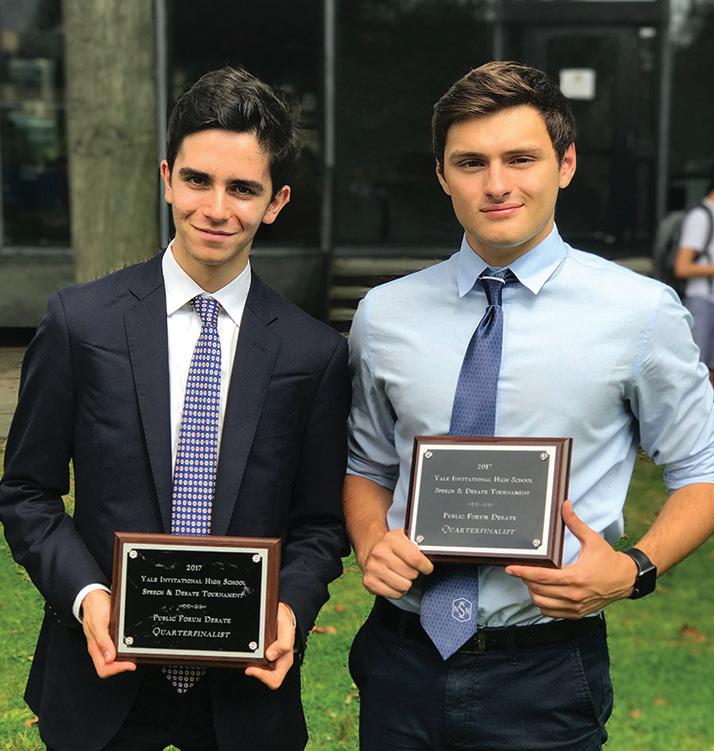
As for Poly’s competitors, Baloche shared that they were often from other New York private schools but changed frequently depending on the circuit Poly was competing in. “It’s like one of those … Russian [nesting] dolls,” noted Baloche when describing the teams Poly would compete against. “There’s the national level, which is the top shelf, and then when you remove that, you have the state level. And then when you remove [that], you have [the] New York City metropolitan area,” and then the Brooklyn area. In an email, he shared that Poly participated in six total local and national debate leagues, all of which the team still competes in today. “Poly is incredibly lucky,” said Sah when reflecting on his experience with the team. “There are maybe five schools that send as many debaters to as many tournaments on the national circuit as we do.”
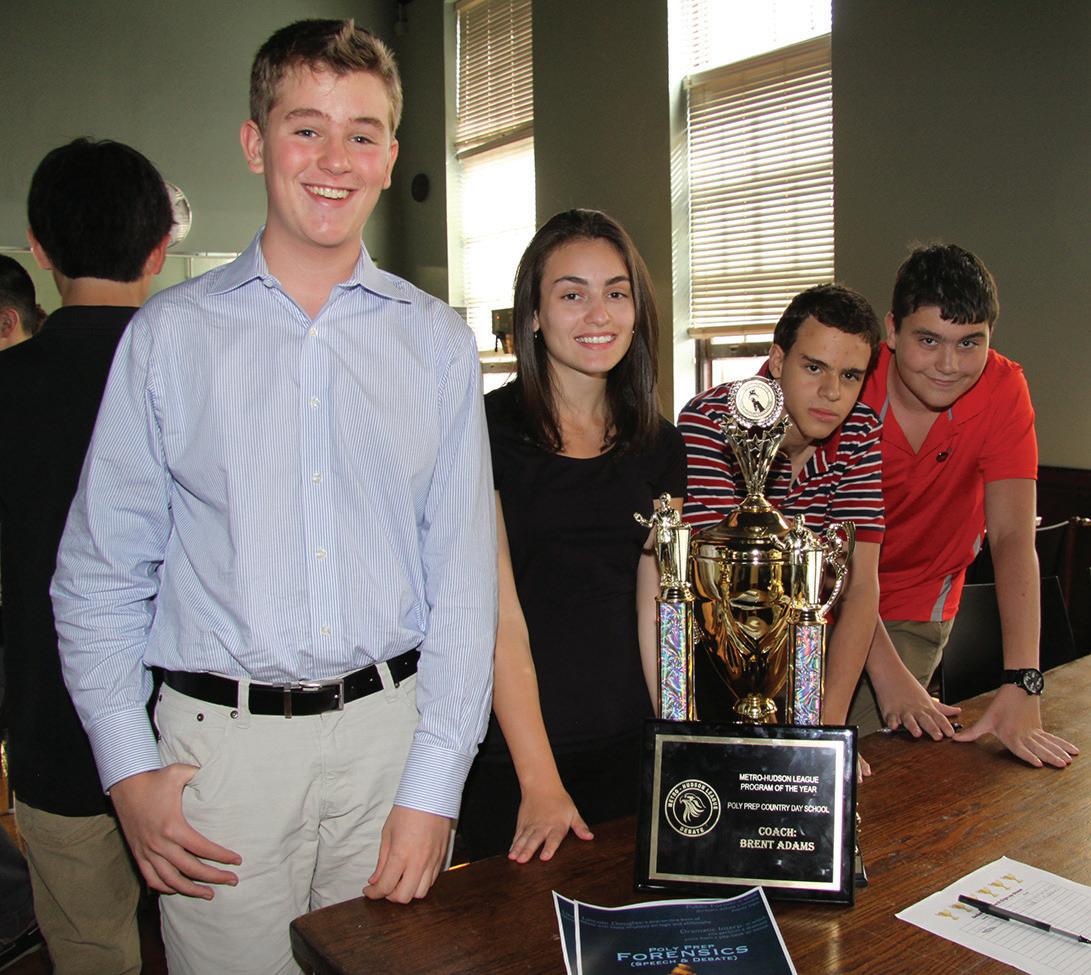
ABOVE: Daniel Fernandez ’19 and Nick Stratigakis ’18 display their quarterfinalist awards in Public Forum Debate from the Yale Invitational Speech & Debate Tournament in 2017.
LEFT:
At the Upper School Club Fair in 2014, Eitan Ezra ’16, Katherine Pazushko ’15, John Goulandris ’15, and Casper Arbeeny ’16 encourage Grade 9 students to join Speech & Debate.
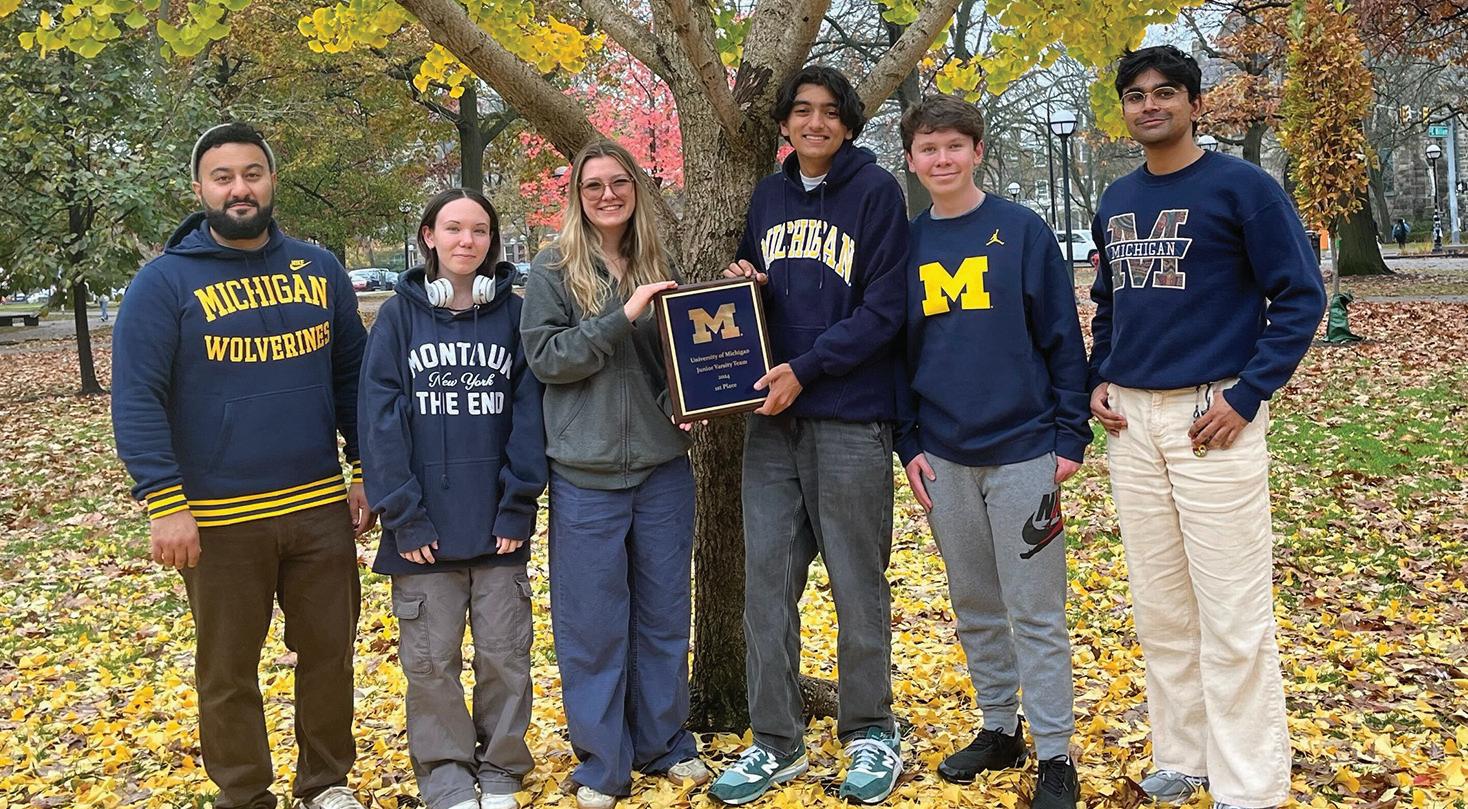
Constant Success: 2016 to 2022
While Baloche left Poly in 2016, the team continued to thrive. According to a 2016 Polygon article, the Public Forum team of Eitan Ezra ’16 and Harrison Hurt ’16 not only won the National Catholic Forensic League, but were also ranked as one of the top 10 teams in the country. According to Sah, another constant on the team was the community.
“What kept me in debate for so long was that it was a lot of the same people,” he admitted. “There was always this very friendly culture.”
Nonetheless, there were slight shifts that accompanied the change in leadership. As Baloche departed, Sah shared that “there [were] several different coaches that we cycled through, [and] they all definitely had different styles.” Over text, he clarified that “the team felt like it went from emphasizing technical debate to more of a focus on lay debate,” a style where debaters attempt to appeal to the average person and their ethos rather than delving into the specifics of a round. However, Sah acknowledged that this “could [have] just been my own process as I got older and had more experience.”
Regardless, he considers these changes as “superficial” for the debate community, and the benefits of debating itself remained. “[Being on the debate team] made me much more aware of the world around me,” said Sah. “It pushed me to do a lot of activism and try to take an active role in how the world works.”
A Complete Reinvention: 2022 to Now
In 2022, Poly’s Congressional Debate program was discontinued by Caitlin Bliss, who was both the assistant director of the speech program and running Congressional Debate at the time. “[Coaching Congress] was a high burden, especially … with the growth that we’ve had in speech over the past years,” explained Fitzgerald, who oversaw Bliss’s decision as the director of speech and debate. “It was too much for one person to be able to handle both of those kinds of programs.” However, while Congress remains discontinued, Bliss shared that she “would bring it back if there were more than five people interested in creating a Congress team. The problem is, the evidence burden for Congress is a lot, and if it’s one or two students, it’s just too much.”
In addition to the discontinuation of Congress, Poly has recently made the decision to discontinue LD next year. This, according to Fitzgerald, coincides with “the emergence [of], and increased resources being diverted toward our Policy Debate program.” While Fitzgerald shared that “we really like the possibility of having Lincoln Douglas as an offering” due to the critical arguments about race and identity that can be made, “all of the benefits that we can get from that can also be met in the Policy Debate program.” As a result, the one-on-one event will be phased out when its sole member, Rani Green ’25, leaves for college. Moreover, while all new novice debaters will be coached in Policy Debate, the Public Forum team will continue to compete.
Sohail Jouya, the assistant director of debate, shared that the purpose of this was to allow “folks who have established those foundational skills in [Public Forum] to stay in Public Forum.” However, Jouya also shared that “Policy Debate is easily the most academically rigorous activity available to all young people. Doing only Public Forum debates, I think, was very limiting for students. The resurgence and revival of the program was limited to Public Forum Debate mostly because it was considered to be easier, and it would be easier to recruit students.”
Ava Barbiere ’26, who co-captains Poly’s debate team alongside her brother Eric ’26, corroborates this. Despite spending several years in PF, Barbiere shared that she was motivated to switch to Policy due to PF being “generally very laid back when it comes to how people debate.” This, she said, often allowed for poor judging and frivolous arguments. According to Ava Barbiere, many judges were debaters’ parents who were uneducated on the topic of discussion. While this allowed for debaters to gain communicative and adaptive skills, which she shared are “helpful for almost any [job] we would want to go into later in life,” it often detracted from the academic outcomes of rounds.
“In Public Forum, we would be evaluated on a bunch of other things, and there’d be a bunch of biases that parents would have that would just moot the educational value,” said Eric Barbiere. However, “Policy more or less eliminates that,” opined Ava Barberie. “Judging is [from] people [who] actually care. People pay attention. People give you an actual reason for why you win or lose a round. There’s more of an academic discussion happening.”
And in Policy, Poly’s debate team has been thriving. At their first Policy tournament in November at the University of Michigan, they won first place. At a recent competition at Mamaroneck High School in December, one of Poly’s teams were semifinalists. “The switch to Policy [was] supported by the greatest coaching staff in the Northeast and one of the best ones in the country,” said Eric Barbiere. He shared that there was “no doubt” they had been with him every step of the way.
At the University of Michigan Junior Varsity Policy Debate National Tournament, Sasha Londoner ’27 and Zahaan Batliboi ’27 took the top honors in November 2024. They pose with Poly team members and the first place trophy.
THE JUNIOR PERSUADERS: How Third Graders Learn the Art of Debate
By Amanda Volel

Poly’s debate program now extends to our youngest students, with Grade 3 completing their second annual structured debate on owl habitats and forest conservation. To prepare, third graders enlisted help from the Upper School Speech & Debate Team, who shared strategies, demonstrated techniques, and taught them that debate is less about winning and more about gaining knowledge and building confidence.
“Watching our third graders engage in debate was like watching their minds in motion—analyzing, responding, and thinking critically in real time. It was incredible to see their confidence grow with each argument.”
—EMILY PRIOR
Academic Enrichment and Support Department Co-Chair
With their desks completely rearranged in a large rectangular formation, Grade 3 classrooms transformed to a stage set for a lively debate, where teachers and school leaders became the main event judges and students stepped into the role of debaters. Prepared with the skills of collaboration, thinking quickly on their feet, and strategizing, students brought their learning to life through a structured and scored debate, embracing a new academic challenge.
The students’ final project focused on the book There’s an Owl in the Shower, by Jean Craighead George, and encouraged them to synthesize their understanding of the text and their knowledge of owl habitats and forest conservation. Each class was split into two teams, both prepared for debate—one advocating for the preservation of the forest and protection of the Spotted Owl—and the other defending the livelihood and traditions of local loggers. The result was a lively, thoughtful exchange that showcased students’ growth as readers, thinkers, and speakers.
On Thursday, March 13, the debate stage was set: one side argued for saving the trees to protect the endangered Spotted Owls, while the other argued for continued logging to provide wood resources and support logging jobs, with both teams vying for the winning title. The young debaters were judged in categories including main argument, reasoning and supporting evidence, speaking skills, teamwork, rebuttals, and closing statements. The platform to debate showcased their critical-thinking skills and challenged students to support their claims with facts and examples, listen closely to their peers, and respond with thoughtful counterarguments crafted in the moment—all of which brought an exciting mix of spontaneity and delight to the experience. Academic Enrichment and Support Department co-Chair Emily Prior reflected that the level of engagement displayed through the debate is something she hopes
will continue on long after the judges’ deliberations were rendered. “One of the most special moments of the debate was seeing students truly listen to one another,” she said. “Not just waiting for their turn to speak, but actively processing the opposing side’s argument to craft thoughtful rebuttals.”
To help Grade 3 prepare for their big debate, Upper School Speech & Debate students Zoomed into the classrooms to offer guidance to their eager younger peers. Broadcasting from the Joseph Dana Allen Library on the Dyker Heights campus, the session created a special moment of connection that bridged the two campuses during the school day. Upper School students Ava Barbiere ’26 and Leo Cheng ’27 shared practical debate tips and modeled a mock debate on a related topic.
In addition to modeling the art and discipline of debate at the Upper School level, seasoned debaters Barbiere and Cheng served as powerful role models, showing younger students that debate is built on strategy, respect, and confidence. They emphasized the importance of sportsmanship and reminded their audience that debate isn’t just about winning—it’s about learning, growing, and loving the process. In turn, the young debaters could see these competitive events through a new lens and left the session energized and curious, with some even declaring their future plans to join the Speech & Debate team when they one day reach the Dyker Heights campus.

Bart Moroney P’21
44
Years

Bart Moroney P’21’s tenure at Poly is described by fellow colleague and friend Erika Freeman P’24, ’26, ’28, ’32 as nothing short of legendary. During his time at Poly, he taught science to students in Grades 7 to 12, coached championship NYSAIS boys’ and girls’ track teams, served as a Grade 10 dean, and served on the faculty staff council—to name a few areas of his impact. Students who might have held the notion that they “were not good at science” found an educational ally—someone who would support their efforts, make learning fun, and expect them to give their all. Whether in chemistry or geology, Moroney’s students have an interactive science experience with someone who gets to know
them outside of the classroom. He knows that high school students are complex, immature, and still maturing young adults who want to feel valued. Many Poly students on the track teams he coached didn’t know they would win championships, but he saw their potential. Moroney’s expert way of coaching equipped athletes with the skills and determination they needed to succeed.
An advocate for all, Moroney has been selflessly dedicated to Poly. He has been an integral member of the Science Department and despite one of his favorite sayings, “No good deed goes unpunished,” he has done innumerable good deeds and will be dearly missed by us all.
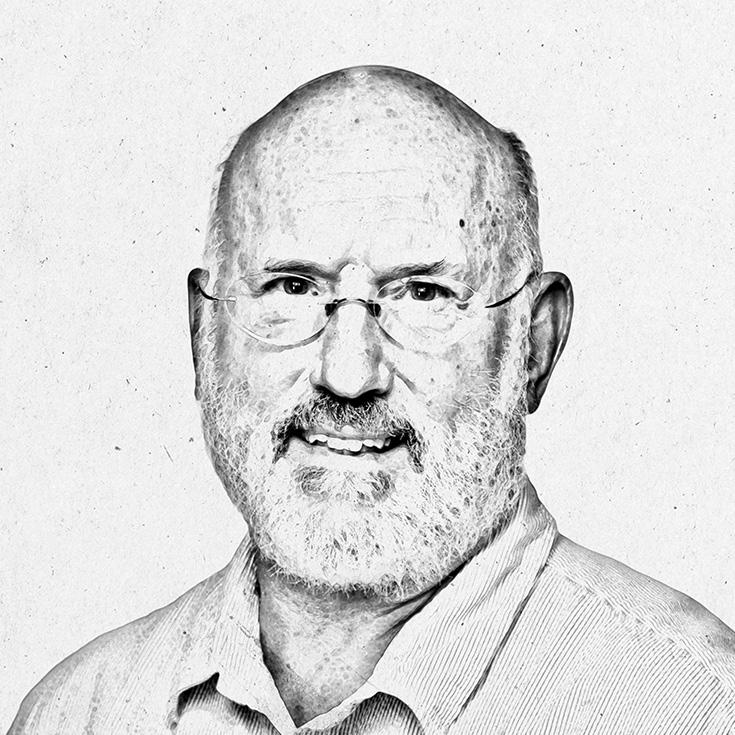
39 Years
Since arriving at Poly in 1986, Gerry Stone has played many pivotal roles— English teacher, Upper School dean, coach, mentor, summer school director, and Commencement announcer—but what remained constant was his deep commitment to students and his love for the work. Stone served as an Upper School dean for 26 years, working with both Grade 9 and Grade 12 at various points, and led Poly’s summer school for a decade. He’s perhaps best known, though, for his legendary 32-year run as Boys’ Varsity Soccer Head Coach. Under his leadership, Poly secured Fairchester and Ivy Prep League titles, reached six NYSAIS finals, and earned back-to-back championships in 2007 and 2008. In total, his teams racked up 307 wins and countless memories. A 1981 graduate of Kenyon College and a
standout collegiate athlete himself, Stone brought intensity and care to every practice and classroom. “I poured into coaching,” he reflects, “but working one-on-one with students on their writing—that’s where I’ve felt most impactful.”
As an English teacher, Stone was known for his deep dives into Shakespeare and intensive reading classes that encouraged rich, inclusive discussions. Over the years, he witnessed changes in classroom dynamics and student collaboration, but what never changed was the strength of his relationships. “I’ll miss my colleagues,” he says. “The friendships I’ve built here are the most powerful part of it all.” Stone’s legacy lives on not just in Poly’s record books, but in the voices of students he challenged and championed for decades.
Gerry Stone
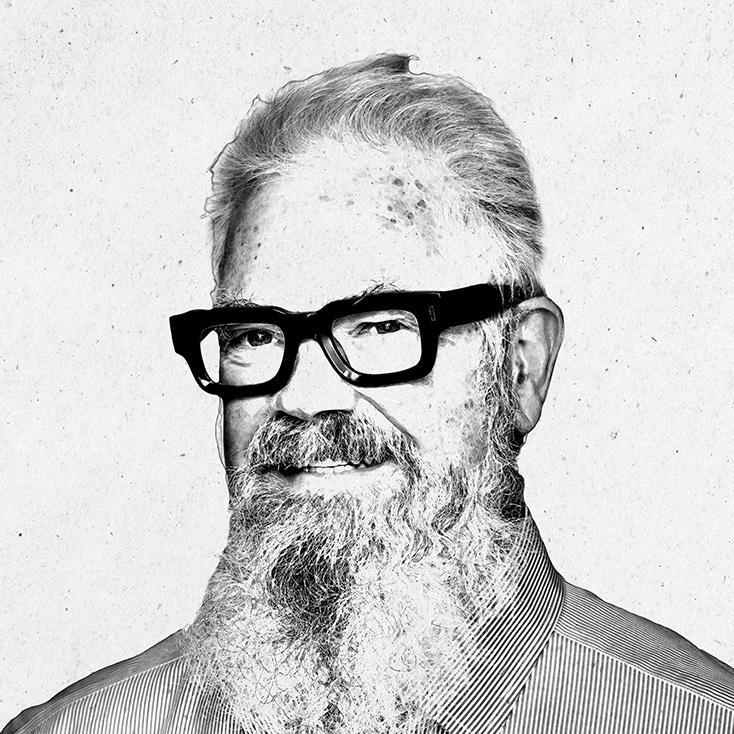
David Higham P’07 33 Years

Technical Theater Director David Higham has been at the heart of Poly’s theater program since 1992—and he’s the only one we’ve ever had. Prior to his arrival, set and lighting design were handled informally by faculty from various departments. His appointment marked the beginning of a new era, one defined by professionalism, mentorship, and a deep commitment to theatrical excellence. “David was my very first mentor when I arrived on the big campus part-time,” recalls Head of Arts Michael S. Robinson. “Those first years working with David set the standard for what an educational theater production could look like.” From the Chapel to the Richard Perry Theatre, Higham’s influence has been felt in every corner of the performing arts at Poly. Students have
learned to construct sets, run lighting boards, and take well-earned tech crew bows, thanks to Higham’s steady guidance and collaborative spirit. Whether painting sets late into the night or mentoring new designers, Higham created spaces—not just physical ones, but creative ones—where students and colleagues alike could thrive. “When you think about Poly theater,” Robinson adds, “it is David at the center of that space, process, and institutional care.” While Higham is stepping away from full-time teaching and theater management, we’re thrilled that he plans to continue lending his design expertise to Poly productions. His legacy, etched in sawdust, spotlight cues, and unforgettable performances, will remain a vital part of Poly’s story for years to come.

Ellen Martinez P’08, ’10 27 Years
With close to three decades of extraordinary service to the Poly Prep community, Ellen Martinez retires having worn countless hats: Spanish teacher, swim coach, advisor, committee member, and beloved colleague. “Ellen doesn’t just support her friends—she lifts them,” wrote longtime friend and fellow faculty parent Caesar Fabella P’18. “She is the one who quietly steps in when someone is in need, offering her time, her presence, and her fierce compassion.”
Known for her deep sense of fairness and integrity, Martinez has been described as a “moral compass” at Poly. In pivotal moments, she was a steady, courageous voice, always championing what was right. Her warmth and creativity touched every corner of campus whether teaching Spanish
with care and high standards, quilting T-shirts for colleagues, or making waffles in a fifth grade classroom to bring literature to life. “She listened carefully,” shared retired Poly faculty member Gail Karpf, “waiting for just the right moment to make her point.” To her students, Martinez was a presence. “Every day, students walk by and pound on the glass until she looks up and waves,” said World Languages Department Chair Liz Mansfield. “She embodies the term team player like nobody else.” As Health and Well-being Teacher Phoebe Aberlin-Ruiz P’30 reflected, Martinez has been a constant source of warmth and wisdom for all: her influence at Poly is immeasurable. While she may be retiring, her legacy—of candor, compassion, and community—will long endure.

Carolyn Licata 21 Years

Carolyn Licata earned her Bachelor of Science degree in mathematics from MIT and a master’s degree in mathematics from Clarkson University. She continued to study mathematics extensively beyond her graduate work, deepening her expertise throughout her career. Licata joined the Upper School mathematics faculty at Poly in 2004, where she initially taught Algebra II, Statistics, and AP Calculus AB. It wasn’t long before she was entrusted with the school’s most challenging courses. Over the past decade, she has taught Poly’s most advanced mathematics classes, including Advanced Calculus II (formerly AP Calculus BC), Advanced Statistics (formerly AP Statistics), and Linear
Algebra, as well as supervised independent studies in Multivariable Calculus. In addition to her classroom excellence, Licata served as Chair of the Mathematics Department, Upper School advisor, Math Club advisor, co-advisor to the Women’s Affinity Group, and a dedicated member of several faculty committees. In 2016, she was honored with a nomination for the University of Chicago’s Outstanding Educator Award by a former student. Beyond her academic accomplishments, Licata has been a mentor and friend to many. Her classroom was often filled with returning alumni eager to reconnect and thank her for the profound impact she had on their lives, both in college and beyond.
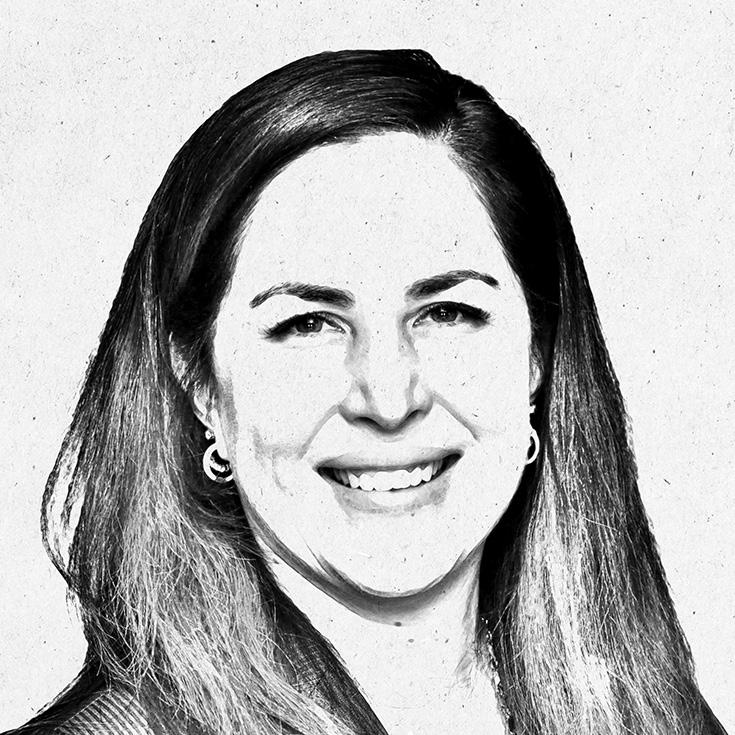
Lynda Casarella 10 Years
After nearly a decade at Poly, Lynda Caserella leaves behind a legacy of integrity, strategic vision, and deep care for the Poly community. In 2015, Casarella started as the Poly Summer Business Operations Manager and transitioned to the Business Office in the fall of 2019 as Controller. In August 2020, she was elevated to Interim Chief Financial Officer, taking on the role permanently in the following academic year. Casarella has played a pivotal role in shaping Poly’s financial future—guiding major initiatives such as the renovation of the backfields, construction of the Poly Arts Center, acquisition of the Ethical Culture building, a new faculty compensation model, and, above all, modernization and operational efficiency in the Business Office. “Lynda has been an invaluable ally,” reflected Interim Head of School John Rankin in a
letter to the Poly community. “Her steady guidance and high level of integrity have helped shape many of Poly’s most important strategic initiatives.”
A former military officer and seasoned financial leader, Casarella brought a wealth of experience to her role. While her impact on the school’s operations is undeniable, she’s most proud of the relationships she built along the way. “It’s the people I’ll miss most,” she shared. “The work is meaningful, but the people make it great.” Now settled in New Hampshire with her husband, Guy, and close to their new granddaughter, Casarella looks forward to a quieter pace of life—but will continue supporting Poly in an advisory capacity next year. We thank her for everything she’s done to strengthen and steward our community.
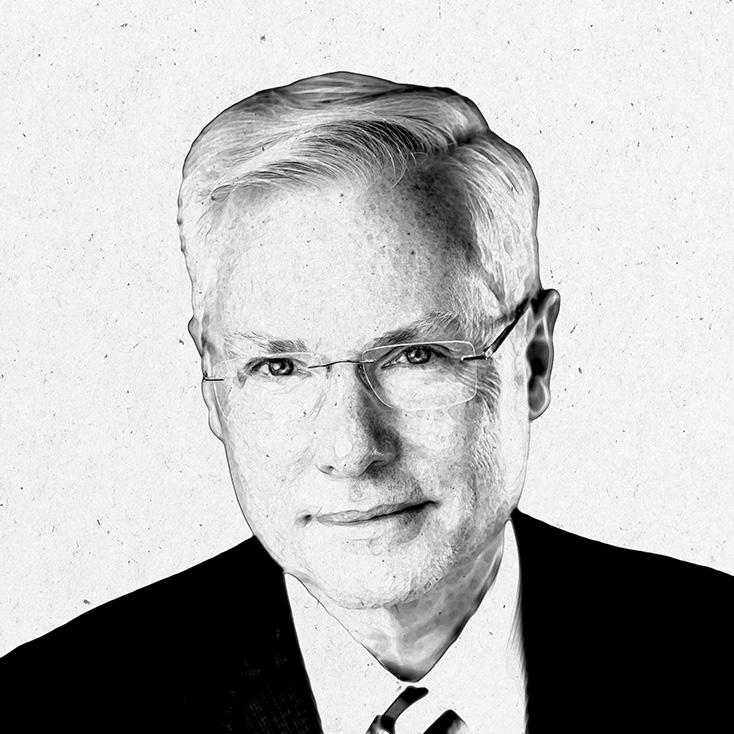
Keith Wiggs 5 Years

Keith Wiggs joined Poly’s Advancement Department in August 2020, bringing with him more than three decades of fundraising experience and a signature style marked by grace, wit, and generosity of spirit. With a career that began in New York City’s arts scene—including roles at Lincoln Center, The Juilliard School, and the Orchestra of St. Luke’s—Wiggs later turned his talents to educational advancement at institutions like Montclair State University, the Montclair Kimberley Academy, and the Elisabeth Morrow School. Poly became his third independent school and, in many ways, a professional home. In his five years at Poly, Wiggs played an instrumental role in elevating the school’s advancement efforts. He helped guide major projects, including the Poly Arts Center and athletic fields renovations, and consistently championed a relationship-based approach to fundraising.
“He has guided and supported all of us in our work,” his team shares, “emphasizing the importance of building genuine relationships with all of our constituents. His trust in us to take charge and own our work allowed us to flourish, as individuals and as a team. And he did it all with humor, style, panache, and the occasional finger wag.” As Wiggs prepares to retire this July after 36 years as a frontline fundraiser, he reflects with pride on his time at Poly and the community he’s helped to strengthen. We thank Keith for his invaluable support, leadership, and lasting impact. His contributions have laid a strong foundation for the future, and—while he’ll be missed—we hope a tropical breeze is calling his name.
WHAT WE’RE READING, LISTENING TO, AND WATCHING
The Outsiders
Stephen Bates US Math Faculty
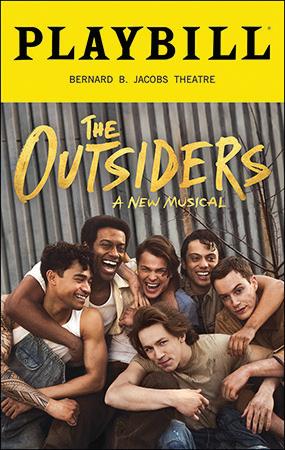
I saw a live performance of The Outsiders musical on Broadway a few weeks ago. This is the classic story of the Greasers and the Socs and the tumultuous relationship between the two rival groups. Seated in row 2, I was privy to an immersive experience by getting gravel kicked onto myself multiple times and getting splashed by the rain in the main fight scene. The music is catchy, the acting phenomenal, and the story is one that we all know from English class. I would highly recommend this musical to anyone and, for me, it ranks up there with Hamilton . I have not been able to stop listening to the official soundtrack since leaving the show.
Carter
Vail
Erin White MS Science Faculty
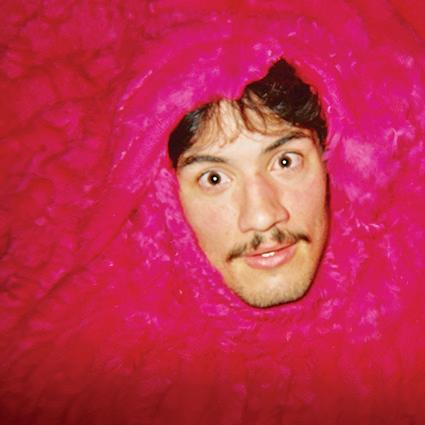
If you haven’t started listening to Carter Vail yet, check him out sooner rather than later. This occasional YouTuber might be best known for his viral “Dirt Man” song clip (and, more recently, his Silk Vanilla Almondmilk® ads) but his actual, nonTikTok-slated music is worth a try. Carter spans a few genres, floating somewhere between indie rock, country, and pop music. Fans of Cake, Foster the People, or Phoenix will enjoy his stuff: there are quite a few teen anthems waiting to happen here. Plus, he puts on a fantastic concert—10/10, I would go again. I recommend starting with “Harder to Kill,” “I Don’t Wanna Talk,” and “Space Is Lonely, That’s Okay!” to get a good idea of his range. Please give him a listen so I finally have someone to talk to about how good this music is!
All Creatures Great and Small
Erin Hughes Associate Director of Major Gifts

The best show on TV right now is All Creatures Great and Small , airing on Channel 5 in the U.K. and PBS in the U.S. Over five seasons, the show has brought
viewers to circa WWII Yorkshire Dales, one of the most beautiful places on Earth that I didn’t know about before January 2021. The show caught on because it was cozy (or cosy, for U.K. viewers) in a time when the world was not. Succession this isn’t, because nearly every character we meet in this adaptation of James Herriot’s classic books about his life as a veterinarian in the fictional town of Darrowby is trying their best to be a good person. The show isn’t cozy because it lacks drama, it’s cozy because the drama is very human in scale, and because we know that our characters are going to do what’s best for the greater good.
An earlier adaptation of Herriot’s books aired in the late 1970s, but this series remake has expanded the women’s roles and created two strong characters in James Herriot’s eventual wife, Helen Alderson, and the stalwart housekeeper of Skeldale House, Audrey Hall. In the three principal male characters—James, his boss Siegfried Farnon, and Siegfried’s younger brother Tristan—the writers have emphasized tender masculinity. These are men who aren’t ashamed of their love for their family, their friends, or each other. Watching them from a world that is often hard and cruel, the strength of family does indeed feel cozy.
Her Story (好东西)
Chenyi Zhou MS Mandarin Faculty

Her Story (好东西), directed by Shao Yihui, is a standout Chinese comedy-drama that has sparked widespread discussion since its release. The film revolves around two
compelling female protagonists: Wang Tiemei, a single mother navigating the complexities of life and work, and Xiao Ye, a spirited young woman entangled in her chaotic relationships. Their unexpected friendship begins when Xiao Ye becomes a babysitter for Tiemei’s daughter, Moli. The narrative cleverly intertwines themes of imperfect love, resilience, and the messy yet beautiful process of rebuilding lives.
What sets Her Story apart is its unapologetically feminist lens, addressing societal issues like menstruation stigma, sexual consent, and family dynamics with humor and poignancy. Its layered storytelling and nuanced characters resonate deeply with viewers—especially women who see reflections of their own struggles and triumphs. However, its feminist perspective has drawn polarized opinions, with some critics dismissing it as overly one-sided or reductive. Nevertheless, Her Story remains a cultural milestone, showcasing the increasing prominence of female directors in Chinese cinema and sparking meaningful conversations about gender roles, societal norms, and the power of women’s voices. It’s a must-watch for its thought-provoking narrative and its celebration of the strength and agency of women.
The Handmaid’s Tale
Sophia Taylor ’25

Margaret Atwood’s The Handmaid’s Tale is a haunting and thought-provoking dystopian novel that feels disturbingly relevant. Set in the totalitarian Republic of Gilead, it follows Offred, a handmaid whose only role is to bear children for the ruling
elite. Stripped of her rights and identity, she navigates a world where women are treated as property, constantly grappling with fear, memory, and the quiet urge to resist.
Atwood’s writing is sharp and poetic, revealing Gilead’s horrors through Offred’s intimate and often fragmented narrative. The novel doesn’t rely on over-explaining its world, but instead lets details unfold naturally, making the reader piece together the full picture. What makes it even more chilling is that nothing in Gilead is pure fantasy—Atwood based every element on real historical events and practices.
While the novel is heavy and at times slowmoving, its themes of oppression, power, and resistance make it deeply compelling. It’s not just a dystopian story; it’s a warning and a mirror reflecting society’s darkest possibilities. If you enjoy unsettling but thought-provoking fiction, The Handmaid’s Tale is well worth the read. Just be prepared: it lingers in your mind long after you’ve finished.
Arcane
Bennett Ling-Regan ’28
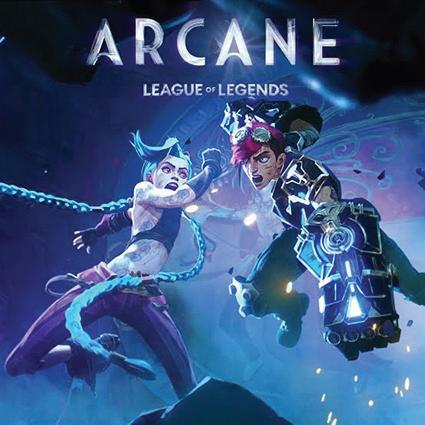
There is a pervasive idea that animation is for children, that it is immature and lacks emotion and complexity. Arcane proves that all wrong.
Based on the game “League of Legends” (no, you don’t need to play it) and made by animation studio Fortiche, Arcane season one received four primetime Emmys. While award season has yet to come for season two, it is the only show in IMDb history to have every episode rated above a nine out of ten.
Arcane follows two sisters turned enemies, Vi and Jinx, as they navigate the two fantasy cities, Piltover and Zaun. Born in Zaun, the poor undercity, the sisters are caught in the middle of a revolution against the rich Piltover. They are driven apart on different sides of a war. While Jinx becomes a wild terrorist face of the revolution, Vi is stoic, doing her best to stop the younger sister she no longer recognizes.
It isn’t just the sisters who come alive, it’s all the characters surrounding them. There is Caitlyn, the noble-born officer; Jacye, a brilliant inventor faced with the consequences of his science; and Viktor, Jayce’s apprentice, pushing the same science to its limit. The show tackles the lines between right and wrong while keeping viewers on the edge of their seats with a riveting story full of action.
Arcane pushes the boundaries of television with stories, music, and art. The most emotional scenes are highlighted by animation styles ranging from faded nostalgic water color to bright, colorful crayon lines. The music is sure to make either the heart swell, with masterpieces such as “Isha’s Song” in Chinese, by Easan Chan, or “Ma Meillure Ennemie,” by French artist Stromae.
With a heartfelt story, graphics that belong in a museum, and a soundtrack better than most popular albums, Arcane is sure to capture the attention and adoration of anyone doubting it as the future of storytelling.
50
60
Victor Rich ’57 sees classmates Fred Shwom and George Malin on a regular basis, often for lunch or dinner and sometimes with spouses.
Steve Robinson ’62 has been an award-winning architect, a land-use planner, and a community activist in New York and New Mexico since 1985. His recently published book is TURF WAR: How a Band of Activists Saved New York from Donald Trump’s “Masterpiece.”
70
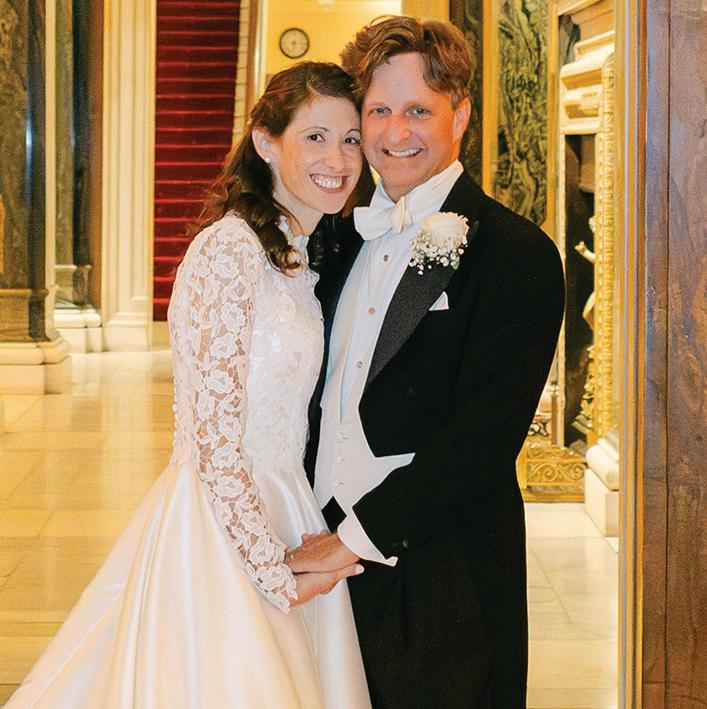
Ward V.B. Lassoe ’78 I wrote a book that was published on December 12, 2024. It is titled Diane: True Survivor and is available on Amazon.com. I was the first fourth-generation student to graduate from Poly. My dad, grandfather, and great-grandfather all went there before me. My great-grandfather graduated exactly 100 years before me: he was in the class of 1878!
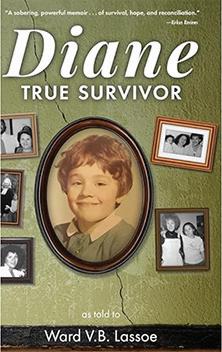
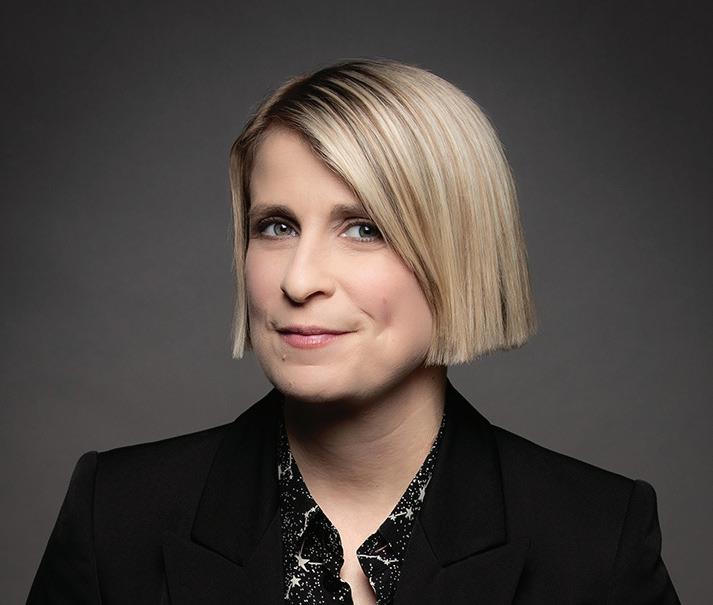
90
Award-winning producer
Liz Feldman ’95 created a recent Netflix limited series show, No Good Deed, that premiered in December 2024.
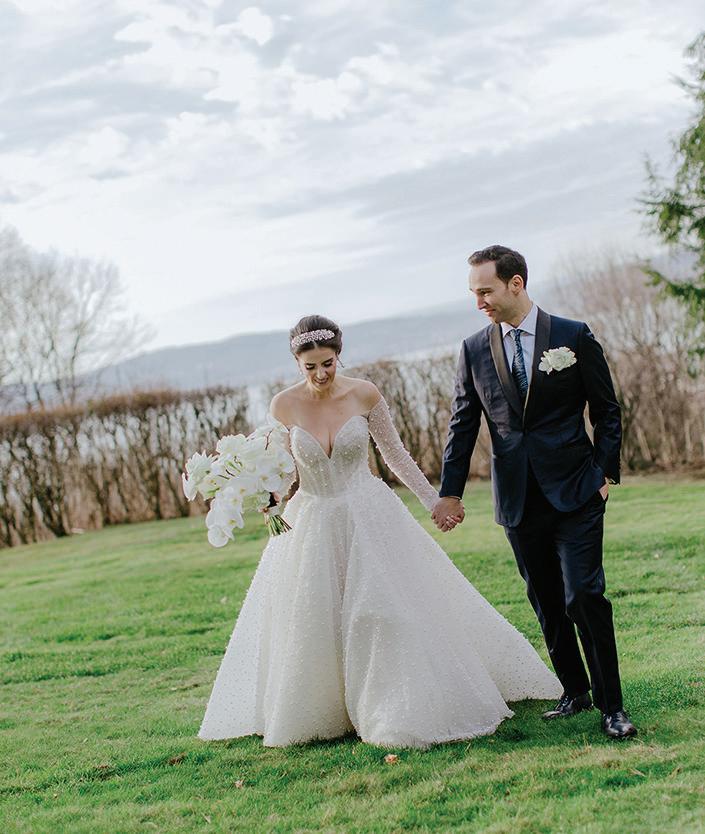
Bobby Underwood ’05
Lara Mackenzie ’95 is thrilled to announce her marriage to Charles Rudd Mackenzie, Esq. The ceremony took place on October 19, 2024, at St. Bartholomew’s Church in New York City, and the reception was held at The University Club. The new Mr. and Mrs. Mackenzie honeymooned in Grand Cayman. 00
We celebrated our wedding on New Year’s Eve (2024) at Tappan Hill Mansion in Tarrytown, NY. My wife, Siobhan D’Angelo—now Siobhan Underwood—is an assistant district attorney in the Manhattan D.A.’s office. Two of my groomsmen were fellow Poly alumni: Gil Abadi ’04, who was my best man, and Matthew Richman ’08.
Fabiana Kreines ’08 is finishing her urogynecology fellowship at the University of Pennsylvania. 10

Drew Lewis ’14 was inducted as an executive board member, director of fundraising, of the National Black Prosecutors Association’s NYC Sterling Johnson Chapter.

Brigid Regan ’14 and Eddie Zaykowski ’15 were married on October 12, 2024, in Sag Harbor, NY. The bride and groom shared that it was an amazing day with many Poly Prep classmates and coaches there to celebrate with them (including Coach Zukauskas all the way from Boston!).
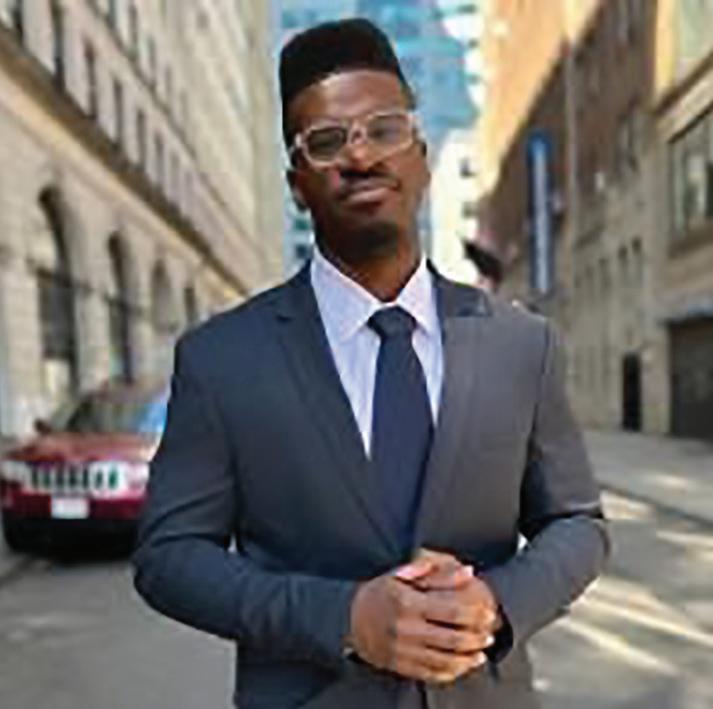
Ja mes Seaton ’15 received the Public Relations Society of America (PRSA-NY) 15 Under 35 award.

Amanda Grossman ’15 and George Henderson ’15 were married on July 19, 2024, at Liberty Warehouse in Red Hook, Brooklyn. Her maid of honor was Carly Corr ’16, and Claire Henderson ’20 was a bridesmaid. Alec Jones ’15, Theo Kruse ’15, and Zachary Grossman ’17 were groomsmen. Former Poly dance director Pam Pollock and her husband Eric were the Ketubah signers, and their children Lara, Gwen, and Josh were a junior bridesmaid, flower girl, and ring bearer, respectively. Other Poly attendees included Jair Froome ’15, Eddie Futterman ’15, Ethan Cohen ’15, and Mike ’71 and Adrienne Junsch P’91, ’92.
Robert Kollmer ’17 and Julia Khrakovsky ’17 were married on November 30, 2024, at the Parc Chateau in New Brunswick, NJ.

Ch anning Austin ’20 signed with the New York Mets organization and made his minor league debut with the St. Lucie Mets in the Florida Complex League.
Molly O’Connor ’20 received an Ostrander Award for Props Design in a Musical for the Rhodes Theatre Guild’s production of Amélie
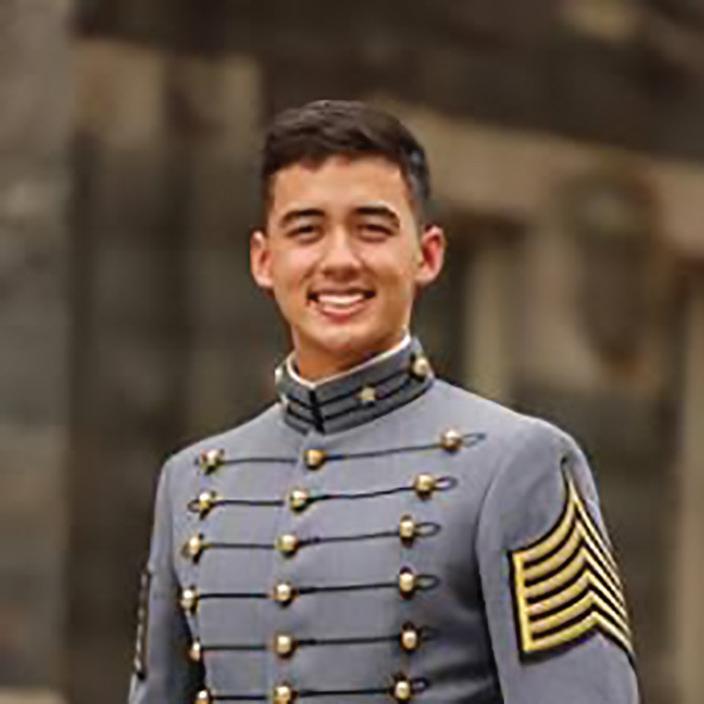
Shepard Dzina ’21 , a 2025 graduate of the U.S. Military Academy (West Point, NY), is named Rhodes Scholar and will study at the University of Oxford in the U.K. this fall.
Michael Gabriel ’24 received an Honorable Mention from the National Scholastic Press Association, one of the biggest journalism competitions, for his Polygon cartoon.
ADVANCEMENT OFFICE
Washington, D.C.
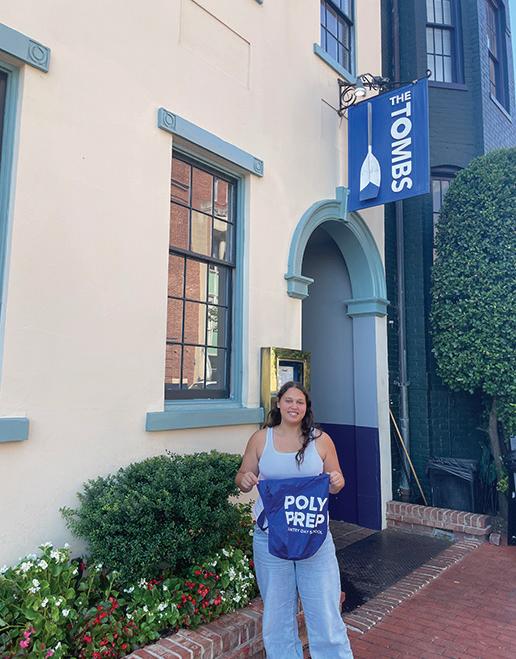

In September 2024, we connected with a few young alumni in Washington, D.C.

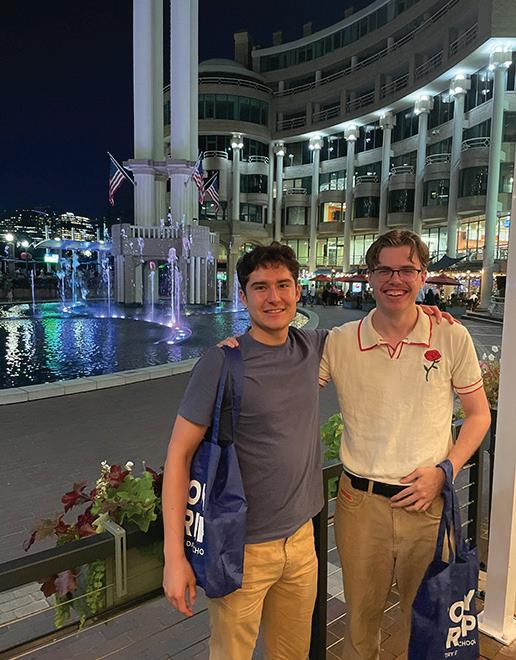
Lunch at The Tombs with Isabel Lagdameo ’21 and Xavier Stoldt ’22 (not pictured) outside of Georgetown University.
Daisy Neibart ’21 at the famous eagle statue at American University.
Dinner with Cosmo Oliveira Evans ’23 and Jasper Price ’21 near George Washington University.
Atiya Pope ’23 gave an amazing tour of Howard University.
ON THE ROAD
Holden Lipton ’22 (economics) University of Pennsylvania
Philadelphia, PA

University of Pennsylvania
From left to right: Brianna Kwan ’23 (computer science); Emily Ng ’21 (neuroscience; next, medical school); Danielle Jason ’24 (neuroscience); Jasmine Grant-Phillips ’24 (neuroscience); Laminu Diallo ’22 (finance)

In November 2024, we visited a few alumni living in and around Philadelphia, PA.
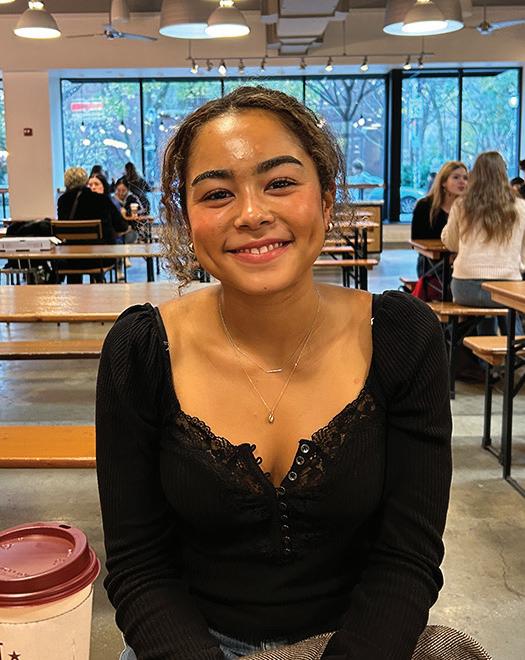
Selah Ilunga-Reed ’23 (political science and sociology)
University of Pennsylvania

Villanova University
From left to right: James Brandmeyer ’24 (finance); Billy Robb ’24 (finance); Luke Gustafson ’23 (engineering); Will Macleod ’23 (engineering).
Donald Crawford ’64 has been enjoying his retirement in Center City for the past 15 years. “It has been wonderful, filled with culture, restaurants, and not too far from NYC and the ‘new’ Brooklyn.”

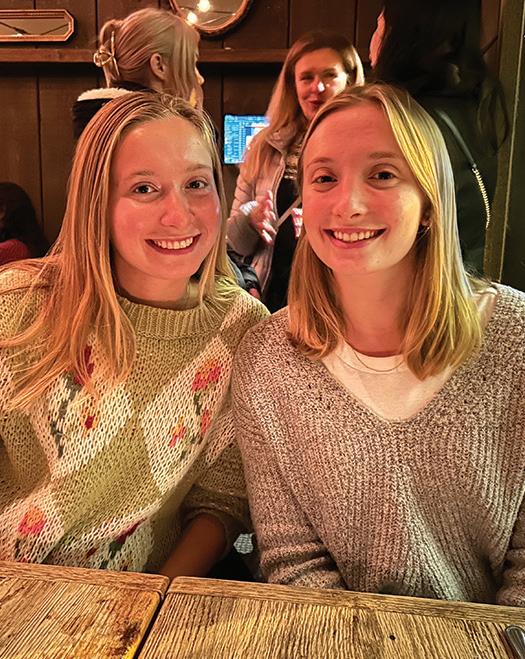
We caught up with Howard Place ’75, a leading orthopedic surgeon, veteran (West Point), and educator at St. Louis University. For many years, he and his wife would travel to the homeless shelters in St. Louis to provide free health services. He and his entire family are deeply involved in Catholic mission work, primarily with pediatric orthopedics in Malawi, Honduras, and several other developing countries. Howie hopes to retire in March 2025. He’s sorry to miss the 50th reunion for 1975—he and his wife are walking the Camino de Santiago, or the Way of St. James, starting in southern France and ending at the Shrine in Santiago, Spain.
Henry Warshaw ’72 along with Poly parent and Wash U alumna and board member Stacey Hightower hosted Gillian Nevins-Saunders ’24, William Howell ’23, Lucas Hunter ’23, Andy Fu ’23, and Kimberly Mark ’22
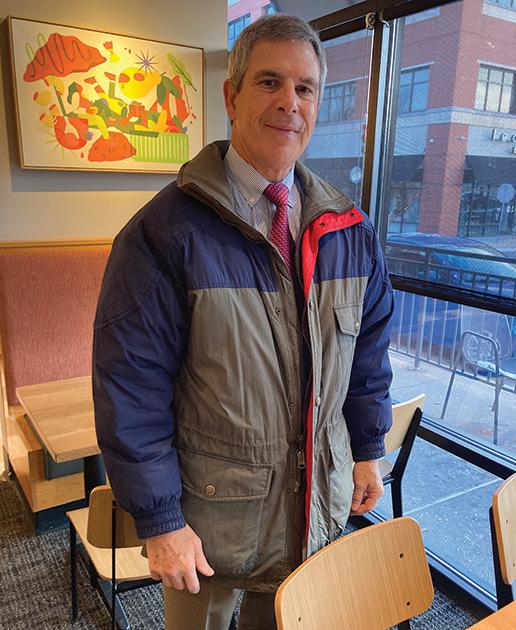
St. Louis, MO Boca Raton, FL

The 2025 South Florida Regional Luncheon was held at the Boca West Country Club in February.
Jenna Denaver ’20, and Jordan Denaver ’20 recently relocated to the City of Brotherly Love.
You Can Have It All.

Design a legacy gift that protects your estate and heirs, creates income, reduces tax liabilities—and helps future generations of Poly students.
Your legacy gift can accomplish many goals if planned properly. That’s why it makes sense to consider the Joseph Dana Allen Society
Named in honor of Poly’s longest-serving head of school, the JDA Society recognizes donors who have named the school as a beneficiary in their will, insurance policy, or retirement account. Charitable gift annuities, charitable remainder trusts, and the donation of non-cash assets are also practical options for alumni and friends.
Working with your financial planner, we can structure a legacy gift that will memorialize the values most important to you, maximize your philanthropic giving, and make a smart plan for the future. If you’ve already included Poly Prep in a bequest or other planned gift, please let us know so we can express our gratitude and recognize you for your generosity as a member of the JDA Society.
We’re happy to help you get started on a legacy gift to Poly Prep. Go to polyprep.mylegacygift.org or contact:
James Cappabianca Director of Major Gifts jcappabianca@polyprep.org
Erin Hughes Associate Director of Major Gifts ehughes@polyprep.org
Donna Muoio P’13, ’17 Director of Alumni Relations dmuoio@polyprep.org
polyprep.mylegacygift.org
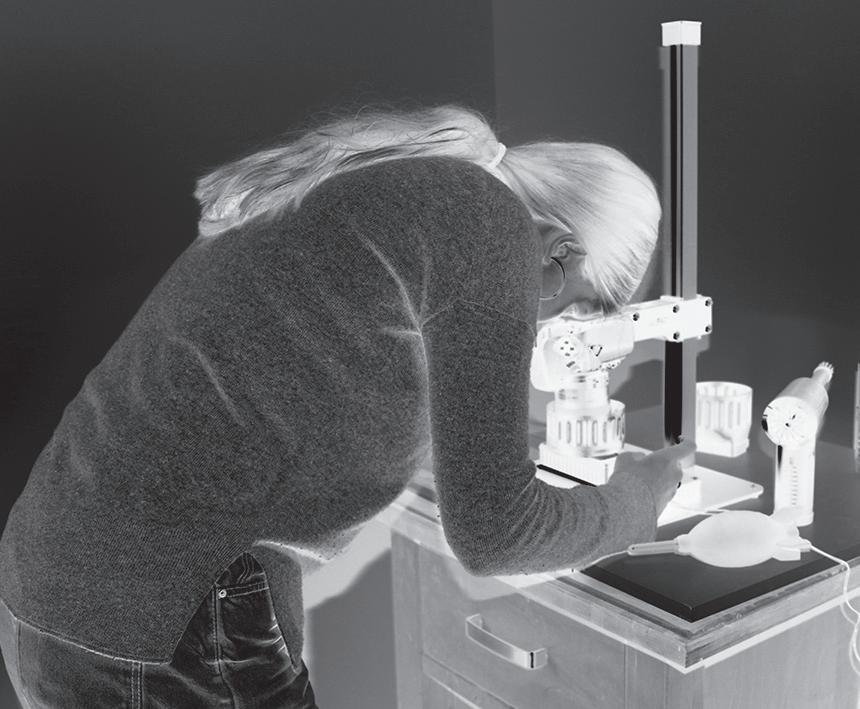
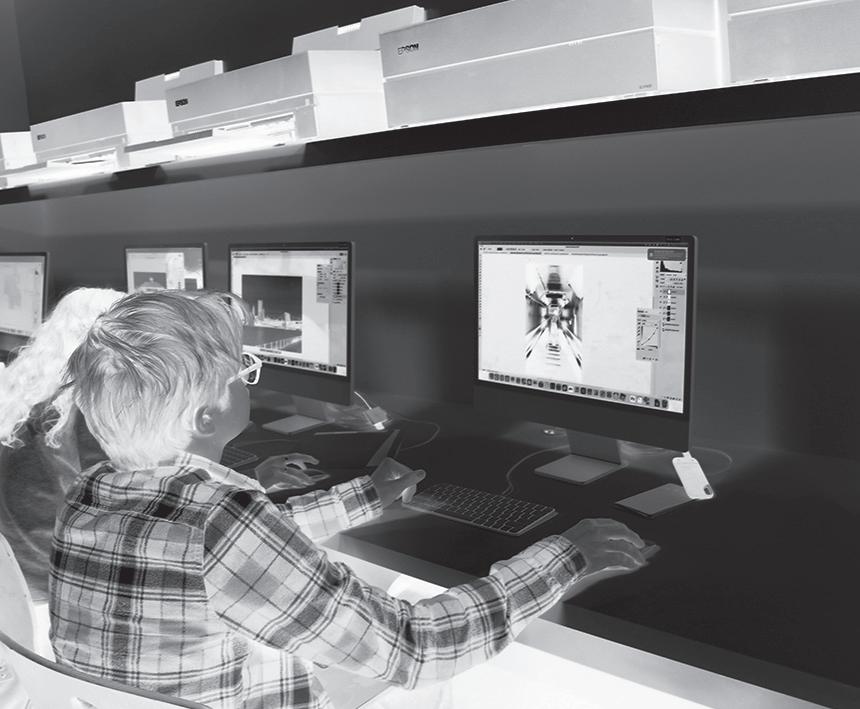

Legacy in Focus The Marrus Family’s Gift to a Poly Arts Education
Andrew Marrus and family established the Marrus Family Media Lab and Darkroom at Poly in memory of David Elias Marrus ’48 (1931–2022), honoring his passion for photography and dedication to philanthropy. Developed in collaboration with the Advancement office and the Charles ’52 and Valerie Diker Chair of Visual Arts Laura Beiles Coppola ’95, P’29, ’35, the facility features 20 advanced digital photography stations, each with its own large format printer. The gift also furnishes Poly’s first darkroom, set to open in late 2025. Andrew fondly remembers his father as an accomplished professional, published photographer, arts advocate, and loving parent who sought to nurture creativity in young people.
By Andrew Marrus
My dad always had very fond memories of his years at Poly Prep. He made and maintained friendships with a handful of guys that he stayed very close to for his entire life. What we know from the Poly records was that he was active in the newspaper and also helped manage the football team.

Academically, we believe most of Dad’s pursuits were in areas that he would have determined to be practical areas of study that would help him pursue a career in business or even possibly the family business. At the time, this included various companies involved in fabrics manufacturing, including men’s suiting and ticking, which was used to cover mattresses.
Following his graduation from NC State
Photo by David Marrus ’48
Students working on their photography in the new Marrus Family Media Lab.
and U.S. Army service during the Korean War, Dad returned home and found employment working for IBM. From there, he went on to work for the New York City Health Department, where we believe he conducted building inspections. This was all new to him and had nothing to do with textiles or the family business, but it helped pay the rent. Subsequent jobs led him to work in other areas of real estate development starting with the Urban Development Corporation, and then the International Basic Economy Corporation, where he traveled extensively in Central and South America, helping to develop commercial and residential housing projects.
In the late ’70s, Dad went to work for Starrett Housing and was dispatched to Iran, where he oversaw the development of various real estate projects prior to the fall of Mohammad Reza Shah Pahlavi, the last shah of Iran. Along the way, he started to take photographs of building projects and archaeological sites that he would visit during his travels and would return home with large bags of film that needed developing and printing. Around this time, he and our mother started to travel quite a bit more as well. Dad upgraded his camera equipment from a simple hand-held Leica to a larger format Hasselblad camera and large bag filled with film and lenses that Mom would often have to carry while he searched for the perfect image.
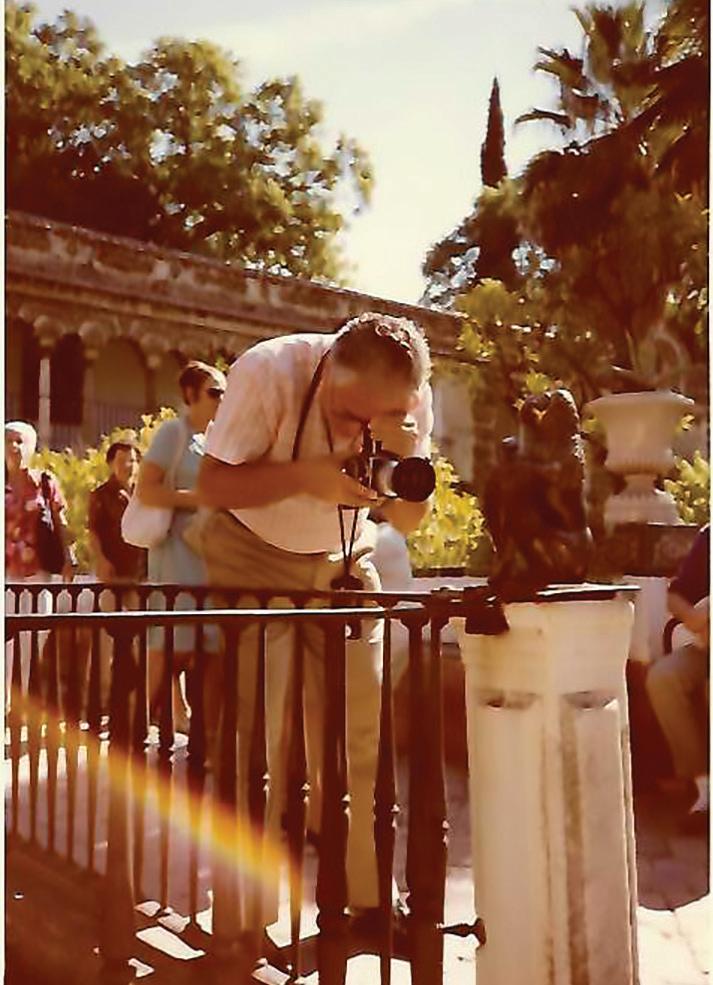

After his work in Iran, he returned to New York City full time, and opened up his own real estate development consulting firm, where his first large project was to construct the Museum Tower for the Museum of Modern Art on 53rd Street. That project launched him into a whole new career as a project manager for clients in the commercial, retail, and residential areas.
During this time, he and our mother started to travel yet again quite a bit, first in Europe and later in Asia. They also spent a lot of time traveling in the United States, particularly out West and into Alaska. And, everywhere they went, Dad would have this increasingly larger and larger bag of photography equipment to carry along.
In the 1990s, Mom and Dad also became collectors of vintage photography. Their collection was almost exclusively of blackand-white images initially focused on Western European street photography and later included photographers from the Far East, Eastern Europe, and Australia.
In the late ’90s, when their first grandchild was born, they began a tradition of gifting each child, grandchild, and daughter-in-law a vintage photograph for each birthday and anniversary. In this way, they began to share their love of photography with the rest of the family to the point where we now all have collections of images that—in Mom and Dad’s view—best aligned with our personalities. As the grandchildren got older, they were given the opportunity to select their own photographs from those that Mom and Dad had purchased over the years.
As Dad got more serious about his craft, he self-published two books of his photographs and worked quite closely with a professional printer who would consult with him at the end of each trip by reviewing contact sheets and images to select the best of the collection.
We are all quite fortunate to have several of my Dad’s images hanging on our walls and they all reflect his personality and the unique way in which he saw the world. Over time, he developed a keen eye for details, both as it related to landscapes as well as the physical features of people he encountered on my parents’ travels. It is important to note that my father was never formally trained and, given his family’s focus on pursuing a future in business, he would never have had the opportunity to take classes in the arts whether at Poly or subsequently at NC State.
He would’ve been very, very pleased to have the opportunity to support a larger and more robust photography program for Poly students so that they might develop their skills and their eye earlier in their careers than he had the opportunity to do.
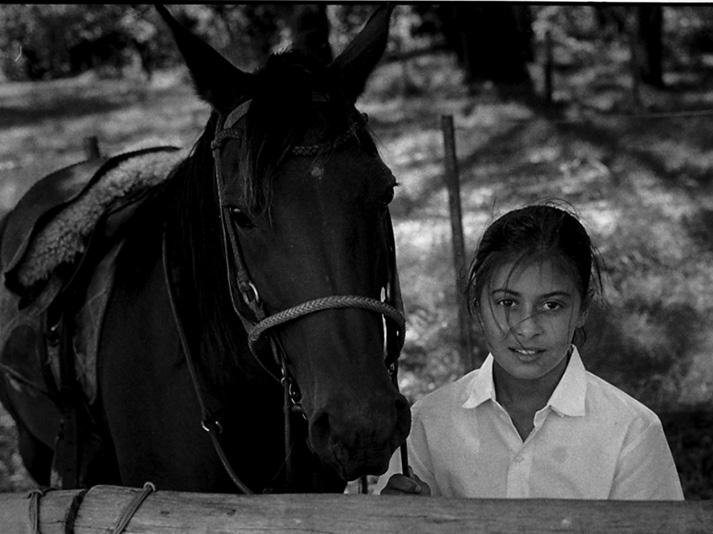
Photo by David Marrus ’48
David Marrus ’48 captures a scene through his viewfinder, 1980s.
Photo by David Marrus ’48

1940S
Robert “Bob” Theodore Schoepflin ’49 , age 91, of Allendale, NJ, was called to eternal rest peacefully at home on September 18, 2024, surrounded by his loving family. Born on September 29, 1932, in Brooklyn, NY, to Fred and Mildred (Engdoll) Schoepflin, Bob was a man of honor, integrity, and unwavering commitment to his family and community. He attended Poly Prep, graduating at age 16, and moved on to Lehigh University where he competed as a multi-sport athlete in soccer and lacrosse and graduated with a BS in economics and finance. Bob put himself through Lehigh by working full-time at the local Bethlehem Steel Mill during the summer months, and he continued his education earning advanced business management degrees from Harvard University and the University of Virginia. Professionally, he was a respected leader, starting his career with American Cyanamid, and later moved on to serve as a corporate executive at Union Camp Corporation and Conagra until retiring in 1995.
Bob was an Allendale resident for over 50 years, having moved there in 1969 with his wife and three children. He served as a member and president of the Board of Education at Northern Highlands Regional High School from 1976-1985. After retiring from corporate life, he was elected to and served Allendale’s town council for 15 years, nine of those as president. In his free time, he enjoyed spending time with his family, traveling the world, gardening, and attending Northern Highlands sporting events. Bob brought sunshine, a contagious laugh, and great intellect into every room he entered. He was quick with a joke or a wipe of a tear—and his generosity was unmatched. He made an indelible mark on this world and he never ended a phone call or letter without saying “Keep Smiling.” Bob was the loving father of Keith Schoepflin, Renée Schoepflin, Michael Halaburda, and George Schoepflin, and beloved grandfather to Karen, Jessica, Trevor, Carly, Parker, and Robert. He is reunited in spirit with his late wife, Diana (Maloof) Schoepflin.
With sadness we announce the passing of William A. Farren ’42 on April 3, 2025, at the age of 98. He loved his years at Poly and spoke often of the many happy times he spent there. William attended the 75th Reunion of the Class of 1942 and his son remembers him looking at the team photos and remarking, “It was all in the blink of an eye, and I enjoyed every minute of it.”
James S. (Jim) Blundell, Jr. ’47 passed away on January 19, 2025, at the age of 95. Jim was a New Yorker through and through, and a proud one at that. Chances are you saw him walking the streets of NYC or sitting on “his bench” in Central Park wearing a Poly Prep, Columbia University (’51), or New York Yankees hat, with a blue button-down, khakis, and Converse All Star sneakers. If you were lucky enough to spend time with Jim, you likely heard a few of his stories: from hiding out on a golf course as a kid in New Jersey and asking Babe Ruth to sign his baseball, lifeguarding on Jones Beach, and tales from his time in the service, to convincing his boss (as a buyer for JCPenney) that air conditioners would be popular.
He could recount traveling to all 50 states (and almost every capital!) with his wife Pamela and walking from midtown Manhattan to Brooklyn for a big steak at Peter Luger’s only to find out it was closed. He told things as he saw them and was inquisitive until the end. If you crossed his path, you became part of his story. Jim is survived by his beloved wife Pamela; his children, Suzanne, Stuart, and Maude; his grandchildren, Rick, Jessica, Lindsay, Marias, Matteo, Giacomo, and Shea; and his great-grandchildren Cal and Eve.
Peter Dyckman Fyfe ’47 of Lexington, VA, died peacefully on November 19, 2024. He was born in the Park Slope area of Brooklyn, NY, on September 19, 1929, the only child of Albert Edward and Marie Dumas Fyfe. He attended private and parochial schools, graduating from Poly Prep in 1947 and Union College in 1951, and then earned master’s degrees from both Columbia and Princeton University. After serving two years’ active U.S. Army duty at White Sands, NM, and in the Panama Canal Zone, Peter taught for over two years in Germany at universities in Freiburg, Hamburg, Strasbourg, Tübingen, and Göttingen. He taught English and Latin at the Berkshire School in Massachusetts before teaching German at Virginia Military Institute (VMI) in Lexington for 10 years while, simultaneously, teaching Latin at neighboring Washington and Lee University for one year. Peter later taught German at the University of North Carolina (Cullowhee), and the University of Evansville in Indiana. He then worked in the Cataloging Division of the Library of Congress in Washington, D.C., specializing in Dutch, German, and other Germanic languages, until he retired and moved back to Lexington in 1996 where he still had many friends from VMI days.
In Lexington, Peter became involved in a number of volunteer activities. He served as secretary and a board member of Habitat for Humanity, volunteered for Rockbridge Area Hospice (now ConnectionsPlus) for almost 25 years, devoted his time in multiple ways at Grace Episcopal Church, and made food deliveries to the needy for the Meals for Shut-Ins program for several
Art by Alex Basham ’26
years. During retirement, Peter loved his dogs, continued to study languages, enjoyed listening to classical music— especially opera—and appreciated cooking, antiques, and a good cocktail in the evening. Peter leaves behind his cousins on his father’s side, Thomas Fyfe King and Gilbert S. King IV, of Ohio, and their wives, children, and grandchildren.
1950S
Robert William Stern ’51 , age 90, passed away on October 26, 2024.
The Rev. Ralph G. Groskoph ’54 passed away peacefully on September 27, 2024, at his home on Somerset Lake in Hancock, NY, at age 88. Born on September 15, 1936, in Brooklyn, NY, he was the only child of Ralph and Dorothy (née Andresen) Groskoph. Ralph was educated at Poly Prep and Cornell University, graduating with his bachelor’s degree in 1958. While at Cornell, he was the starting goalie on the men’s lacrosse team, and, after graduation, Ralph was commissioned as a second lieutenant in the U.S. Army. He served honorably for two and a half years with his last assignment being the commanding officer of a Nike air defense artillery battery
on Vashon Island, WA. He was discharged from the Army in 1961 with the rank of first lieutenant. Ralph and Elizabeth (Liz) were married on July 18, 1959, and, after he completed military service, they returned to New York where Ralph spent 25 years as a portfolio manager and bond trader on Wall Street. In the early ’80s, Ralph and Liz both felt the call to ordained ministry and began studies on nights and weekends while maintaining their secular careers and putting their own children through college. In fact, Ralph once quipped that all he had to do to get a seat on the Long Island Railroad was begin reading his Bible. They were both ordained in the same service in the spring of 1988 in the Episcopal Diocese of New York and moved to Wellsville, NY, shortly thereafter. For nearly 15 years, they served the six Episcopal churches in Allegany County, NY, retiring to their long-time summer home in Hancock, NY, in 2002. In retirement, Ralph worked with churches in the Binghamton and Sullivan County areas, and also served as a chaplain at the Family Foundation School in Hancock. Ralph is survived by his loving wife Elizabeth (May) of 65 years; his children John (Donna) of Summit, NJ, and Dr. Suzanne Maher (Jason) of Marblehead, MA; and by his grandchildren Jake, Shannon, and Sean Groskoph.

Gerald N. “Jerry” Sonnenblick ’54, Esq. , formerly a proud lifelong resident of Manalapan Township, NJ, passed away on February 24, 2025, at the Hawthorne Rehabilitation Center in Sarasota, FL, at the age of 87. He was born in Brooklyn in 1937, where he graduated from Poly Prep in 1954 before graduating from the Wharton School of the University of Pennsylvania at the young age of 19. Jerry was a member of the Rutgers Law School, Newark Class of 1964, and he founded his own law firm, Sonnenblick, Parker & Selvers, P.C., in 1977 in Freehold, NJ. Jerry was regarded as a preeminent land use and real estate development attorney throughout Monmouth County. Renowned for his smile, jokes, and storytelling abilities, he served as Manalapan Township Committeeman from 1969-1971, Manalapan Township Attorney between 1978 and 1984, and Monmouth County Library Commissioner from 1984-1999. A member of the Freehold Optimist Club throughout his career, Jerry’s hobbies included basketball, golf, bridge, poker, blackjack, NY Times crossword puzzles, science fiction novels, and reading multiple newspapers daily from cover to cover. He is survived by his adored wife of 54 years, Arlene; his children, Nicole (and husband Peter Licata); Patti, Mitchell, and Alan; as well as his grandchildren, Ashley and Claire Licata.
Paul Morton Brown ’55 , age 87, of Manhattan and Old Chatham, NY, passed away peacefully on February 11, 2025, holding the hand of his loving wife of 38 years, Ruth Shneider Brown. Born in Brooklyn on January 10, 1938, Paul attended Poly Prep where he made lifelong friends and excelled in sports, especially as a baseball pitcher. Upon graduation, Paul was offered a minor league contract by the Dodgers, and opted instead to pursue his education, receiving a BS in economics from the Wharton School in 1959 and a JD from Columbia Law School in 1962. While at Penn, Paul pitched for the baseball team and was a baseball camp counselor in the summer. Paul realized the wisdom of continuing his education when Willie Mays visited the camp and hit two monstrous blasts off his best fastball.
Art by Caroline Paradise ’27
After serving in the Army, Paul began his law career and became a distinguished corporate litigator as a founding partner of Whitman & Ransom, Parson & Brown. He continued his career at Satterlee Stephens after a firm merger, and then served as Counsel at Duane Morris until retiring in 2024. During his career he enjoyed numerous golf trips to the great American and European courses with colleagues and friends. He married Helga Fisher Olsson in 1963 and raised their family in Closter, NJ, where he was elected Borough Councilman and also served as its fire and police commissioner. Not surprisingly, he was also a Little League coach. He moved back to New York City after his divorce. Paul was an avid Brooklyn Dodgers fan until they moved to Los Angeles, when he then transferred his allegiance to the Mets, even attending a Mets Dream Week in Port St. Lucie in 1999 where he pitched his last innings. He was also a devoted fan of the Rangers, Giants, and Knicks. He met his wife Ruth on Fire Island and they married in 1986. Soon after they purchased a home in Columbia County, NY, where Paul enjoyed golfing, reading, chopping wood, and walking in the woods with his best pals, his Airedale Terriers. He was a long-time member of the University Club, the Old Chatham Hunt Club, and Columbia Golf and Country Club.

As a movie buff, Paul particularly enjoyed films by Mel Brooks and those starring Fred Astaire, Humphrey Bogart, and John Wayne. He was a great fan of Frank Sinatra, Tony Bennett, and Broadway musicals, and he would sing show tunes to anyone who would listen (or not). Paul will be remembered for his irreverent sense of humor, generosity, devotion to his family, and the joy he brought to everyone who knew him. He will be profoundly missed. Paul is survived by Ruth, his devoted daughter Stephanie and son William (Cynthia), grandson Bradley Legg, niece Jessica Brown (Jeff Allmon and children Hudson and Miles), and nephew Anthony Brown.
Dennis Mark Fox ’56 of Charlotte, NC, died on July 25, 2024, at age 85 after a brief illness. Dennis was born in Brooklyn, NY, to the late Milton and Annette Fox on November 9, 1938. He grew up in Manhattan Beach and graduated from Poly Prep in 1956, followed by Union College in 1960. He completed his education at Northwestern Law, and worked in New York as a lawyer in private practice for the next four decades. Dennis counted music among his earliest interests and throughout his life he could often be found playing the piano at social gatherings, or alone simply for his own pleasure. He was also an amateur pilot who loved aviation and spent many happy hours taking trips in his singleengine plane. He was always interested in psychology and in midlife became a follower of Buddhism and embraced meditation, practices that reflected his love for exploration and contemplation. He is survived by the children of his first marriage, Diana and Michael, and preceded in death by his beloved wife, Lyla. His life will be honored and remembered in the hearts of those he touched.
Stephen Raphael ’59 , age 82, died in New York City on September 12, 2024. He was born in Brooklyn on November 9, 1941, to Gladys Dorman and Benjamin Raphael, both lawyers. A graduate of Poly Prep, he earned a BA at Columbia University, a JD from Harvard Law School and a Master’s degree in tax law from New York University. After earning his law
degree, Stephen moved to Alabama where he taught at the University of Alabama and worked in support of the civil rights movement. Upon his return to NYC, he established a law firm, which later became Raphael and Marks, in partnership with his wife Ellen Marks. Throughout his life, Stephen was devoted to Brooklyn, both personally and professionally. A real estate developer who converted many brownstones in his beloved borough, he was foremost a preservationist at heart, serving as Commissioner to the Landmark Preservation Commission of New York City, legal advisor to the World Monuments Fund, a member of the Law Committee to the Municipal Art Society of New York, a member of the Board of Trustees of The City Club of New York, and a Poly trustee from 1996 to 2008. vStephen was further an adjunct professor at New York University, where he taught urban development and environmental law, and he was a long-standing member of the Century Association. Stephen is survived by his wife Ellen; his sons Adam and Fred; his stepchildren Andew and Gigi; his grandchildren Sophie, Sasha, Gabriel, Robin, Fiona, Jake, Lilly, and Sammy; and great-grandchild Emmett.
1960S
Richard Perry ’60 passed away at his home in Los Angeles, CA, at the age of 82. Richard was a generous alumnus, ongoing supporter of Poly, and proud son of Brooklyn. His impact on American popular music over the last half century has been profound. As the producer behind countless platinum records and career-defining albums, Richard created the soundtrack of a generation. Before the Richard Perry Theatre opened in 1989, theater performances took place in the Memorial Chapel. Richard’s gift to create a state-of-the-art theater facility represented more than just a new performance space—it embodied his belief in the transformative power of arts education and a dedication to ensure future talents would have the space to flourish.
Art by Aiden Paluszek ’28
Richard’s journey exemplified the artistic excellence and innovative spirit we strive to instill in every student. His extraordinary career spanned decades and genres, as he collaborated with legendary artists including Fats Domino, Ray Charles, Barbra Streisand, Carly Simon, Paul Simon, the Pointer Sisters, and Rod Stewart. As colleagues have shared in tributes, every project Richard touched reflected an unwavering commitment to excellence. The depth of affection for Perry among his classmates is clear. Jeff Robinson ’60 reflected, “He really made a difference in this world for good,” and joked, “Rich admitted he got his start as my lab partner in chemistry where he learned how to take over and direct the project.” His peers Alan Lane ’60 and Ronnie Rothstein ’60 echoed a common sentiment shared by the class at large: “We all loved him.” The Poly community celebrated his contributions, honoring him with the Alumni Board of Governors Distinguished Achievement Award in 1985 and the Alumni School Service Award in 1990.
Richard remains with us every time the curtain rises in the theater, every time a student discovers their artistic voice on our stage, and every time our community gathers to celebrate the performing arts. As we bid farewell to Richard—producer, visionary, philanthropist, and beloved alumnus—we remain profoundly grateful for his transformative contributions to our school. In this alone, he reminds us that we are first a community where ongoing connection lasts a lifetime.
Welbourne Frederick Bronaugh, Jr. ’61 of New Bern, NC, died on May 23, 2024. Born and raised in Brooklyn, NY, he grew up on East 24th Street. He graduated from Wake Forest University in 1965 and accepted a commission in the U.S. Navy, where he served for 28 years, reaching the rank of captain. While in the Navy, he discovered an aptitude for shiphandling, a skill which he continued after his retirement in 1992 by teaching others at Marine Safety International. There he rose to director of the Newport, RI, facility and eventually to international marketing director, before his second retirement in

2006 to North Carolina. He is survived by his wife, Lynda (McPherson); his two sons, Welbourne Frederick Bronaugh III and Stephen Michael (Shannon) ’92; and his grandsons, Liam and Timothy.
Robert Meringolo ’61 passed away peacefully, surrounded by family, on November 5, 2024, at the age of 80. Born in NYC to Louis Meringolo and Angela (D’Agastine) Meringolo, Robert attended high school at Poly Prep where he played football and lacrosse and was president of his class for all four Upper School years. He attended Brown University, earning a bachelor’s in human biology, and was a member of the squash club as well as elected president of his Delta Phi fraternity chapter. He continued his education at Jefferson Medical College (now the Sidney Kimmel Medical College), earning his MD degree, and then served his medical internship at Metropolitan Hospital, followed by his residency and fellowship at St. Luke’s Hospital, both in New York City. He later joined the U.S. Public Health Service, stationed in Washington, D.C., at the Department of Health, Education, and Welfare (HEW), and served a one-year tour in Vietnam as a lieutenant commander.
Robert moved to Rhode Island in 1976 where he started in private practice at Providence Cardiology. He later joined Cardiovascular Associates of RI and eventually became affiliated with South Coast Physicians Group. He was also a physician and medical director at The Rhode Island School of Design and was on staff at Miriam, Veteran’s, and Roger Williams Hospitals. He retired in 2017 as an associate professor of medicine and remained active in teaching students, residents, and fellows. After retiring, he facilitated the second-year cardiology course at Brown’s Warren Alpert Medical School. During his career, Robert was recognized as an outstanding teacher by his students and also volunteered at the Washington Free Clinic in Georgetown and the Rhode Island Free Clinic in Providence.
An exercise enthusiast who loved to travel, Robert counted among his favorite vacations a safari in Tanzania and a combination Galápagos Island and Amazon River tour. He had a lifelong commitment to education and continued to take nonmedical online courses regularly. He appreciated all that was given to him and tried to reciprocate, knowing that he
Art by Hannah Goldberg ’25
could not have succeeded without the love and support of his wife, family, and friends. Robert is survived by his loving wife Debra; children Claudia and Christopher Meringolo; stepchildren Courtney and Seth Menard; five grandchildren Brittany, Theo, Zion, Zavier, and Zakai; his brother Louis and nieces Michelle and Melissa; as well as his dear friends Marvin Cramer, Ed Wittels, and Kathy Higginbotham.
Col. Morton H. Levitt, M.D., ’64 , a beloved husband, father, grandfather, and friend, passed away peacefully at Liberty Commons Rehab on March 7, 2025, at the age of 78. He was born May 28, 1946, in NYC to Benjamin and Lillian Levitt (Bernard). From a young age during his education at Poly Prep in Brooklyn, Morton knew he would make a career out of math and science, despite his family’s storied history in real estate and law. His father
IN MEMORIAM

Patricia Tycenski Mastro
By Reese Roaman ’25
Patti Tycenski was—in every sense of the phrase—one in a million. As a long-time health teacher at Poly, she created an atmosphere where every student felt seen, safe, and celebrated. Her infectious energy touched everyone she encountered. In September, 2024, Tycenski passed away; however, the spirit and warmth she brought to Poly will remain forever.
was a judge and lawyer for over 60 years. His great-uncle was the founder of Levitt and Sons, creator of American suburbia and its post-World War II prefabricated housing developments in New York and Pennsylvania. He went on to further his education at Princeton University, earning a Bachelor of Science in engineering in 1968, and then Duke University Medical School, graduating with his Doctor of Medicine in 1972. He completed his postgraduate training at Duke Medical Hospital and the University of Chicago in anatomical and laboratory medicine in pathology.
In 1983, while at Methodist Hospital in Memphis, TN, Dr. Levitt met his wife Cindy and her two daughters. They became a family when they moved to Kansas City, KS, in 1985, shortly thereafter moving to Chicago while he finished his postgraduate
training. Dr. Levitt spent eight years with the U.S. Public Health Services, conducting research in pancreatic carcinogenesis at the National Institutes of Health, and then held executive roles at several hospitals before being recruited to the U.S. Air Force, specifically stationed at Andrews Air Force Base in Maryland from 1989-2003. Dr. Levitt served as Chair of Pathology and Laboratory Medicine and Deputy Director of Hospital Services, and he taught at Uniformed Services University of the Health Sciences. After retiring from the Air Force, Dr. Levitt embraced a career in Florida teaching the next generation of medical students. From 2003 to 2014, he taught as well as held senior leadership roles at Florida State University Medical School and Florida Atlantic University’s Charles E. Schmidt College of Medicine before retiring (again). While residing in Florida, he served both
Born in 1970 in Wynnewood, PA, near Philadelphia, Tycenski was a dedicated crew athlete who was recruited to Temple University’s first female crew team. She earned her master’s degree in exercise physiology from Temple and married Steven Tycenski in 1997. Together they had three children: Shane, Patrick, and Megan.
“Ms. Ty” began her career at Poly in 1995, initially running the fitness facility in the Jordan Center before teaching health classes in 1998. In 2001, she also became a Grade 6 dean. History teacher Caesar Fabella P’18 recalls how, during the 9/11 attacks, “Patti emerged as a beacon of reassurance,” helping students contact their parents and personally driving every Staten Island student home. “She knew every kid in a special way,” said health teacher and Ty’s best friend, Phoebe Aberlin P’30. “She could punish you, teach you a lesson, and make you walk out with a smile all at the same time.”
In 1997, Tycenski created the Poly Health interns program, where seniors mentored fifth and sixth graders. She conducted
leadership bonding retreats for the interns, sometimes inviting them to stay at her home. Alumnus Daniel Weinstein ’16 recalled, “The retreat to Ms. Ty’s house was one of the highlights of my senior year.”
Each October, Tycenski and the health interns raised awareness of breast cancer, creating the breast cancer bow tradition where students dressed in pink and gathered in the shape of a bow. Students connected with Tycenski through small gestures, like her collection of 100 rubber duckies gifted by students from around the world. She gave each homeroom student a “birthday duck” and themed ducks on special holidays.
As Interim Head of School John Rankin said, “Patti’s impact on our school and our lives is immeasurable. As we mourn her loss, let us also celebrate the positive influence she had on so many of us.” Poly will never be the same without Ms. Ty; however, it is also what it is because of her. Her legacy will continue to inspire and guide us for generations to come.
as board member and president of the Florida Society of Pathologists, and he was an active member of the College of American Pathologists, later being elected to its Board of Governors.
Dr. Levitt and his wife Cindy then moved to Wilmington, NC, where he joined the Cape Fear Men’s Club. He loved the camaraderie and activities and looked forward to the weekly get-togethers. Dr. Levitt’s journey on this earth was one marked by love, compassion, and friendship, and his passing has left a void in the hearts of his family, friends, and his faithful companion Flash, as he had a profound impact on those who had the pleasure of knowing him. Dr. Levitt is survived and missed by his wife Cindy Levitt of 39 years; his daughters and son-in-laws Nicole (James) Gordon, Tamara (Matt) Husman, and Lisa (Larry) Siegel; and, his four grandchildren Logan, Kai, Callie, and Maddy.
1970S
Stephen W. Flores ’70 , born on May 24, 1952, passed away on August 18, 2024, at the age of 72.
David B. Turret ’70 passed away peacefully on January 8, 2025, at his home in NYC. Born in New York on June 28, 1952, and raised by parents Jack and Rita, David was a brilliant and successful attorney, ruled by his ethics and passion for the law. He worked tirelessly in private practice for over 40 years, earning the admiration and respect of not only his partners and employees of the firm, but colleagues and adversaries alike. Notwithstanding the long hours he devoted to his career, David’s energy and enthusiasm for his family never waned. He also enjoyed skiing, tennis, and watching his sons’ sporting events. He was a kind and gentle soul who showed compassion and devotion to his many friends and extended family. He made his mark upon us and will be sorely missed. David is survived by his beloved wife Beth Santopolo; cherished sons Daniel (wife Jen) of White Plains,
NY, and Jason (wife Gina) of Boulder, CO; grandchildren Kaia, Luca, Charlotte, and Henry; older brother Ira (wife Josette) of West Palm Beach, FL; and nephew Jonathan.
1980S
Thomas J. Piccirillo ’80 passed away on December 27, 2024, at the age of 62 in Staten Island, NY, due to complications from diabetes. Born on January 28, 1962, in Brooklyn, NY, to the late Rudy A. Piccirillo and Elizabeth Piccirillo, Thomas’ life was a rich tapestry of artistic passion, community involvement, and an unwavering love for his family. A proud alumnus of Poly Prep, his academic journey led him to Hunter College, where he earned his BA in theatre in 1982, followed by a MA in theatre studies in 1984. His love for the stage and screen was evident from his days at Poly Prep, where he played quarterback and was a part of the school’s first undefeated season. His passion for acting blossomed as he starred in school plays like Fiddler on the Roof and Godspell . Thomas’ talent further shone as he transitioned to television and movies with memorable appearances in Heaven Help Us and The Last Boy Scout , and a recurring extra role on the soap opera All My Children . For over 30 years, he also shared his charm and skill as a server in fine dining restaurants in Bay Ridge, where his presence was a highlight for patrons and colleagues alike.
Beyond his artistic and professional endeavors, Thomas was deeply committed to Project Hospitality, a non-profit organization dedicated to providing essential services to those in need. He considered everyone there his work family, affectionately referring to them as “my guys.” An avid sports fan, Thomas’ loyalty was unwavering for Raiders football and New York Yankees baseball. He was a movie aficionado, too, and his favorites included classics like The Godfather, The Exorcist , and The Deer Hunter, reflecting his taste for storytelling excellence. Thomas was a guiding light in his family, cherished by his mother, Elizabeth; his daughter, Lauren Epifanio;
his brothers, Rudy and John; and his sister, Elizabeth Garry. He was a respected brother-in-law to Caroline, Olivia, and Patrick; a fun-loving uncle to Anthony, Rudy, Michael, Gulianna, and Patrick; and a doting great-uncle to Anthony Tepedino and Vincenzo Piccirillo. He held a special place deep in the hearts of everyone who had the privilege of knowing him.
Ezra Tawil ’85 , age 56, died January 23, 2024, of melanoma. Ezra was an early American literature scholar, cherished English professor, and director of graduate studies in the same department at the University of Rochester (NY). He had a knack for connecting with students, while his scholarly work helped define the “American style” of literature in fresh and exciting tones. Ezra is remembered as a teacher of substance with a style all his own, and, as director of graduate studies, he mentored students with warmth and humility in equal measure. His approach, colleagues say, enabled him to bond with students in a way that set him apart. Ezra is survived by his wife, Kirsten Lentz; a 13-year-old son, Jules; and his sisters, Adrienne, Robin, and Joyce.
1990S
Joseph Charles Panebianco ’92 lost his nearly 10-year battle with ALS on November 23, 2023 (Thanksgiving Day), at age 49. Joe distinguished himself as a leader at a young age by earning the rank of Eagle Scout in the Boy Scouts of America. At Poly, Joe was both a peer leader and a three-sport standout in football, basketball, and baseball—subsequently walking on to the top-ranked University of Miami football team. Joe was a passionate, committed, and accomplished musician living in New York City and San Francisco, CA, and he ultimately settled in Jacksonville, FL. He was a loyal friend to his Poly classmates, his Pi Kappa Alpha fraternity brothers, and many throughout Brooklyn. He is survived by his mother Shirley, sister Christine (’85), brother Richard, and nephew David. Joe was truly one of a kind and will be sorely missed by all who knew and loved him.
THE LAST WORD AN AGENT OF CHANGE
For the past two years, Lucia Zaremba ’25, has transformed family fear into public policy. What began as a mission to protect her brother, John ’29, has culminated in New York Gov. Kathy Hochul’s December 2024 signing of groundbreaking legislation requiring EpiPens in public venues across New York state. We first covered Lucia’s journey in our Spring 2023 issue, and now we return to hear from the young advocate herself.

Many people have great ideas for change in their communities, but few take the step of proposing legislation. What was the process like?
[It] started at my dining room table a couple of years ago. My family and I stumbled into a discussion about my brother’s allergies … about the big “what if?” What if we didn’t have an EpiPen the day John went into anaphylactic shock? What if he wasn’t at home with his family? The answer to this hypothetical question was the sad reality for millions of people across America: that he may not have survived. It felt like common sense that EpiPens should be available in public spaces. My family and I reached out to local New York State Sen. Andrew Gounardes (D) 22nd District, who was more than willing to help. We met with him and his team, and our vision slowly
grew into a reality. Since [then], my role has mainly been as an advocate, educator, and social media presence, rallying support for the bill. This includes speaking on podcasts, doing news segments, and meeting elected officials and other allergy advocates to help build a coalition. One of my most memorable experiences was going to Albany to speak at a press conference, along with a team of allergy advocates, about this bill.
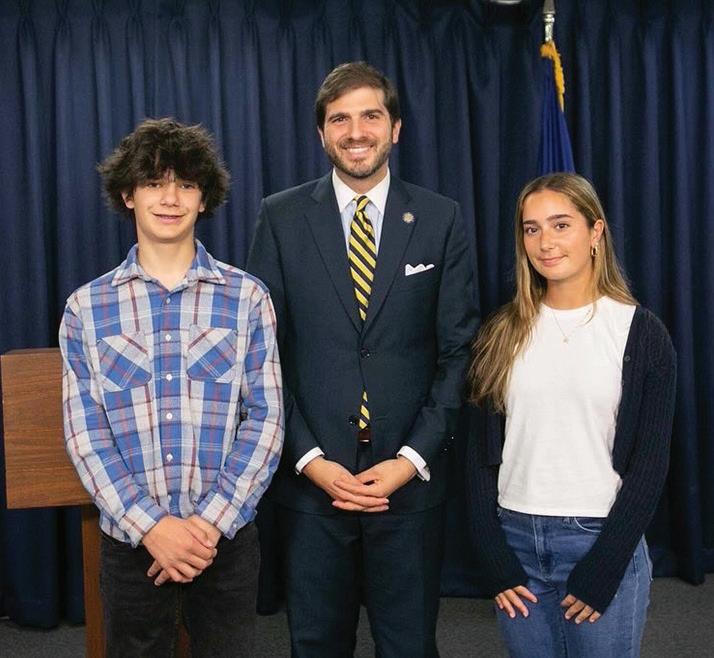
What gave you the confidence to do this?
I am blessed to have a family that has always told me anything is possible and to never give up. The combination of my parents’ support and my love for my brother, who suffers from severe allergies, gave me the confidence to do what I had once thought impossible. It was definitely intimidating, working with adults and trying to blend into that world. I often felt insecure about my age. Eventually, with the support of my family and Sen. Gounardes, I realized that my drive and passion was enough to earn the respect and attention of those around me. In fact, it was enough to pass a law.
Lucia ’25 and John Zaremba ’29 with New York State Senator Andrew Gounardes.
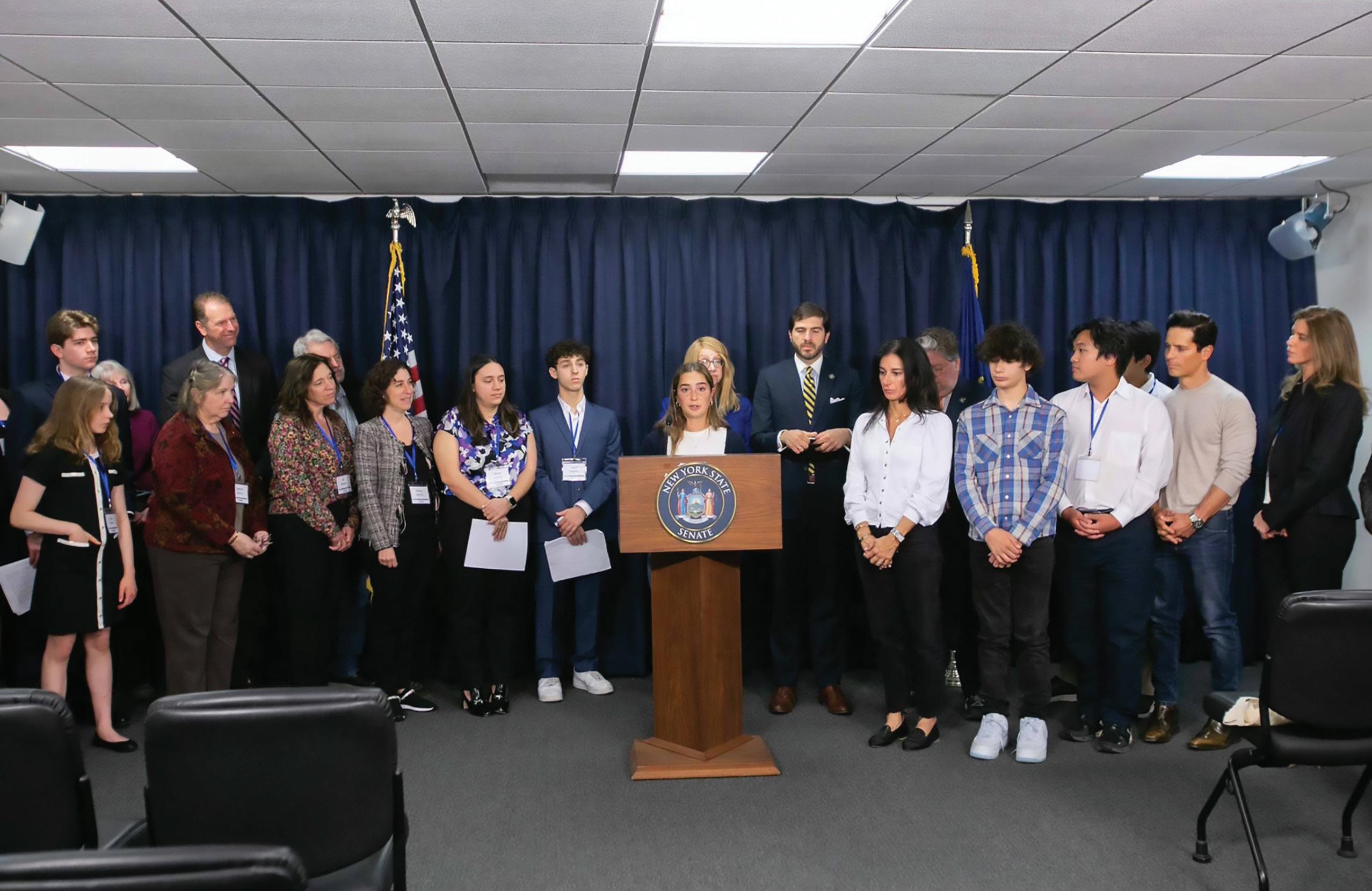
Were there any particularly challenging moments in the legislative process— and how did you overcome them?
On one call, I remember a speaker explaining how he lost his young son to a food allergy. My heart dropped, and I realized how truly lucky my family and I have been to have my brother still here. ... Another challenge I faced was a sense of insecurity and lack of belonging. Being surrounded by and working with well-educated, experienced, and accomplished adults was often intimidating ... I had to remind myself that my voice is just as important and meaningful. Once I overcame this fear, I realized that age is not a barrier. Instead, it is a tool. Because I am young, people saw me as a unique voice, something different.
Looking ahead, do you see public policy as a career choice or something with which you will continue to be involved?
Absolutely! I plan to major in government at Wesleyan University and, hopefully, will attend law school. This experience made me realize that I want to use my passion, platform, and education to continue helping others and push for systemic change. Specifically, I hope to help women fight for better wages.
What advice would you give to other students who want to transform their ideas into legislation?
Anyone is capable of producing meaningful change. To start, find something local that you want to change or improve for your community. Reach out to a local senator or assembly person and pitch your idea. Don’t be afraid of rejection! Keep pushing. Passion can take you further than you could ever imagine. Someone will hear your idea and recognize your passion, and invest in that.
THIS INTERVIEW BY JENNIFER SLOMACK WAS EDITED FOR LENGTH AND CLARITY.
Lucia addresses advocates in the New York State Capital in Albany, May 14, 2024.

DYKER HEIGHTS CAMPUS
